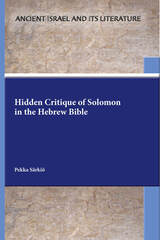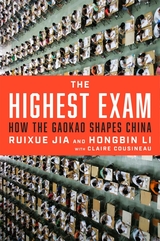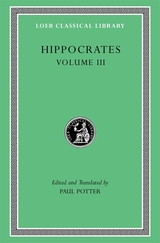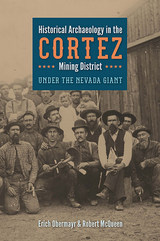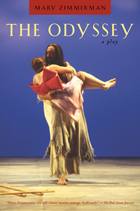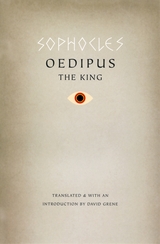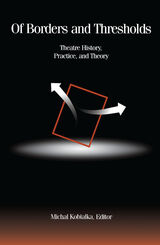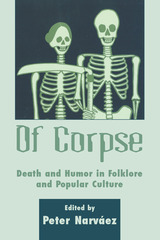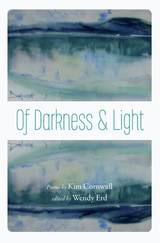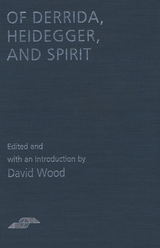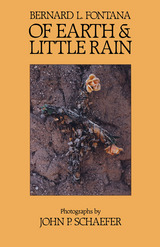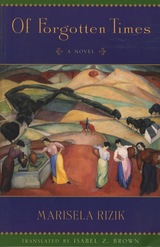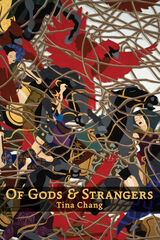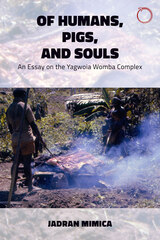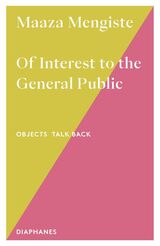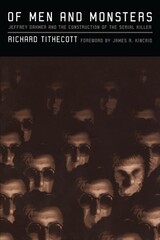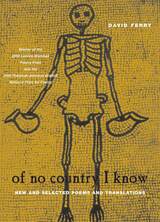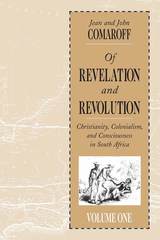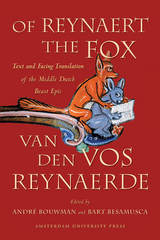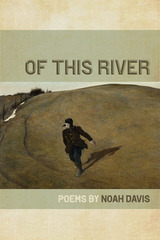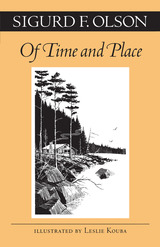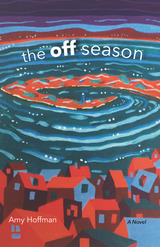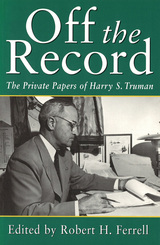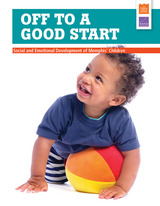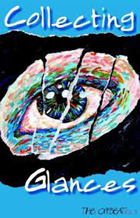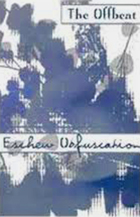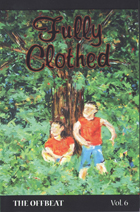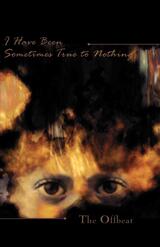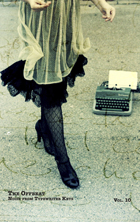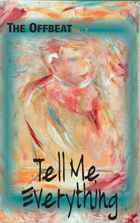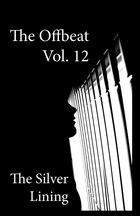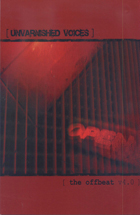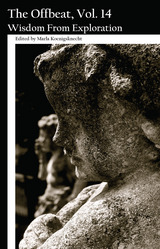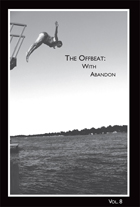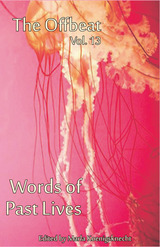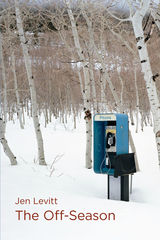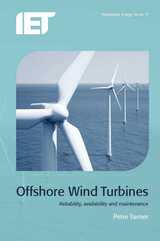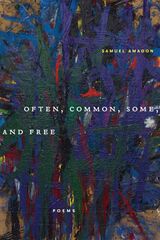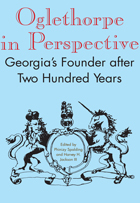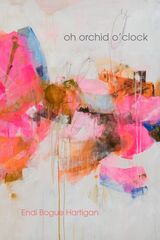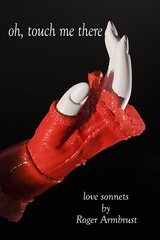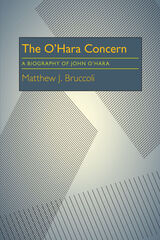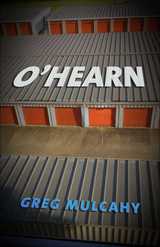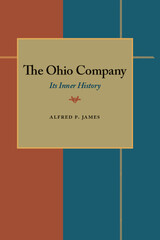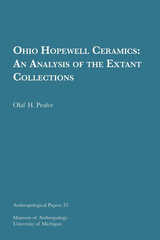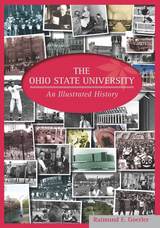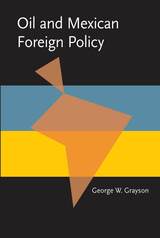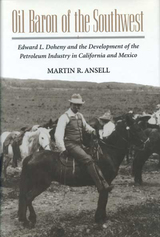 The Odyssey
Homer
University of Chicago Press, 2025 This is an audiobook version of this book.
A landmark new translation of Homer’s most popular epic by distinguished author and classicist Daniel Mendelsohn.
In 1961, the University of Chicago Press published Richmond Lattimore's translation of Homer’s The Iliad. For more than sixty years, it has served to introduce readers to the ancient Greek world of gods and heroes and has been one of the most popular and respected versions of the work. Yet through all those decades, Chicago never published a companion translation of the best-known epic in the Western canon, The Odyssey—until now.
With his new Odyssey, celebrated author, critic, classicist, and translator Daniel Mendelsohn has created a rendering worthy of Chicago’s unparalleled reputation in classical literature. Widely known for his essays bringing classical literature and culture to mainstream audiences in the New Yorker and many other publications, Mendelsohn eschews the streamlining and modernizing approach of many recent translations, focusing instead on the epic’s formal qualities—meter, enjambment, alliteration, assonance—in order to bring it to life in all its archaic grandeur. In this line-for-line rendering, the long, six-beat line he uses, closer to the original than that of other recent translations, allows him to capture each Greek line without sacrificing the amplitude and shadings of the original.
The result is a magnificent feat of translation, one that conveys the poetics of the original while bringing to vivid life the gripping adventure, profound human insight, and powerful themes that make Homer’s work continue to resonate today. Supported by an extensive introduction, notes, and commentary, Mendelsohn’s Odyssey is poised to become the authoritative English-language version of this magnificent and enduringly influential masterpiece.
The Odyssey: A Play
Mary Zimmerman
Northwestern University Press, 2006 With her trademark irreverent and witty twist on classic works, Zimmerman brings to life the story of Odysseus's ten-year journey This dramatic adaptation of Homer's myth begins with a modern young woman who is struggling to understand Robert Fitzgerald's translation of The Odyssey. A classical muse appears, and the young woman becomes the goddess Athena--a tireless advocate for Odysseus in his struggle to get home. Zimmerman's adaptation depicts his encounters with characters such as Circe, the Cyclops, Poseidon, Calypso, the Sirens, and others in new and exciting ways.
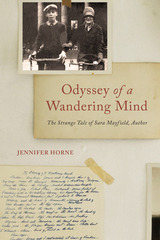 Odyssey of a Wandering Mind: The Strange Tale of Sara Mayfield, Author
Jennifer Horne
University of Alabama Press, 2024 A carefully rendered portrait of a brilliant but troubled daughter of the Old South who struggled against the conventions of gender, class, family, and ultimately of sanity, yet survived to define a creative life of her own
Sara Mayfield was born into Alabama’s governing elite in 1905 and grew up in a social circle that included Zelda Sayre, Sara Haardt, and Tallulah and Eugenia Bankhead. After winning a Goucher College short story contest judged by H. L. Mencken, Mayfield became friends with Mencken and his circle, then visited with Scott and Zelda Fitzgerald and hobnobbed with the literati while traveling in Europe after a failed marriage. Returning to Alabama during the Depression, she briefly managed the family landholdings before departing for New York City where she became involved in the theater. Inventing a plastic compound while working on theatrical sets, she applied for a patent and set her sights on a livelihood as an inventor and businesswoman. With the advent of World War II, Mayfield returned to her family home in Tuscaloosa where she expanded her experiments, freelanced as a journalist, and doggedly pursued a bizarre series of military and intelligence schemes, prompting temporary hospitalization. In 1945, she mingled with a host of cultural figures, including Frida Kahlo, Diego Rivera, Orson Welles, Rita Hayworth, and even a young John F. Kennedy, while reporting on the creation of the United Nations from Mexico and California. Back in Tuscaloosa after the war, however, she struggled to find her way with both work and family, becoming increasingly paranoid about perceived conspiracies arrayed against her. Finally, her mother and brother committed her to Bryce Hospital for the Insane, where she remained for the next seventeen years.
Throughout her life, Mayfield kept journals, wrote fiction, and produced thousands of letters while nursing the ambition that had driven her since childhood: to write and publish books. During her confinement, Mayfield assiduously recorded her experiences and her determined efforts—sometimes delusional, always savvy—to overturn her diagnosis and return to the world as a sane, independent adult. At 59, she was released from Bryce and later obtained a decree of “having been restored to sanity,” enabling her to manage her own financial affairs and to live how and where she pleased. She went on to publish noteworthy literary biographies of the Menckens and the Fitzgeralds plus a novel based on the life of Mona Lisa, finally achieving her quest to become the author of books and her own life. In Odyssey of a Wandering Mind, noted writer Jennifer Horne draws on years of research and an intimate understanding of the vast archive Sara Mayfield left behind to sensitively render Mayfield’s struggle to move through the world as the person she was—and her ultimate success in surviving to define the terms of her story.
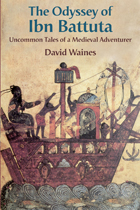 The Odyssey of Ibn Battuta: Uncommon Tales of a Medieval Adventurer
David Waines
University of Chicago Press, 2010 Ibn Battuta was, without doubt, one of the world’s truly great travelers. Born in fourteenth-century Morocco, and a contemporary of Marco Polo, Ibn Battuta left an account in his own words of his remarkable journeys, punctuated by adventure and peril, throughout the Islamic world and beyond. Whether sojourning in Delhi and the Maldives, wandering through the mazy streets of Cairo and Damascus, or contesting with pirates and shipwreck, the indefatigable Ibn Battuta brought to vivid life a medieval world brimming with marvel and mystery. Carefully observing the great diversity of civilizations that he encountered, Ibn Battuta exhibited an omnivorous interest in such matters as food and drink; religious differences among Christians, Hindus, and Shia Muslims; and ideas about purity and impurity, disease, women, and sex. David Waines offers here a graceful analysis of Ibn Battuta’s travelogue. This is a gripping treatment of the life and times of one of history’s most daring, and at the same time most human, adventurers.
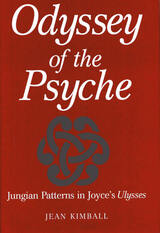 Odyssey of the Psyche: Jungian Patterns in Joyce's Ulysses
Jean Kimball
Southern Illinois University Press, 1997
The result of the interaction between Bloom and Dedalus, Kimball argues as a central tenet in her unique reading of Ulysses, is the gradual development of a relationship between the two protagonists that parallels C. G. Jung’s descriptions of the encounter between the Ego and the Shadow in that stage of his theoretical individuation process called "the realization of the shadow." These parallels form a unifying strand of meaning that runs throughout this multidimensional novel and is supported by the text and contexts of Ulysses.
Kimball has provided the first comprehensive study of the relationship between Jungian psychology and Joyce’s Ulysses. Bucking critical trends, she focuses on Stephen rather than Bloom. She also notes certain parallels—synchronicities—in the lives of both Jung and Joyce, not because the men influenced one another but because they speculated about personality at the same historical time. Finally, noting that both Jung and Joyce came from strong Christian backgrounds, she asserts that the doubleness of the human personality fundamental to Christian theology is carried over into Jung’s psychology and Joyce’s fiction.
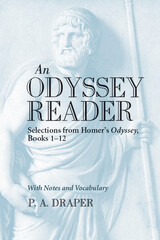 An Odyssey Reader: Selections from Homer's Odyssey, Books 1-12
P. A. Draper
University of Michigan Press, 2012 Homer's Odyssey has captivated readers and influenced writers and artists for more than 2,000 years. Reading the poem in its original language provides an experience as challenging as it is rewarding. Most students encountering Homeric Greek for the first time need considerable help, especially with vocabulary and constructions that differ from the more familiar Attic forms. For anyone who has completed studies in elementary Greek, this edition provides the assistance necessary to read, understand, and appreciate the first book of the Odyssey in its original language. Structured to maximize reading ease, P. A. Draper's volume stands out among introductions to the Greek Odyssey. Readers of this edition will appreciate the positioning of all notes facing the Greek text; the frequent vocabulary entries; the complete glossary; the appendix on basic Homeric forms and grammar; and the copious annotations on vocabulary, grammar, meter, historical and mythological allusions, and literary interpretation. Primarily designed as a textbook, this volume will be an effective classroom tool and a useful acquisition for any library supporting a classics program. The book will find readers among high school and college Greek students, advanced students in Homer or epic poetry classes, graduate students working on reading-list requirements, and anyone interested in maintaining Greek reading skills.
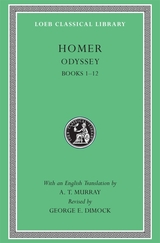 Odyssey, Volume I: Books 1–12
Homer
Harvard University Press, 1995 The hero’s journey home from war.
Here is a new Loeb Classical Library edition of the resplendent epic tale of Odysseus’ long journey home from the Trojan War and the legendary temptations, delays, and perils he faced at every turn. Homer’s classic poem features Odysseus’ encounters with the beautiful nymph Calypso; the queenly but wily Circe; the Lotus-eaters, who fed his men their memory-stealing drug; the man-eating, one-eyed Cyclops; the Laestrygonian giants; the souls of the dead in Hades; the beguiling Sirens; the treacherous Scylla and Charybdis. Here, too, is the hero’s faithful wife, Penelope, weaving a shroud by day and unraveling it by night, in order to thwart the numerous suitors attempting to take Odysseus’ place.
The works attributed to Homer include the two oldest and greatest European epic poems, the Odyssey and Iliad. These texts have long stood in the Loeb Classical Library with a faithful and literate prose translation by A. T. Murray. George Dimock has brought the Loeb’s Odyssey up to date, with a rendering that retains Murray’s admirable style but is worded for today’s readers. The two-volume edition includes a new introduction, notes, and index.
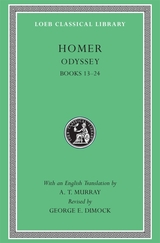 Odyssey, Volume II: Books 13–24
Homer
Harvard University Press, 1995 The hero’s journey home from war.
Here is a new Loeb Classical Library edition of the resplendent epic tale of Odysseus’ long journey home from the Trojan War and the legendary temptations, delays, and perils he faced at every turn. Homer’s classic poem features Odysseus’ encounters with the beautiful nymph Calypso; the queenly but wily Circe; the Lotus-eaters, who fed his men their memory-stealing drug; the man-eating, one-eyed Cyclops; the Laestrygonian giants; the souls of the dead in Hades; the beguiling Sirens; the treacherous Scylla and Charybdis. Here, too, is the hero’s faithful wife, Penelope, weaving a shroud by day and unraveling it by night, in order to thwart the numerous suitors attempting to take Odysseus’ place.
The works attributed to Homer include the two oldest and greatest European epic poems, the Odyssey and Iliad. These texts have long stood in the Loeb Classical Library with a faithful and literate prose translation by A. T. Murray. George Dimock has brought the Loeb’s Odyssey up to date, with a rendering that retains Murray’s admirable style but is worded for today’s readers. The two-volume edition includes a new introduction, notes, and index.
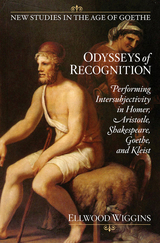 Odysseys of Recognition: Performing Intersubjectivity in Homer, Aristotle, Shakespeare, Goethe, and Kleist
Wiggins, Ellwood
Bucknell University Press, 2019 Literary recognition is a technical term for a climactic plot device. Odysseys of Recognition claims that interpersonal recognition is constituted by performance, and brings performance theory into dialogue with poetics, politics, and philosophy. By observing Odysseus figures from Homer to Kleist, Ellwood Wiggins offers an alternative to conventional intellectual histories that situate the invention of the interior self in modernity. Through strategic readings of Aristotle, this elegantly written, innovative study recovers an understanding of interpersonal recognition that has become strange and counterintuitive. Penelope in Homer’s Odyssey offers a model for agency in ethical knowledge that has a lot to teach us today. Early modern and eighteenth-century characters, meanwhile, discover themselves not deep within an impenetrable self, but in the interpersonal space between people in the world. Recognition, Wiggins contends, is the moment in which epistemology and ethics coincide: in which what we know becomes manifest in what we do.
Published by Bucknell University Press. Distributed worldwide by Rutgers University Press.
Oeconomies in the Age of Newton: 2003 Supplement, Volume 35
Margaret Schabas and Neil De Marchi
Duke University Press While the history of early modern science is well-charted terrain, less has been recorded on the economic thinking of the same period and less still on the intersection of these fields. Addressing this gap in scholarship, Oeconomies in the Age of Newton offers a detailed account of economic concepts of the seventeenth and eighteenth centuries. The volume focuses on “oeconomics”—as “economics” was spelled at that time—which implies a view of economics as shaped by the Greek concept of the household. Examining a range of “oeconomic” curiosities, Oeconomies in the Age of Newton provides intriguing insights into a historical conceptualization of economic relations that differs markedly from the more narrowly defined economics of today.
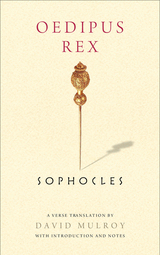 Oedipus: A Folklore Casebook
Edited by Lowell Edmunds and Alan Dundes
University of Wisconsin Press, 1995
Classicist Lowell Edmunds and folklorist Alan Dundes both note that “the Oedipus tale is not likely to ever fade from view in Western civilization, [as] the tale continues to pack a critical family drama into a timeless form.” Looking beyond the story related in Sophocles’ drama—the ancient Theban myth of the son who unknowingly kills his father and marries his mother—Oedipus: A Folklore Casebook examines variations of the tale from Africa and South America to Eastern Europe and the Pacific. Taking sociological, psychological, anthropological, and structuralist perspectives, the nineteen essays reveal the complexities and multiple meanings of this centuries-old tale.
In addition to the well-known interpretations of the Oedipus myth by Sigmund Freud and James Frazer, this casebook includes insightful selections by an international group of scholars. Essays on a Serbian Oedipus legend by Friedrich Krauss and on a Gypsy version by Mirella Karpati, for example, stress the psychological stages of atonement after the Oedipus figure learns the truth about his actions. Anthropologist Melford E. Spiro investigates the myth’s appearance in Burma and the significance of the mother’s identification with the dragon (the sphinx figure). Vladimir Propp’s essay, translated into English for the first time, and Lowell Edmunds’s theoretical review discuss the relation of the Oedipus story to the larger study of folklore. The result is a comprehensive and fascinating casebook for students of folklore, classical mythology, anthropology, and sociology.
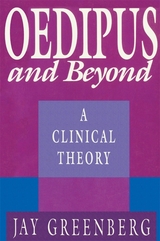 Oedipus and Beyond: A Clinical Theory
Jay Greenberg
Harvard University Press, 1991 Psychoanalysis, entering its second century, is a vital yet divided discipline. A confusing array of mutually contradictory theories compete for the loyalty of clinicians and for the attention of all those interested in understanding human experience.
In the classic Object Relations in Psychoanalytic Theory, Jay Greenberg and his coauthor Stephen Mitchell brought clarity to the confusion surrounding psychoanalytic disputes. They defined two competing models: the drive model, which addresses the private dimensions of experience; and the relational model, which reveals the relentlessly social aspect of our lives. Oedipus and Beyond builds on Greenberg’s earlier contribution. Beginning with a brilliant critique of the conceptual framework of psychoanalysis, he provides fresh insight into Freud’s theory, demonstrating how attempts to resolve some of its shortcomings have generated their own theoretical and clinical dilemmas. In the process he illuminates the roles of the Oedipus complex, the drives, the unconscious, and psychic structure in shaping the sensibilities of alternative psychoanalytic approaches.
Greenberg does not attempt to synthesize the two models, because he believes that diversity is essential if psychoanalysis is to remain strong. Instead, he proposes a compelling and practical clinical theory in which Freud’s insistence on the importance of inner motivation, psychic conflict, and personal agency effectively informs a relational emphasis on the fundamental influence of social living.
The book concludes with some apt illustrations of how the “representational model” can enrich clinical work. Greenberg rethinks the process of making the unconscious conscious, and arrives at new approaches to the analyst’s neutrality, to transference analysis, and to countertransference. The result reflects the author’s profound insight into the structure of psychoanalytic theory and his mastery of the contributions of diverse psychoanalytic schools. Perhaps most important, Greenberg’s argument never loses touch with his clinical experience; ultimately, this is the deeply personal statement of a skilled practitioner.
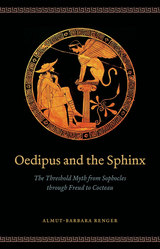 Oedipus and the Sphinx: The Threshold Myth from Sophocles through Freud to Cocteau
Almut-Barbara Renger
University of Chicago Press, 2013 When Oedipus met the Sphinx on the road to Thebes, he did more than answer a riddle—he spawned a myth that, told and retold, would become one of Western culture’s central narratives about self-understanding. Identifying the story as a threshold myth—in which the hero crosses over into an unknown and dangerous realm where rules and limits are not known— Oedipus and the Sphinx offers a fresh account of this mythic encounter and how it deals with the concepts of liminality and otherness. Almut-Barbara Renger assesses the story’s meanings and functions in classical antiquity—from its presence in ancient vase painting to its absence in Sophocles’s tragedy—before arriving at two of its major reworkings in European modernity: the psychoanalytic theory of Sigmund Freud and the poetics of Jean Cocteau. Through her readings, she highlights the ambiguous status of the Sphinx and reveals Oedipus himself to be a liminal creature, providing key insights into Sophocles’s portrayal and establishing a theoretical framework that organizes evaluations of the myth’s reception in the twentieth century. Revealing the narrative of Oedipus and the Sphinx to be the very paradigm of a key transition experienced by all of humankind, Renger situates myth between the competing claims of science and art in an engagement that has important implications for current debates in literary studies, psychoanalytic theory, cultural history, and aesthetics.
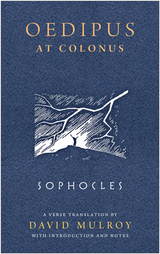 Oedipus at Colonus
Sophocles, A verse translation by David Mulroy, with introduction and notes
University of Wisconsin Press, 2014 Oedipus at Colonus is the third in Sophocles' trilogy of plays about the famous king of Thebes and his unhappy family. It dramatizes the mysterious death of Oedipus, by which he is transformed into an immortal hero protecting Athens. This was Sophocles' final play, written in his mid-eighties and produced posthumously. Translator David Mulroy's introduction and notes deepen the reader's understanding of Oedipus' character and the real political tumult that was shaking Athens at the time that Sophocles wrote the play. Oedipus at Colonus is at once a complex study of a tragic character, an indictment of Athenian democracy, and a subtle endorsement of hope for personal immortality.
As in his previous translations of Oedipus Rex and Antigone, Mulroy combines scrupulous scholarship and textual accuracy with a fresh poetic style. He uses iambic pentameter for spoken passages and short rhymed stanzas for choral songs, resulting in a text that is accessible and fun to read and perform.
 Oedipus at Fenway Park: What Rights Are and Why There are Any
Lloyd Weinreb
Harvard University Press, 1994 We speak of rights as though they are objective matters of fact that have a crucial bearing on how we ought to behave. Yet few, if any, rights are universally acknowledged without wide differences of meaning. Instead, they usually represent the particular ideals of the individuals or groups that claim them. Theories of rights have always grappled with this central problem, but none of the literature on the subject has offered a satisfactory solution. Lloyd Weinreb makes the first significant advance toward an understanding of what rights are, how they function in our lives, and why we need them.
Weinreb’s central argument is that rights are tightly connected to responsibility. They are the normative constituents of persons, attributes that we have rightly, as our due. As such, they enable us to overcome the antinomy of moral freedom and natural causal order. Without them, we could not regard human beings as persons, that is, as free and responsible, or autonomous. Since responsibility is a structural feature of our experience and a matter of fact, rights too are matters of fact.
Against a review of the current debates on the subject, Weinreb fully elaborates his original argument on the nature of rights and finds the source of concrete rights in the nomos, or deep conventions, of a community. Applying his theory, he shows how it helps to answer specific questions about animal rights, human rights—including, in the context of abortion and capital punishment, the right to life—and civil rights, including particularly rights of the handicapped, gay rights, and affirmative action in contemporary American society. Along the way, Weinreb shows that Oedipus and Roger Clemens have more in common than either would probably have supposed.
This highly original work will significantly redirect the study of rights. It will be especially valuable to those who practice or study law, philosophy, politics, and public policy.
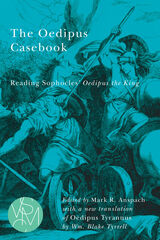 The Oedipus Casebook: Reading Sophocles' Oedipus the King
Mark R. Anspach
Michigan State University Press, 2019 Who killed Laius? Most readers assume Oedipus did. At the play’s end, he stands convicted of murdering his father, marrying his mother, and triggering a deadly plague. With selections from a stellar assortment of critics including Walter Burkert, Terry Eagleton, Michel Foucault, René Girard, and Jean-Pierre Vernant, this book reopens the Oedipus case and lets readers judge for themselves. The Greek word for tragedy means “goat song.” Is Oedipus the goat? Helene Peet Foley calls him “the kind of leader a democracy would both love and desire to ostracize.” The Oedipus Casebook readings weigh the evidence against Oedipus, place the play in the context of Greek scapegoat rites, and explore the origins of tragedy in the festival of Dionysus. This unique critical edition includes a new translation of the play by distinguished classics scholar Wm. Blake Tyrrell and the authoritative Greek text established by H. Lloyd-Jones and N. G. Wilson.
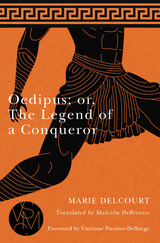 Oedipus; or, The Legend of a Conqueror
Marie Delcourt
Michigan State University Press, 2020 Marie Delcourt’s brilliant study of the Oedipus legend, an unjustly neglected monument of twentieth-century classical scholarship published in 1944 and issued here for the first time in English translation, bridges the gap between Carl Robert’s influential Oidipus (1915) and the work of Lowell Edmunds seventy years later. Delcourt studies the legend in its various aspects, six episodes that have equal weight and that stress the same themes: greatness, conquest, domination, the right to rule—all of them bound up with the idea of kingship. Together they form the biography of a Theban hero, the fullest account that has come down to us about the prehistory of sovereign power among the ancient Greeks. Delcourt does not suppose that Oedipus, or indeed any other Greek hero, was a historical figure. The personality familiar to us from the plays of the tragedians of the fifth century—our oldest source, and a very late one—was the result of their extraordinary artistry in linking together themes rooted in very ancient social and religious rites that in the interval had come to describe the feats of Oedipus, then his life, and finally his character. It was in order to explain these rites, whose meaning had ceased to be understood, that myths and legends were invented in the first place. Oedipus, Delcourt argues, is the archetype of all heroes of essentially (if not exclusively) ritual origin, whose acts were prior to their person. This is a very different— and far more complex—Oedipus than the one rather implausibly imagined by Freud. More generally, the origin and transmission of the Oedipus legend tells us a great deal about the strength and persistence of public memories in prehistoric societies.
 Oedipus Rex
Sophocles
University of Wisconsin Press, 2011 Oedipus Rex is the greatest of the Greek tragedies, a profound meditation on the human condition. The story of the mythological king, who is doomed to kill his father and marry his mother, has resonated in world culture for almost 2,500 years. But Sophocles’ drama as originally performed was much more than a great story—it was a superb poetic script and exciting theatrical experience. The actors spoke in pulsing rhythms with hypnotic forward momentum, making it hard for audiences to look away. Interspersed among the verbal rants and duels were energetic songs performed by the chorus. David Mulroy’s brilliant verse translation of Oedipus Rex recaptures the aesthetic power of Sophocles’ masterpiece while also achieving a highly accurate translation in clear, contemporary English. Speeches are rendered with the same kind of regular iambic rhythm that gave the Sophoclean originals their drive. The choral parts are translated as fluid rhymed songs. Mulroy also supplies an introduction, notes, and appendixes to provide helpful context for general readers and students.
Oedipus the King
Sophocles
University of Chicago Press, 2010 Available for the first time as an independent work, David Grene’s legendary translation of Oedipus the King renders Sophocles’ Greek into cogent, vivid, and poetic English for a new generation to savor. Over the years, Grene and Lattimore’s Complete Greek Tragedies have been the preferred choice of millions of readers—for personal libraries, individual study, and classroom use. This new, stand-alone edition of Sophocles’ searing tale of jealousy, rage, and revenge will continue the tradition of the University of Chicago Press’s classic series.
Praise for David Grene and Richmond Lattimore’s Complete Greek Tragedies “This is it. No qualifications. Go out and buy it everybody.”—Kenneth Rexroth, Nation
“The translations deliberately avoid the highly wrought and affectedly poetic; their idiom is contemporary. . . . They have life and speed and suppleness of phrase.”—Times Education Supplement
Oedipus the King, Second Edition
Sophocles
University of Chicago Press, 2013 An updated stand-alone edition of Sophocles’s Oedipus the King taken from Chicago’s renowned translations of the Greek tragedies.
Over the years, David Grene and Richmond Lattimore’s Complete Greek Tragedies have been the preferred translations of millions of readers—for personal libraries, individual study, and classroom use. Drawn from the authoritative third edition of the University of Chicago Press’s classic series, this updated stand-alone edition of Grene’s Oedipus the King renders the original Greek in clear, vivid, and poetic English for a new generation to savor.
Mark Griffith and Glenn W. Most’s introduction to Sophocles’s searing tale of jealousy, rage, and revenge provides essential information about the play’s first production, plot, and reception in antiquity and beyond.
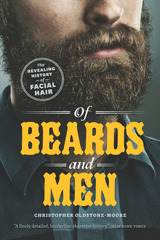 Of Beards and Men: The Revealing History of Facial Hair
Christopher Oldstone-Moore
University of Chicago Press, 2015 Beards—they’re all the rage these days. Take a look around: from hip urbanites to rustic outdoorsmen, well-groomed metrosexuals to post-season hockey players, facial hair is everywhere. The New York Times traces this hairy trend to Big Apple hipsters circa 2005 and reports that today some New Yorkers pay thousands of dollars for facial hair transplants to disguise patchy, juvenile beards. And in 2014, blogger Nicki Daniels excoriated bearded hipsters for turning a symbol of manliness and power into a flimsy fashion statement. The beard, she said, has turned into the padded bra of masculinity.
Of Beards and Men makes the case that today’s bearded renaissance is part of a centuries-long cycle in which facial hairstyles have varied in response to changing ideals of masculinity. Christopher Oldstone-Moore explains that the clean-shaven face has been the default style throughout Western history—see Alexander the Great’s beardless face, for example, as the Greek heroic ideal. But the primacy of razors has been challenged over the years by four great bearded movements, beginning with Hadrian in the second century and stretching to today’s bristled resurgence. The clean-shaven face today, Oldstone-Moore says, has come to signify a virtuous and sociable man, whereas the beard marks someone as self-reliant and unconventional. History, then, has established specific meanings for facial hair, which both inspire and constrain a man’s choices in how he presents himself to the world.
This fascinating and erudite history of facial hair cracks the masculine hair code, shedding light on the choices men make as they shape the hair on their faces. Oldstone-Moore adeptly lays to rest common misperceptions about beards and vividly illustrates the connection between grooming, identity, culture, and masculinity. To a surprising degree, we find, the history of men is written on their faces.
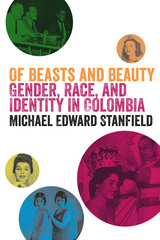 Of Beasts and Beauty: Gender, Race, and Identity in Colombia
By Michael Edward Stanfield
University of Texas Press, 2013 All societies around the world and through time value beauty highly. Tracing the evolutions of the Colombian standards of beauty since 1845, Michael Edward Stanfield explores their significance to and symbiotic relationship with violence and inequality in the country. Arguing that beauty holds not only social power but also economic and political power, he positions it as a pacific and inclusive influence in a country “ripped apart by violence, private armies, seizures of land, and abuse of governmental authority, one hoping that female beauty could save it from the ravages of the male beast.” One specific means of obscuring those harsh realities is the beauty pageant, of which Colombia has over 300 per year. Stanfield investigates the ways in which these pageants reveal the effects of European modernity and notions of ethnicity on Colombian women, and how beauty for Colombians has become an external representation of order and morality that can counter the pathological effects of violence, inequality, and exclusion in their country.
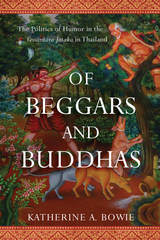 Of Beggars and Buddhas: The Politics of Humor in the Vessantara Jataka in Thailand
Katherine A. Bowie
University of Wisconsin Press, 2020 The 547 Buddhist jatakas, or verse parables, recount the Buddha’s lives in previous incarnations. In his penultimate and most famous incarnation, he appears as the Prince Vessantara, perfecting the virtue of generosity by giving away all his possessions, his wife, and his children to the beggar Jujaka. Taking an anthropological approach to this two-thousand-year-old morality tale, Katherine A. Bowie highlights significant local variations in its interpretations and public performances across three regions of Thailand over 150 years.
The Vessantara Jataka has served both monastic and royal interests, encouraging parents to give their sons to religious orders and intimating that kings are future Buddhas. But, as Bowie shows, characterizations of the beggar Jujaka in various regions and eras have also brought ribald humor and sly antiroyalist themes to the story. Historically, these subversive performances appealed to popular audiences even as they worried the conservative Bangkok court. The monarchy sporadically sought to suppress the comedic recitations. As Thailand has changed from a feudal to a capitalist society, this famous story about giving away possessions is paradoxically being employed to promote tourism and wealth.
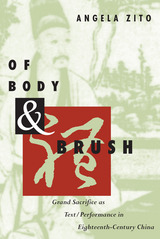 Of Body and Brush: Grand Sacrifice as Text/Performance in Eighteenth-Century China
Angela Zito
University of Chicago Press, 1997 The Qianlong emperor, who dominated the religious and political life of eighteenth-century China, was in turn dominated by elaborate ritual prescriptions. These texts determined what he wore and ate, how he moved, and above all how he performed the yearly Grand Sacrifices. In Of Body and Brush, Angela Zito offers a stunningly original analysis of the way ritualizing power was produced jointly by the throne and the official literati who dictated these prescriptions.
Forging a critical cultural historical method that challenges traditional categories of Chinese studies, Zito shows for the first time that in their performance, the ritual texts embodied, literally, the metaphysics upon which imperial power rested. By combining rule through the brush (the production of ritual texts) with rule through the body (mandated performance), the throne both exhibited its power and attempted to control resistance to it. Bridging Chinese history, anthropology, religion, and performance and cultural studies, Zito brings an important new perspective to the human sciences in general.
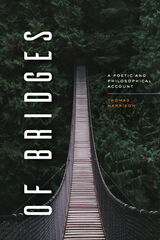 Of Bridges: A Poetic and Philosophical Account
Thomas Harrison
University of Chicago Press, 2021 Offers a philosophical history of bridges—both literal bridges and their symbolic counterparts—and the acts of cultural connection they embody.
“Always,” wrote Philip Larkin, “it is by bridges that we live.” Bridges represent our aspirations to connect, to soar across divides. And it is the unfinished business of these aspirations that makes bridges such stirring sights, especially when they are marvels of ingenuity.
A rich compendium of myths, superstitions, and literary and ideological figurations, Of Bridges organizes a poetic and philosophical history of bridges into nine thematic clusters. Leaping in lucid prose between distant times and places, Thomas Harrison questions why bridges are built and where they lead. He probes links forged by religion between life’s transience and eternity as well as the consolidating ties of music, illustrated by the case of the blues. He investigates bridges in poetry, as flash points in war, and the megabridges of our globalized world. He illuminates real and symbolic crossings facing migrants each day and the affective connections that make persons and societies cohere. In readings of literature, film, philosophy, and art, Harrison engages in a profound reflection on how bridges form and transform cultural communities. Of Bridges is a mesmerizing, vertiginous tale of bridges both visible and invisible, both lived and imagined.
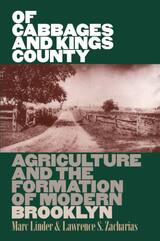 Of Cabbages and Kings County: Agriculture and the Formation of Modern Brooklyn
Marc Linder
University of Iowa Press, 1999
No one today thinks of Brooklyn, New York, as an agricultural center. Yet Kings County enjoyed over two centuries of farming prosperity. Even as late as 1880 it was one of the nation's leading vegetable producers, second only to neighboring Queens County.
In Of Cabbages and Kings County, Marc Linder and Lawrence Zacharias reconstruct the history of a lost agricultural community. Their study focuses on rural Kings County, the site of Brooklyn's tremendous expansion during the latter part of the nineteenth century. In particular, they question whether sprawl was a necessary condition of American industrialization: could the agricultural base that preceded and surrounded the city have survived the onrush of residential real estate speculation with a bit of foresight and public policies that the politically outnumbered farmers could not have secured on their own?
The first part of the book reviews the county's Dutch American agricultural tradition, in particular its conversion after 1850 from extensive farming (e.g., wheat, corn) to intensive farming of market garden crops. The authors examine the growing competition between local farmers and their southern counterparts for a share of the huge New York City market, comparing farming conditions and factors such as labor and transportation.
In the second part of the book, the authors turn their attention to the forces that eventually destroyed Kings County's farming—ranging from the political and ideological pressures to modernize the city's rural surroundings to unplanned, market-driven attempts to facilitate transportation for more affluent city dwellers to recreational outlets on Coney Island and, once transportation was at hand, to replace farms with residential housing for the city's congested population.
Drawing on a vast range of archival sources, the authors refocus the history of Brooklyn to uncover what was lost with the expansion of the city. For today, as urban planners, ecologists, and agricultural developers reevaluate urban sprawl and the need for greenbelts or agricultural-urban balance, the lost opportunities of the past loom larger.
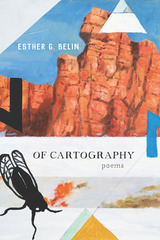 Of Cartography: Poems
Esther G. Belin
University of Arizona Press, 2017 One of our generation’s most important literary voices, Esther G. Belin was raised in the Los Angeles area as part of the legacy following the federally run Indian relocation policy. Her parents completed the Special Navajo Five-Year Program that operated from 1946 to 1961 at Sherman Institute in Riverside, California. Drawing from this experience, her poetry, activism, and multimedia work speaks to larger issues of urban Indian identity, acceptance, adaptation, and cultural estrangement.
In this long-anticipated collection, Belin daringly maps the poetics of womanhood, the body, institution, family, and love. Depicting the personal and the political, Of Cartography is an exploration of identity through language. With poems ranging from prose to typographic and linguistic illustrations, this distinctive collection pushes the boundaries of traditional poetic form.
Marking territory and position according to the Diné cardinal points, Of Cartography demands much from the reader, gives meaning to abstraction, and demonstrates the challenges of identity politics.
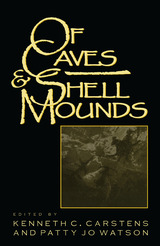 Of Caves and Shell Mounds
Edited by Kenneth C. Carstens and Patty Jo Watson
University of Alabama Press, 1996 Ancient human groups in the Eastern Woodlands of North America were long viewed as homogeneous and stable hunter-gatherers, changing little until the late prehistoric period when Mesoamerican influences were thought to have stimulated important economic and social developments. The authors in this volume offer new, contrary evidence to dispute this earlier assumption, and their studies demonstrate the vigor and complexity of prehistoric peoples in the North American Midwest and Midsouth. These peoples gathered at favored places along midcontinental streams to harvest mussels and other wild foods and to inter their dead in the shell mounds that had resulted from their riverside activities. They created a highly successful, pre-maize agricultural system beginning more than 4,000 years ago, established far-flung trade networks, and explored and mined the world's longest cave—the Mammoth Cave System in Kentucky.
Contributors include:
Kenneth C. Carstens, Cheryl Ann Munson, Guy Prentice, Kenneth B. Tankersley, Philip J. DiBlasi, Mary C. Kennedy, Jan Marie Hemberger, Gail E. Wagner, Christine K. Hensley, Valerie A. Haskins, Nicholas P. Herrmann, Mary Lucas Powell, Cheryl Claassen, David H. Dye, and Patty Jo Watson
Of Corpse: Death and Humor in Folklore and Popular Culture
Peter Narvaez
Utah State University Press, 2003 Laughter, contemporary theory suggests, is often aggressive in some manner and may be prompted by a sudden perception of incongruity combined with memories of past emotional experience. Given this importance of the past to our recognition of the comic, it follows that some "traditions" dispose us to ludic responses. The studies in Of Corpse: Death and Humor in Folklore and Popular Culture examine specific interactions of text (jokes, poetry, epitaphs, iconography, film drama) and social context (wakes, festivals, disasters) that shape and generate laughter. Uniquely, however, the essays here peruse a remarkable paradox---the convergence of death and humor.
Of Darkness and Light: Poems by Kim Cornwall
Edited by Wendy Erd
University of Alaska Press, 2019 This is the hardest kind of listening. / And who will care? / Most do not. / It’s all applause, / applause applause. / How is it possible / to ask for more than that?
An honest work, stunningly passionate: Kim Cornwall’s spirit-infused poetry weaves family and myth—strong women, wild landscapes, the search for reconciliation in circumstances beyond control—in a radiant language of pain, solace, wonder, and gratitude. This remarkable first and last collection of poetry celebrates and chronicles the borderless area between joy and suffering, like breath after long submersion: for one must breech the surface/where what we most need/ lives.
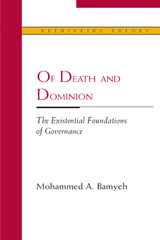 Of Death and Dominion: The Existential Foundations of Governance
Mohammed Bamyeh
Northwestern University Press, 2007 Death is the opposite not of life, but of power. And as such, Mohammed Bamyeh argues in this original work, death has had a great and largely unexplored impact on the thinking of governance throughout history, right down to our day. In Of Death and Dominion Bamyeh pursues the idea that a deep concern with death is, in fact, the basis of the ideological foundations of all political systems. Concentrating on four types of political systems—polis, empire, theocracy, and modern mass society systems—Bamyeh shows how each follows a specific strategy designed to pit power against the equalizing specter of death. Each of these strategies—consolation, expansion, preparation, and repression—produces a certain style of political behavior, as well as particular psychic traumas. In making his argument, Bamyeh revisits a wide range of empirical and theoretical discussions in existentialist philosophy, psychoanalysis, comparative historical sociology, literary studies, and anthropology. By demonstrating how schemes of power are by definition also schemes for defying death—despite their claims to the contrary—his book encourages us to think of a new style of politics, one oriented toward life.
Of Derrida Heidegger and Spirit
David Wood
Northwestern University Press, 1993 Jacques Derrida's De l'espirit: Heidegger et la question is one of his most interesting and accessible later works. In it, Derrida attempts to come to terms with Heidegger's Nazi connections by way of an extended reflection on Heidegger's use of the term "Geist." In Of Derrida, Heidegger, and Spirit, David Wood presents a variety of powerful and distinctive responses to Derrida's book.
Of Earth and Little Rain: The Papago Indians
Bernard L. Fontana; Photographs by John P. Schaefer
University of Arizona Press, 1989 “This text reveals [Fontana’s] interaction with his [Tohono O’odham] neighbors and how geography and climate define life and culture in this piece of dry land. Fontana’s words introduce the reader to people and provide an excellent overview of tribal history, but no notice of this book can overlook John P. Schaefer’s photographs . . . [which] give the reader a feeling for what day-to-day life is like . . . for the 12,000 or so people who call Papaguería their homeland.”—Journal of Arizona History
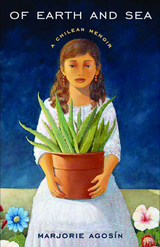 Of Earth and Sea: A Chilean Memoir
Marjorie Agosín
University of Arizona Press, 2008 The Chilean coup d'état of 1973 was a watershed event in the history of Chile. It was also a defining moment in the life of writer Marjorie Agosín.
This collection of prose vignettes and free verse draws upon her experiences as a child in Chile, an expatriate abroad, and a minority Jew—even in the land she calls home—to create a striking portrait of a life of exile. The tone of the book varies as it lyrically explores the geography of Chile and weaves into it the themes of exile and oppression. At times the words become hymns to the physical beauty of her country, evoking the grandeur of this land extending to the southernmost tip of the world. At times they are intimate and melancholy, exploring personal and familial history through miniature portraits that reveal the pain of being different. Finally the tone becomes angry as she denounces the injustices committed against her friends and against the families of the disappeared during the seventeen-year dictatorship of Augusto Pinochet.
Combining themes of memory, childhood, minority issues, Judaism, and political oppression, this collection contains some of Agosín’s strongest work. Of Earth and Sea is a poetic autobiography that explores the world of Chile with eyes that see both despair and hope.
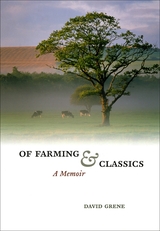 Of Farming and Classics: A Memoir
David Grene
University of Chicago Press, 2006 A fiercely independent thinker, colorful storyteller, and spirited teacher, David Grene devoted his life to two things: farming, which he began as a boy in Ireland and continued into old age; and classics, which he taught for several decades that culminated in his translating and editing, with Richmond Lattimore, of The Complete Greek Tragedies. In this charming memoir, which he wrote during the years leading up to his death in 2002 at the age of eighty-nine, Grene weaves together these interests to tell a quirky and absorbing story of the sometimes turbulent and always interesting life he split between the University of Chicago—where he helped found the Committee on Social Thought—and the farm he kept back in Ireland. Charting the path that took him from Europe to Chicago in 1937, and encompassing his sixty-five-year career at the university, Grene’s book draws readers into the heady and invigorating climate of his time there. And it is elegantly balanced with reflections stemming from his work on the farm where he hunted, plowed and regularly traveled on horseback to bring his cows home for milking. Grene’s form and humor are quite his own, and his brilliant storytelling will enthrall anyone interested in the classics, rural Ireland, or twentieth-century intellectual history, especially as it pertains to the University of Chicago.
 Of Flies, Mice, and Men
François Jacob
Harvard University Press, 1998 Who could have guessed that the lowly fruit fly might hold the key for decoding heredity? Or that the mouse might one day disclose astonishing evolutionary secrets? In a book infused with wisdom, wonder, and a healthy dose of wry skepticism, Nobel Prize-winning geneticist François Jacob walks us through the surprising ways of science, particularly the science of biology, in this century. Of Flies, Mice, and Men is at once a work of history, a social study of the role of scientists in the modern world, and a cautionary tale of the bumbling and brilliance, imagination and luck, that attend scientific discovery. A book about molecules, reproduction, and evolutionary tinkering, it is also about the way biologists work, and how they contemplate beauty and truth, good and evil.
Animated with anecdotes from Greek mythology, literature, episodes from the history of science, and personal experience, Of Flies, Mice, and Men tells the story of how the marvelous discoveries of molecular and developmental biology are transforming our understanding of who we are and where we came from. In particular, Jacob scrutinizes the place of the scientist in society. Alternately cast as the soothsayer Tiresias, the conscienceless inventor Daedalus, or Prometheus, conveyer of dangerous knowledge, the scientist in our day must instead adopt the role of truthteller, Jacob suggests. And the crucial truth that molecular biology teaches is the one he elaborates with great clarity and grace in this book: that all animals are made of the same building blocks, by a combinatorial system that always rearranges the same elements according to new forms.
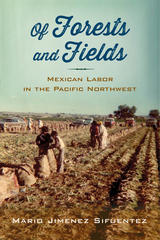 Of Forests and Fields: Mexican Labor in the Pacific Northwest
Mario Jimenez Sifuentez
Rutgers University Press, 2016 2016 Choice Oustanding Academic Title
Just looking at the Pacific Northwest’s many verdant forests and fields, it may be hard to imagine the intense work it took to transform the region into the agricultural powerhouse it is today. Much of this labor was provided by Mexican guest workers, Tejano migrants, and undocumented immigrants, who converged on the region beginning in the mid-1940s. Of Forests and Fields tells the story of these workers, who toiled in the fields, canneries, packing sheds, and forests, turning the Pacific Northwest into one of the most productive agricultural regions in the country. Employing an innovative approach that traces the intersections between Chicana/o labor and environmental history, Mario Sifuentez shows how ethnic Mexican workers responded to white communities that only welcomed them when they were economically useful, then quickly shunned them. He vividly renders the feelings of isolation and desperation that led to the formation of ethnic Mexican labor organizations like the Pineros y Campesinos Unidos Noroeste (PCUN) farm workers union, which fought back against discrimination and exploitation. Of Forests and Fields not only extends the scope of Mexican labor history beyond the Southwest, it offers valuable historical precedents for understanding the struggles of immigrant and migrant laborers in our own era. Sifuentez supplements his extensive archival research with a unique set of first-hand interviews, offering new perspectives on events covered in the printed historical record. A descendent of ethnic Mexican immigrant laborers in Oregon, Sifuentez also poignantly demonstrates the links between the personal and political, as his research leads him to amazing discoveries about his own family history...
Of Forgotten Times
Marisela Rizik
Northwestern University Press, 2003 Of Forgotten Times is at once about romance, about mothers and daughters, and about a dictatorship. Set in a fictional Caribbean island, it begins at the time of the conquistadors and ends in relatively modern times. The novel focuses on the stories of the women of two different families whose only point in common is the dictator who rules their island nation. One set of women, the Parduz family, is descendant of green-eyed slaves who practice voodoo-like rituals even through modern times in a village so distant from the major cities that ancient practices continue to have relevance in the present. The other set of women, the Valverde family, is a mother and daughter who seek to find a way out of the endemic conditions of poverty. Of Forgotten Times describes life in a country ruled by a ruthless, power-hungry, machista tyrant who is married to Herminia Parduz and whose lover, among others, is Mercedes Valverde.
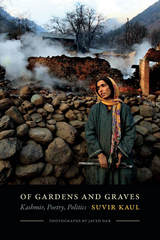 Of Gardens and Graves: Kashmir, Poetry, Politics
Suvir Kaul
Duke University Press, 2017 In Of Gardens and Graves Suvir Kaul examines the disruption of everyday life in Kashmir in the years following the region's pervasive militarization in 1990. Kaul's autobiographical and analytical essays, which were prompted by his yearly visits to Kashmir, are a combination of political analysis, literary criticism, memoir, and journalistic observation. In them he explores Kashmir's pre- and post-Partition history, the effects of militarization, state repression, the suspension of civil rights on Kashmiris, and the challenge Kashmir represents to the practice of democracy in India. The volume also features translations of Kashmiri poetry written in these years of conflict. These poems constitute an archive of heightened feelings and desires that affectively interrogate official accounts of Kashmir while telling us much about those who face extraordinary political turbulence and violence. Of Gardens and Graves also contains a photo essay by Javed Dar, whose photographs work together with Kaul's essays and the poems to represent the interweaving of ordinary life, civic strife, and spectacular violence in Kashmir.
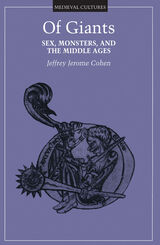 Of Giants: Sex, Monsters, And The Middle Ages
Jeffrey Jerome Cohen
University of Minnesota Press, 1999 Considers what monsters tell us about identity in the medieval period. A monster lurks at the heart of medieval identity, and this book seeks him out. Reading a set of medieval texts in which giants and dismemberment figure prominently, Jeffrey Jerome Cohen brings a critical psychoanalytic perspective to bear on the question of identity formation-particularly masculine identity-in narrative representation. The giant emerges here as an intimate stranger, a monster who stands at the limits of selfhood. Arguing that in the romance tradition of late fourteenth-century England, identity is inscribed on sexed bodies only through the agency of a monster, Cohen looks at the giant as the masculine body writ large. In the giant he sees an uncanny figure, absolutely other and curiously familiar, that serves to define the boundaries of masculine embodiment. Philosophically compelling, the book is also a philologically rigorous inquiry into the phenomenon of giants and giant-slaying in various texts from the Anglo-Saxon period to late Middle English, including Beowulf, Chrétien de Troyes’s The Knight and the Lion, Geoffrey of Monmouth’s History of the Kings of Britain, several works by Chaucer, Sir Gowther, Sir Gawain and the Green Knight, and more.A significant contribution to our understanding of medieval culture, Of Giants also provides surprising insights into questions about the psychosocial work of representation in its key location for the individual: the construction of gender and the social formation of the boundaries of gender identification. It will engage students of the Middle Ages as well as those interested in discourses of the body, social identity, and the grotesque. ISBN 0-8166-3216-2 Cloth £00.00 $47.95xxISBN 0-8166-3217-0 Paper £00.00 $18.95x240 Pages 5 black-and-white photos 5 7/8 x 9 MayMedieval Cultures Series, volume 17Translation inquiries: University of Minnesota Press
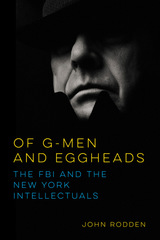 Of G-Men and Eggheads: The FBI and the New York Intellectuals
John Rodden
University of Illinois Press, 2017 Spy romances of Cold War counterespionage evoke scenes of heroic FBI and CIA agents dedicated to smashing communism and its subversive coterie of intellectual fellow travelers bent on painting the world red.
John Rodden cuts this tall tale down to its authentic pint size, refusing to indulge the public relations myth promoted by J. Edgar Hoover's FBI. In Of G-Men and Eggheads, Rodden portrays federal agents’ hilarious obsession with monitoring that ever-present threat to national security, the American literary intellectual. Drawing on government dossiers and archives, Rodden focuses on the onetime members of a radical political sect of ex-Trotskyists (barely numbering a thousand at its height), the so-called New York intellectuals. He describes the nonsensical decades-long pursuit of this group of intellectuals, especially Lionel Trilling, Dwight Macdonald, and Irving Howe. The Keystone Cops style of numerous FBI agents is documented carefully in Rodden's meticulous case studies of how Hoover's men recruited informants to snoop on the "Commies," opened their personal mail, tracked their movements, and reported on their wives and friends.
 Of God and Gods: Egypt, Israel, and the Rise of Monotheism
Jan Assmann
University of Wisconsin Press, 2008 For thousands of years, our world has been shaped by biblical monotheism. But its hallmark—a distinction between one true God and many false gods—was once a new and radical idea. Of God and Gods explores the revolutionary newness of biblical theology against a background of the polytheism that was once so commonplace.
Jan Assmann, one of the most distinguished scholars of ancient Egypt working today, traces the concept of a true religion back to its earliest beginnings in Egypt and describes how this new idea took shape in the context of the older polytheistic world that it rejected. He offers readers a deepened understanding of Egyptian polytheism and elaborates on his concept of the “Mosaic distinction,” which conceives an exclusive and emphatic Truth that sets religion apart from beliefs shunned as superstition, paganism, or heresy.
Without a theory of polytheism, Assmann contends, any adequate understanding of monotheism is impossible.
Best Books for General Audiences, selected by the American Association of School Librarians, and Best Books for Special Interests, selected by the Public Library Association
Of Gods & Strangers
Tina Chang
Four Way Books, 2011 A meditation on history and the imagination that bears witness to acts of genocide and to natural disasters in Ethiopia, Haiti, and Sri Lanka, Of Gods & Strangers interweaves lyrical, arresting accounts of our contemporary world with stories of “Empress Dowager” Tzu Hsi, last empress of China (1861-1908). An urgent reminder that poetry can offer us a social consciousness—“in my locked mouth an urge”—Of Gods & Strangers deftly traces the human dimensions of the “great modern machine,” looking to recover the present and its people through the past’s “faulty memory.”
Of "Good Laws" and "Good Men": Law and Society in the Delaware Valley, 1680-1710
William M. Offutt, Jr.
University of Illinois Press, 1995 William Offutt, Jr., places legal processes at the center of this regions social history. The new societies established there in the late 1600s did not rely on religious conformity, culture, or a simple majority to develop successfully, Offutt maintains. Rather, they succeeded because of the implementation of reforms that gave the expanding population faith in the legitimacy of legal processes implemented by a Quaker elite. Offutt's painstaking investigation of the records of more than 2,000 civil and 1,100 criminal cases in four county courts over a thirty-year period shows that Quakers--the "Good Men"--were disproportionately represented as justices, officers, and jurors in this system of "Good Laws" they had established, and that they fared better than did the rest of the population in dealing with it.
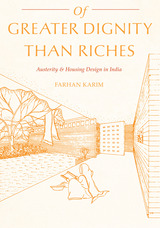 Of Greater Dignity than Riches: Austerity and Housing Design in India
Farhan Karim
University of Pittsburgh Press, 2019 Extreme poverty, which intensified in India during colonial rule, peaked in the 1920s—after decades of imperialist exploitation, famine, and disease—a time when architects, engineers, and city authorities proposed a new type of housing for India’s urban poor and industrial workers. As Farhan Karim argues, economic scarcity became a central inspiration for architectural modernism in the subcontinent.
As India moved from colonial rule to independence, the Indian government, business entities, international NGOs, and intergovernmental agencies took major initiatives to modernize housing conditions and the domestic environment of the state’s low-income population. Of Greater Dignity than Riches traces multiple international origins of austerity as an essential ingredient of postcolonial development. By prescribing model villages, communities, and ideal houses for the working class, this project of austerity eventually reduced poverty into a stylized architectural representation. In this rich and original study, Karim explains the postwar and postcolonial history of low-cost housing as an intertwined process of global transferences of knowledge, Cold War cultural politics, postcolonial nationalism, and the politics of economic development.
 Of Huck and Alice: Humorous Writing in American Literature
Neil Schmitz
University of Minnesota Press, 1983 Of Huck and Alice was first published in 1983. Minnesota Archive Editions uses digital technology to make long-unavailable books once again accessible, and are published unaltered from the original University of Minnesota Press editions. Huck Finn and Alice B. Toklas allow Mark Twain and Gertrude Stein to slip away from the cramped and smothery intentions of proper writing. Like Krazy Kat, who transforms the hurt of Ignatz Mouse's brick into humorous bliss, Huck and Alice brilliantly misrepresent painful authority. As exemplars of humorous skepticism, Mark Twain and Gertrude Stein are at the center of this far-ranging book that begins with an examination of Jacksonian dialect humor, ends with an account of the humorous style in post-modern American fiction, and considers along the way the sweet parlance of Krazy Kat, the meaning of Harpo Marx's silence, and the iconicity of Woody Allen's face. Schmitz's analysis of the humorous style explores the texture of its language, discusses its preferred forms, and shows how the humorist frames his or her question within the text.
Of Humans, Pigs, and Souls: An Essay on the Yagwoia "Womba" Complex
Jadran Mimica
HAU, 2020 For the Yagwoia-Angan people of Papua New Guinea, womba is a malignant power with the potential to afflict any soul with cravings for pig meat and human flesh. Drawing on long-term research among the Yagwoia, and in an analysis informed by phenomenology and psychoanalysis, Jadran Mimica explores the womba complex in its local cultural-existential determinations and regional permutations. He attends to the lived experience of this complex in relation to the wider context of mortuary practices, feasting, historical cannibalism, and sorcery. His account of womba illuminates the moral meanings of Yagwoia selfhood and associated senses of subjectivity and agency. Mimica concludes by reflecting on the recent escalation of concerns with witchcraft and sorcery in Papua New Guinea, specifically in relation to a new wave of Christian evangelism occurring in partnership with the state.
Of Interest to the General Public: About a Coronation Cloak from Ethiopia
Maaza Mengiste
Diaphanes, 2026 A multimedia narration inspired by the journey of an Ethiopian royal mantle to Berlin.
The work of Maaza Mengiste draws from voices and stories that have been excluded, from gaps that seem inexplicable, from images, objects, and places that pulse with pasts unresolved. While exploring the African collections at the Ethnological Museum of Berlin, she was struck by an elaborate coronation cloak from Ethiopia on display. Inspired by the history of the 1868 British Expedition to Abyssinia (now Ethiopia) and the burning of the palace fortress at Magdala, Of Interest to the General Public uses photography and words to reimagine the journey of the royal mantle—out of battle, through fire, over mountains, to cross the waters into Berlin.
 Of Joints and Other Articulations: The Futures of Arthrosophy
Michael Marder
Northwestern University Press, 2026 Articulates a philosophical mode of thinking modeled after our bodily construction points
What if we were to reimagine bodies of all kinds—biological and ecosystemic, political and textual, cosmic and artistic—from the perspective of their joints? This is the wager of Michael Marder’s philosophical treatise, which skirts the extremes of totalization and fragmentation by following the model of the joints, the structures that both articulate and disarticulate complex living unities.
Of Joints and Other Articulations: The Futures of Arthrosophy proposes that, as embodied figures of relations, joints shed new light on the question of time and the meaning of art, the activity of language and the fluctuations of good and ill health, political violence and humility, conversions and perversions. Arthrosophy, the wisdom of joints, supplements and substantiates philosophy itself, teaching us how to think through and with our knees and elbows, hips and shoulders, sutures and pivot joints.
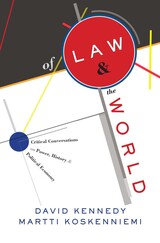 Of Law and the World: Critical Conversations on Power, History, and Political Economy
David Kennedy and Martti Koskenniemi
Harvard University Press, 2023 A searching dialogue between two leading legal scholars exploring the place of law in global affairs.
The modern world is legalized: legal language, institutions, and professionals are everywhere. But what is law’s power in global life? What does all this legality have to do with hegemony, with hierarchy and inequality, and with the diversity of human experience? What is its history and how does that history matter in world affairs? Above all, what does it mean to think “critically” about law and global affairs? In this poignant and iconoclastic book, two leading scholars take us to the heart of the matter, examining law’s relationship with history, power, and political economy.
David Kennedy and Martti Koskenniemi have often inspired each other and are both considered “critical” voices in international law, but they have never explored their similarities and differences as deeply as they do here. Of Law and the World takes the form of a conversation, as the authors reflect on the study of international law, the motivations underlying their research, and the payoffs and limitations of their investigations into law’s role in global affairs. They revisit and renew debates about the past and future of the many legalities that shape our world.
Erudite, open-minded, and informed by decades of experience and observation, Of Law and the World is an unflinchingly honest confrontation with humanity’s struggle to live together.
 Of Little Faith: The Politics of George W. Bush's Faith-Based Initiatives
Amy E. Black, Douglas L. Koopman, and David K. Ryden
Georgetown University Press, 2004 George W. Bush had planned to swear his oath of office with his hand on the Masonic Bible used by both his father and George Washington, however, due to the inclement weather, a family Bible was substituted. Almost immediately on taking office, President Bush made passage of "faith-based initiatives"—the government funding of religious charitable groups—a legislative priority. However, "inclement" weather storm-tossed his hopes for faith-based initiatives as well. What happened? Why did these initiatives, which began with such vigor and support from a popular president, fail? And what does this say about the future role of religious faith in American public life? Amy Black, Douglas Koopman, and David Ryden—all prominent political scientists—utilize a framework that takes the issue through all three branches of government and analyzes it through three very specific lenses: a public policy lens, a political party lens, and a lens of religion in the public square. Drawing on dozens of interviews with key figures in Washington, the authors tell a compelling story, revealing the evolution of the Bush faith-based strategy from his campaign for the presidency through congressional votes to the present. They show how political rhetoric, infighting, and poor communication shipwrecked Bush's efforts to fundamentally alter the way government might conduct social services. The authors demonstrate the lessons learned, and propose a more fruitful, effective way to go about such initiatives in the future.
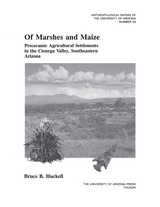 Of Marshes and Maize: Preceramic Agricultural Settlement in the Cienega Valley, Southeastern Arizona
Bruce B. Huckell
University of Arizona Press, 1995 While it was once believed that agriculture and pottery developed concurrently in prehistoric societies, modern research has concluded that agriculture preceded pottery making, since a sedentary life with greater food production led to both the need and time to create storage containers. Bruce Huckell has been at the forefront of a movement in Arizona archaeology that has greatly modified our understanding of the transition from the Archaic to the agricultural periods in the Southwest. Work done by Huckell and others at Matty Canyon has produced the most detailed account available of a Late Archaic village and has been extremely influential in suggesting that the cultivation of maize predated the appearance of pottery. Of Marshes and Maize presents archaeological information obtained from small-scale investigations at two deeply buried preceramic sites in the Cienega Creek Basin. Its report on excavations at the Donaldson Site and at Los Ojitos offers a thorough description of archaeological features and artifacts, floral and faunal remains, and their geological and chronological contexts. From this data, the author concludes that a major shift toward a sedentary lifeway dependent on maize agriculture had already occurred by Late Archaic times (c. 500 to 800 B.C.), demonstrating that previous research on late preceramic sites in this region has provided an inadequate picture of the period. This monograph represents the first full presentation in the literature of an important set of data that is well-known among researchers but has thus far not been easily accessible. It is a classic example of the use of fragmentary evidence in well-dated contexts to introduce new ideas, and will stand not only as an important record of the evidence but also as the primary reference for this significant new interpretation of the late Archaic and the introduction of agriculture into the Southwest.
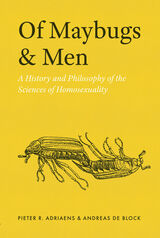 Of Maybugs and Men: A History and Philosophy of the Sciences of Homosexuality
Pieter R. Adriaens and Andreas De Block
University of Chicago Press, 2022 A much-needed exploration of the history and philosophy of scientific research into male homosexuality.
Questions about the naturalness or unnaturalness of homosexuality are as old as the hills, and the answers have often been used to condemn homosexuals, their behaviors, and their relationships. In the past two centuries, a number of sciences have involved themselves in this debate, introducing new vocabularies, theories, arguments, and data, many of which have gradually helped tip the balance toward tolerance and even acceptance. In this book, philosophers Pieter R. Adriaens and Andreas De Block explore the history and philosophy of the gay sciences, revealing how individual and societal values have colored how we think about homosexuality.
The authors unpack the entanglement of facts and values in studies of male homosexuality across the natural and human sciences and consider the extent to which science has mitigated or reinforced homonegative mores. The focus of the book is on homosexuality’s assumed naturalness. Geneticists rephrased naturalness as innateness, claiming that homosexuality is innate—colloquially, that homosexuals are born gay. Zoologists thought it a natural affair, documenting its existence in myriad animal species, from maybugs to men. Evolutionists presented homosexuality as the product of natural selection and speculated about its adaptive value. Finally, psychiatrists, who initially pathologized homosexuality, eventually appealed to its naturalness or innateness to normalize it.
Discussing findings from an array of sciences—comparative zoology, psychiatry, anthropology, evolutionary biology, social psychology, developmental biology, and machine learning—this book is essential reading for anyone interested in what science has to say about homosexuality.
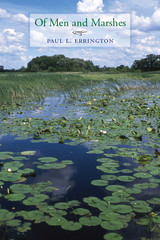 Of Men and Marshes
Paul Errington
University of Iowa Press, 1957 Standing with such environmental classics as Loren Eiseley’s TheImmense Journey, his friend and mentor Aldo Leopold’s A Sand County Almanac, and Joseph Wood Krutch’s The Voice of the Desert, Paul Errington’s Of Men and Marshes remains an evocative reminder of the great beauty and intrinsic value of the glacial marshland. Prescient and stirring, steeped in insights from Errington’s biological fieldwork, his experiences as a hunter and trapper, and his days exploring the marshes of his rural South Dakota childhood, this vibrant work of nature writing reveals his deep knowledge of the marshland environments he championed. Examining the marsh from a dynamic range of perspectives, Errington begins by inviting us to consider how immense spans of time, coupled with profound geological events, shaped the unique marshland ecosystems of the Midwest. He then follows this wetland environment across seasons and over the years, creating a compelling portrait of a natural place too little appreciated and too often destroyed. Reminding us of the intricate relationships between the marsh and the animals who call it home, Errington records his experiences with hundreds of wetland creatures. He follows minks and muskrats, snapping turtles and white pelicans, red foxes and blue-winged teals—all the while underscoring our responsibility to preserve this remarkable and fragile environment and challenging us to change the way we think about and value marshlands. This classic of twentieth-century nature writing, a landmark work that is still a joy to read, offers a stirring portrait of the Midwest’s endangered glacial marshland ecosystems by one of the most influential biologists of his day. A cautionary book whose advice has not been heeded, a must-read of American environmental literature, Of Men and Marshes should inspire a new generation of conservationists.
Of Men and Monsters: Jeffrey Dahmer and the Construction of the Serial Killer
Richard Tithecott
University of Wisconsin Press, 1998 Of Men and Monsters examines the serial killer as an American cultural icon, one that both attracts and repels. Richard Tithecott suggests that the stories we tell and the images we conjure of serial killers—real and fictional—reveal as much about mainstream culture and its values, desires, and anxieties as they do about the killers themselves.
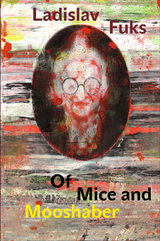 Of Mice and Mooshaber
Ladislav Fuks
Karolinum Press, 2014 Ladislav Fuks (1923–94) was an outstanding Czech writer whose work, consisting primarily of psychological fiction, explores themes of anxiety and life in totalitarian systems. Fuks is best known for his works of short fiction set during the Holocaust, specifically “The Cremator,” a story—later made into a film—about a worker in a crematorium, who, under the influence of Nazi propaganda, murders his entire family.
Written before the occupation of Czechoslovakia in 1968 but not published until 1970, Of Mice and Mooshaber is Fuks’s first novel. The story takes place in an unspecified country in which the ruler has been overthrown and replaced by a dictator. The main protagonist, Mrs. Mooshaber, is an old widow whose husband was a coachman in a brewery. Her life revolves around her job as a caretaker for troublesome children, her own ungrateful children, and her fear of mice, which she tries to catch in traps. Blending elements of the grotesque with the fantastic, Fuks’s novel of heartbreaking tragedy speaks to the evil that can be found within the human soul.
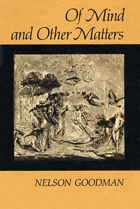 Of Mind and Other Matters
Nelson Goodman
Harvard University Press, 1984 Of Mind and Other Matters displays perhaps more vividly than any one of Nelson Goodman’s previous books both the remarkable diversity of his concerns and the essential unity of his thought.
Many new studies are incorporated in the book, along with material, often now augmented or significantly revised, that he has published during the last decade. As a whole the volume will serve as a concise introduction to Goodman’s thought for general readers, and will develop its more recent unfoldings for those philosophers and others who have grown wiser with his books over the years.
Goodman transcends the narrow “scientism and humanism that set the sciences and the arts in opposition”; his insights derive from both formal philosophy and cognitive psychology. As Hilary Putnam has noted, Goodman “prefers concrete and partial progress to grand and ultimately empty visions”; and here are illuminating studies of topics ranging from science policy and museum administration and art education to narrative in literature and painting and the analysis of elusive aspects of literal and metaphorical reference. All these are ramifications of Goodman’s profound and often revolutionary philosophical work on the ways we understand and even make the worlds we live in.
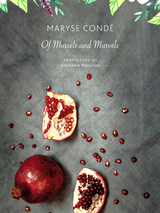 Of Morsels and Marvels
Maryse Condé
Seagull Books, 2019 For many, cooking is simply the mechanical act of reproducing standard recipes. To Maryse Condé, however, cooking implies creativity and personal invention, on par with the complexity of writing a story. A cook, she explains, uses spices and flavors the same way an author chooses the music and meaning of words.
In Of Morsels and Marvels, Condé takes us on a literary journey around places she has travelled to in India, Indonesia, and South Africa. She highlights the tastes and culinary traditions that are fascinating examples of a living museum. Such places, Condé explains, provide important insights into lesser-known aspects of contemporary life. One anecdote illustrates what becomes of the standard Antillean dishes of fish stew and goat curry by two Antilleans who own a restaurant in Sydney, Australia. Cuisine changes not only according to the individual cook but also adapts to foreign skies under which it is created. The author also recounts personal memories of her lifelong relationship with cooking, such as when Adélia, her family’s servant, wrongly blames little Maryse for mixing raisins with fish and using her imagination in the kitchen.
Blending travel with gastronomy, this enchanting volume from the winner of the 2018 Alternative Nobel Prize will delight all who marvel at the wonders of the kitchen or seek to taste the world.
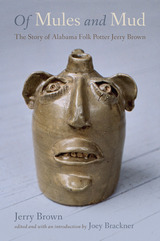 Of Mules and Mud: The Story of Alabama Folk Potter Jerry Brown
Jerry Brown, edited and with an introduction by Joey Brackner
University of Alabama Press, 2022 The life and times of Alabama folk potter Jerry Brown, as told in his own words
Born in 1942, Jerry Brown helped out in his father’s pottery shop as a young boy. There he learned the methods and techniques for making pottery in a family tradition dating back to the 1830s. His responsibilities included tending the mule that drove the mill that was used to mix clay (called “mud” by traditional potters). Business suffered as demand for stoneware churns, jugs, and chamber pots waned in the postwar years, and manufacture ceased following the deaths of Brown’s father and brother in the mid-1960s. Brown turned to logging for his livelihood, his skill with mules proving useful in working difficult and otherwise inaccessible terrain. In the early 1980s, he returned to the family trade and opened a new shop that relied on the same methods of production with which he had grown up, including a mule-powered mill for mixing clay and the use of a wood-fired rather than gas-fueled kiln.
Folklorist Joey Brackner met Brown in 1983, and the two quickly became close friends who collaborated together on a variety of documentary and educational projects in succeeding years—efforts that led to greater exposure, commercial success, and Brown’s recognition as a National Heritage Fellow by the National Endowment for the Arts. For years, Brown spoke of the urge to write his life story, but he never set pen to paper. In 2015, Brackner took the initiative and interviewed Brown, recording his life story over the course of a weekend at Brown’s home. Of Mules and Mud is the result of that marathon interview session, conducted one year before Brown passed away.
Brackner has captured Jerry Brown’s life in his own words as recounted that weekend, lightly edited and elaborated. Of Mules and Mud is illustrated with photos from all phases of Brown’s life, including a color gallery of 28 photos of vessel forms made by Brown throughout his career that collectors of folk pottery will find invaluable.
Of No Country I Know: New and Selected Poems and Translations
David Ferry
University of Chicago Press, 1999 David Ferry's Of No Country I Know: New and Selected Poems and Translations provides a wonderful gathering of the work of one of the great American poetic voices of the twentieth century. It brings together his new poems and translations, collected here for the first time; his books Strangers and Dwelling Places in their entirety; selections from his first book, On the Way to the Island; and selections from his celebrated translations of the Babylonian epic Gilgamesh, the Odes of Horace, and of Virgil's Eclogues. This is Ferry's fullest and most resonant book, demonstrating the depth and breadth of forty years of a life in poetry.
"Though Ferry is perhaps best known for his eloquent translations of Horace and Virgil, "Of No Country I Know" demonstrates that he deserves acclaim for his own poetry as well."—Carmela Ciuraru, New York Times Book Review
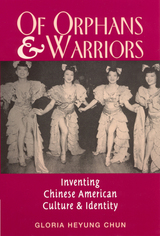 Of Orphans and Warriors: Inventing Chinese American Culture and Identity
Chun, Gloria Heyung
Rutgers University Press, 1999 "We were as American as can be," states Jadin Wong in recalling the days when she used to dance at a San Francisco nightclub during the 1940s. Wong belonged to an all-Chinese chorus line at a time when all East Asians were called "Orientals." In this context, then, what did it mean for Wong, an American-born Chinese, to say that she thought of herself as an "American"? Of Orphans and Warriors explores the social and cultural history of largely urban, American-born Chinese from the 1930s through the 1990s, focusing primarily on those living in California. Chun thus opens a window onto the ways in which these Americans born of Chinese ancestry negotiated their identity over a half century. Past scholarship has portrayed these individuals as desiring to assimilate into mainstream American culture, but being prevented from doing so by the immigrant parent generation. Taking a new approach, Chun uses memoirs, autobiographies, and fictional writings to unravel complex issues of ethnic identity as both culturally defined and individually negotiated. She concludes that, while indeed many Chinese Americans were caught between the lures of mainstream American culture and their parents' old-world values, this liminal position offered them unprecedented opportunities to carve out new identities for themselves from a position of strength.
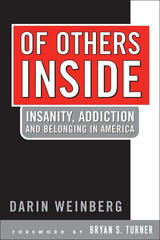 Of Others Inside: Insanity, Addiction And Belonging in America
Darin Weinberg, foreword by Bryan S. Turner
Temple University Press, 2005 There is little doubt among scientists and the general public that homelessness, mental illness, and addiction are inter-related. In Of Others Inside, Darin Weinberg examines how these inter-relations have taken form in the United States. He links the establishment of these connections to the movement of mental health and addiction treatment from redemptive processes to punitive ones and back again, and explores the connection between social welfare, rehabilitation, and the criminal justice system.
Seeking to offer a new sociological understanding of the relationship between social exclusion and mental disability, Of Others Inside considers the general social conditions of homelessness, poverty, and social marginality in the U.S. Weinberg also explores questions about American perceptions of these conditions, and examines in great detail the social reality of mental disability and drug addiction without reducing people's suffering to simple notions of biological fate or social disorder.
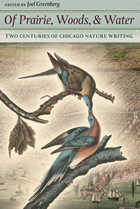 Of Prairie, Woods, and Water: Two Centuries of Chicago Nature Writing
Edited by Joel Greenberg
University of Chicago Press, 2008 In the literary imagination, Chicago evokes images of industry and unbridled urban growth. But the tallgrass prairie and deep forests that once made up Chicago’s landscape also inspired musings from residents and visitors alike. In Of Prairie, Woods, and Water, naturalist Joel Greenberg gathers these unique voices from the land to present an unexpected portrait of Chicago in this often charming, sometimes heart-wrenching anthology of nature writing.
These writings tell the tale of a land in transition—one with abundant, unique, and incredibly lush flora and fauna, a natural history quite elusive today. Drawing on archives he uncovered while writing his acclaimed A Natural History of the Chicago Region, Greenberg hand-selected these first-person narratives, all written between 1721 and 1959. Not every author is familiar, but every contribution is distinctive. From a pioneer’s hilarious notes on life in the Kankakee marsh to Theodore Drieser’s poignant plea for conservation of the Tippecanoe River to infamous murderer Nathan Leopold’s charming description of a pet robin he kept in prison, the sources included are as diverse as the nature they describe.
The excerpts conclude with insightful biographical essays and traverse a wide area of greater Chicagoland, from the Illinois River to southwest Michigan, from southern Wisconsin to the Limberlost swamp of northeastern Indiana. A fascinating record of Chicago’s changing environmental history, Of Prairie, Woods, and Water captures the natural world in a way that will inspire its continued conservation. Errata: We have learned the title of a book by the Chicago ecologist and writer May Theilgaard Watts has been incorrectly rendered in the selections attributed to Mrs. Watts. The correct title of her book is Reading the Landscape of America (Nature Study Guild Publishers, see http://naturestudy.com). This will be corrected in the next printing. We very much regret the error.
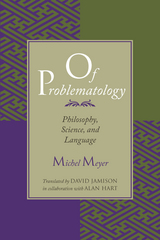 Of Problematology: Philosophy, Science, and Language
Michel Meyer
University of Chicago Press, 1995 Michel Meyer offers a new beginning for philosophy rooted in a theory of questioning that he calls "problematology." Meyer argues that a new beginning is necessary in order to resituate philosophy, science, and linguistic analysis, and he proposes a global view of rationality by returning to the nature of questioning itself.
For Meyer, philosophy does not solve problems or give answers but instead shows how propositions are related to a whole field of questions that give them meaning. Reason is identified not with answers but with the question-answer process. Meyer pursues this new theory of reason and meaning in a critique of Western philosophy from Socrates, Plato, and Aristotle through Heidegger, Wittgenstein, and Foucault. He provides a detailed analysis of Descartes' notion of radical doubt and demonstrates its implications for the subsequent philosophical tradition that ignored the questioning process while pursuing an unshakable foundation for knowledge. Meyer argues that recent work in rhetoric points toward a theory of radical questioning and claims that the methods of rhetoric and argumentation must be turned back on philosophy itself in order to recover the original significance of metaphysics as the science of ultimate questions.
 Of Red Dragons and Evil Spirits: Post-Communist Historiography between Democratization and the New Politics of History
Oto Luthar
Central European University Press, 2017 The collection of well-researched essays assesses the uses and misuses of history 25 years after the collapse of Soviet hegemony in Eastern Europe. As opposed to the revival of national histories that seemed to be the prevailing historiographical approach of the 1990s, the last decade has seen a particular set of narratives equating Nazism and Communism. This provides opportunities to exonerate wartime collaboration, casting the nation as victim even when its government was allied with Germany. While the Jewish Holocaust is acknowledged, its meaning and significance are obfuscated. In their comparative analysis the authors are also interested in new practices of ‘Europeanness’. Therefore their presentations of Slovak, Hungarian, Romanian, Bulgarian, Serbian, Bosnian, Croatian and Slovenian post-communist memory politics move beyond the common national myths in order to provide a new insight into transnational interactions and exchanges in Europe in general. The juxtaposition of these politics, the processes in other parts of Europe, the modes of remembering shaped by displacement and the transnational enable a close encounter with the divergences and assess the potential of the formation of common, European memory practices.
Of Revelation and Revolution, Volume 1: Christianity, Colonialism, and Consciousness in South Africa
Jean Comaroff and John L. Comaroff
University of Chicago Press, 1991 Of Revelation and Revolution is at once a highly imaginative, richly detailed history of colonialism, Christianity, and consciousness in South Africa, and a theoretically challenging consideration of the most difficult questions posed by the nature of social experience. Although primarily concerned with the nineteenth and early twentieth centuries, Of Revelation and Revolution also looks forward to the age of apartheid and beyond.
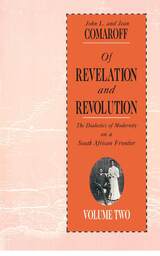 Of Revelation and Revolution, Volume 2: The Dialectics of Modernity on a South African Frontier
John L. Comaroff and Jean Comaroff
University of Chicago Press, 1997 In the second of a proposed three-volume study, John and Jean Comaroff continue their exploration of colonial evangelism and modernity in South Africa. Moving beyond the opening moments of the encounter between the British Nonconformist missions and the Southern Tswana peoples, Of Revelation and Revolution, Volume II, explores the complex transactions—both epic and ordinary—among the various dramatis personae along this colonial frontier.
The Comaroffs trace many of the major themes of twentieth-century South African history back to these formative encounters. The relationship between the British evangelists and the Southern Tswana engendered complex exchanges of goods, signs, and cultural markers that shaped not only African existence but also bourgeois modernity "back home" in England. We see, in this volume, how the colonial attempt to "civilize" Africa set in motion a dialectical process that refashioned the everyday lives of all those drawn into its purview, creating hybrid cultural forms and potent global forces which persist in the postcolonial age.
This fascinating study shows how the initiatives of the colonial missions collided with local traditions, giving rise to new cultural practices, new patterns of production and consumption, new senses of style and beauty, and new forms of class distinction and ethnicity. As noted by reviewers of the first volume, the Comaroffs have succeeded in providing a model for the study of colonial encounters. By insisting on its dialectical nature, they demonstrate that colonialism can no longer be seen as a one-sided relationship between the conquering and the conquered. It is, rather, a complex system of reciprocal determinations, one whose legacy is very much with us today.
Of Reynaert the Fox: Text and Facing Translation of the Middle Dutch Beast Epic
Edited by André Bouwman and Bart Besamusca
Amsterdam University Press, 2009
An entertaining reworking of the most popular branch of the Old French tale of Reynard the Fox, the mid-thirteenth century Dutch epic Van den vos Reynaerde is one of the earliest long literary works in the Dutch vernacular. Sly Reynaert and a cast of other comical woodland characters find themselves again and again caught up in escapades that often provide a satirical commentary on human society.
This charmingly volume is the first bilingual edition of the tale, featuring facing pages with an English translation by Thea Summerfield, making the undisputed masterpiece of medieval Dutch literature accessible to a wide international audience. Accompanying the critical text and parallel translation are an introduction, interpretative notes, an index of names, a complete glossary, and a short introduction to Middle Dutch.
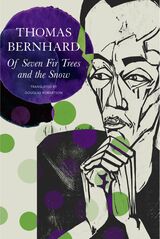 Of Seven Fir Trees and the Snow: Early Stories
Thomas Bernhard
Seagull Books, 2025 These newly translated stories chart the making of a literary provocateur, one experiment and ethical dilemma at a time.
Before Thomas Bernhard became one of the most provocative voices in modern literature, he was a young writer testing the limits of form and subject. Of Seven Fir Trees and the Snow offers an unprecedented look at his evolution, from his earliest published work at nineteen to the emergence of his unmistakable voice. Translated into English for the first time, in these stories, Bernhard moves from stark naturalism to fairy-tale simplicity to the eerie, stripped-down surrealism reminiscent of science fiction. At the same time, he grapples with the fundamental ethical questions that would define his career: how does one navigate personal autonomy in a world fractured by the upheavals of the twentieth century?
Selected and arranged in chronological order by Douglas Robertson, this collection traces Bernhard’s transformation from an ambitious chronicler of Austrian rural life to a writer in dialogue with the broader currents of world literature. A rare glimpse into the making of a literary icon, this volume is essential reading for both longtime admirers and those discovering Bernhard’s singular genius for the first time.
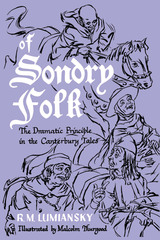 Of Sondry Folk: The Dramatic Principle in the Canterbury Tales
By R. M. Lumiansky
University of Texas Press, 1955 Two hundred years before Shakespeare observed that “all the world’s a stage,” another writer with a flair for drama realized the same fact. This writer was Geoffrey Chaucer.
Chaucer, however, presented his dramatic efforts through the medium of short stories, and he is regularly referred to as one of the world’s great storytellers. Yet there are certain questions which arise time and again in the minds of literary scholars. Most of the tales in the Canterbury collection are excellent, but why did Chaucer include such obviously poor recitals as the dull “Melibeus” and the lengthy “Parson’s Tale”? Did he fail to recognize their lack of literary merit? Or were those of his stories which seem so dull to modern readers really popular in fourteenth-century England?
Of Sondry Folk is Lumiansky’s answer to such questions. But it is more than that. It is the revelation of Chaucer as dramatic writer. Chaucer, says Lumiansky, did not intend primarily to tell a series of good tales. Instead, he chose tales which suited his purpose of dramatic exposition of character. And the characters, though drawn from many walks of life, are not stereotypes. Their tales not only disclose what the Pilgrims think of themselves but reveal these Pilgrims as they really are—dull, romantic, egotistical, pious, or lustful.
Not all readers will agree with Lumiansky’s conclusions in this book. But his scholarship, his clear, uninvolved prose, and his wit and frankness make of it an excellent handbook for the student of the Canterbury Tales. Of Sondry Folk will increase the enjoyment and understanding of Chaucer’s art for any reader, lay or scholarly.
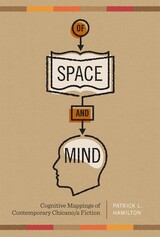 Of Space and Mind: Cognitive Mappings of Contemporary Chicano/a Fiction
By Patrick L. Hamilton
University of Texas Press, 2011 Chicano/a fiction is often understood as a literature of resistance to the dominant U.S. Anglo culture and society. But reducing this rich literary production to a single, binary opposition distorts it in fundamental ways. It conflates literature with life, potentially substituting a literature of protest for social activism that could provoke real changes in society. And it overlooks the complex range of responses to Anglo society that actually animates Chicano/a fiction. In this paradigm-shifting book, Patrick L. Hamilton analyzes works by Rudolfo Anaya, Ana Castillo, Denise Chávez, Rolando Hinojosa, Arturo Islas, John Rechy, Alfredo Véa, and Helena María Viramontes to expand our understandings of the cultural interactions within the United States that are communicated by Chicano/a fiction. He argues that the narrative ethics of "resistance" within the Chicano/a canon is actually complemented by ethics of "persistence" and "transformation" that imagine cultural differences within the United States as participatory and irreducible to simple oppositions. To demonstrate these alternative ethics, Hamilton adapts the methodology of cognitive mapping; that is, he treats the chosen fictional texts as mental maps that are constructed around and communicative of the narrative's ethics. As he reads these cognitive maps, which envision Chicano/a culture as being part of U.S. society rather than as "resistant" and separate, Hamilton asserts that the authors' conception of cultural difference speaks more usefully to current sociopolitical debates, such as those about gay marriage and immigration reform, than does the traditional "resistant" paradigm.
Of Spaces and Ideas: The Novels of Jim Crace and Simon Mawer
Petr Chalupský and Tereza Topolovská
Karolinum Press, 2024 Explores how physical space is represented and affects the work of two British novelists.
Of Spaces and Ideas provides a deeper insight into the work of two contemporary British novelists, Jim Crace and Simon Mawer, with a particular emphasis on spatial sensibility as one of the defining elements of their poetics. Drawing on a range of literary-theoretical approaches to space, the study analyzes selected novels by the two writers to demonstrate the ways in which they render space and place and, above all, the ways in which their spatial representations allow them to express the key ideas behind their stories, namely those of identity, history, and the relationship between an individual and the environment in which they live.
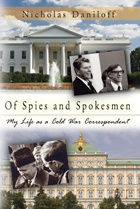 Of Spies and Spokesmen: My Life as a Cold War Correspondent
Nicholas Daniloff
University of Missouri Press, 2008
An American reporter of Russian heritage assigned to Soviet-era Moscow might seem to have an edge on his colleagues, but when he’s falsely accused of spying, any advantage quickly evaporates. . . . .
As a young UPI correspondent in Moscow during the early 1960s, Nicholas Daniloff hoped to jump-start his career in his father’s homeland, but he soon learned that the Cold War had its own rules of engagement. In this riveting memoir, he describes the reality of journalism behind the Iron Curtain: how Western reporters banded together to thwart Soviet propagandists, how their “official sources” were almost always controlled by the KGB—and how those sources would sometimes try to turn newsmen into collaborators.
Leaving Moscow for Washington in 1965, Daniloff honed his skills at the State Department, then returned to Moscow in 1981 to find a more open society. But when the FBI nabbed a Soviet agent in 1986, Daniloff was arrested in retaliation and thrown into prison as a spy—an incident that threatened to undo the Reykjavik summit until top aides to Reagan and Gorbachev worked out a solution.
In addition to recounting a career in the thick of international intrigue, Of Spies and Spokesmen is brimming with inside information about historic events. Daniloff tells how the news media played a crucial role in resolving the Cuban Missile Crisis, recalls the emotional impact of the JFK assassination on Soviet leadership, and describes the behind-the-scenes struggles that catapulted Mikhail Gorbachev to power. He even shares facts not told to the public: how the SAC would warn Moscow that its submarines were too close to American shores, why the Soviets shot down the KAL airliner without visual identification, and how American reporters in Moscow sometimes did dangerous favors for our government that could easily have been mistaken for espionage.
Daniloff sheds light not only on prominent figures such as Nikita Khrushchev and Henry Kissinger but also on suspected spies Frederick Barghoorn, John Downey, and ABC correspondent Sam Jaffe—unfairly branded a Soviet agent by the FBI. In addition, he assesses the performance of Henry Shapiro, dean of American journalists in Moscow, whose forty years in the adversary’s capital often provoke questions about his role and reputation.
In describing how the Western press functioned in the old Soviet Union—and how it still functions in Washington today—Daniloff shows that the Soviet Russia he came to know was far more complex than the “evil empire” painted by Ronald Reagan: a web of propaganda and manipulation, to be sure, but also a place of hospitality and friendship. And with Russia still finding its way toward a new social and political order, he reminds us that seventy years of Communist rule left a deep impression on its national psyche. As readable as it is eye-opening, Of Spies and Spokesmenprovides a new look at that country’s heritage—and at the practice of journalism in times of crisis.
 Of Spirit: Heidegger and the Question
Jacques Derrida
University of Chicago Press, 1989 "I shall speak of ghost, of flame, and of ashes." These are the first words of Jacques Derrida's lecture on Heidegger. It is again a question of Nazism—of what remains to be thought through of Nazism in general and of Heidegger's Nazism in particular. It is also "politics of spirit" which at the time people thought—they still want to today—to oppose to the inhuman.
"Derrida's ruminations should intrigue anyone interested in Post-Structuralism. . . . . This study of Heidegger is a fine example of how Derrida can make readers of philosophical texts notice difficult problems in almost imperceptible details of those texts."—David Hoy, London Review of Books
"Will a more important book on Heidegger appear in our time? No, not unless Derrida continues to think and write in his spirit. . . . Let there be no mistake: this is not merely a brilliant book on Heidegger, it is thinking in the grand style."—David Farrell Krell, Research in Phenomenology
"The analysis of Heidegger is brilliant, provocative, elusive."—Peter C. Hodgson, Religious Studies Review
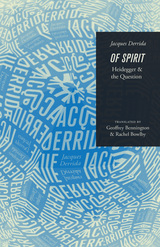 Of Spirit: Heidegger and the Question
Jacques Derrida
University of Chicago Press, 1990 "I shall speak of ghost, of flame, and of ashes." These are the first words of Jacques Derrida's lecture on Heidegger. It is again a question of Nazism—of what remains to be thought through of Nazism in general and of Heidegger's Nazism in particular. It is also "politics of spirit" which at the time people thought—they still want to today—to oppose to the inhuman.
"Derrida's ruminations should intrigue anyone interested in Post-Structuralism. . . . . This study of Heidegger is a fine example of how Derrida can make readers of philosophical texts notice difficult problems in almost imperceptible details of those texts."—David Hoy, London Review of Books
"Will a more important book on Heidegger appear in our time? No, not unless Derrida continues to think and write in his spirit. . . . Let there be no mistake: this is not merely a brilliant book on Heidegger, it is thinking in the grand style."—David Farrell Krell, Research in Phenomenology
"The analysis of Heidegger is brilliant, provocative, elusive."—Peter C. Hodgson, Religious Studies Review
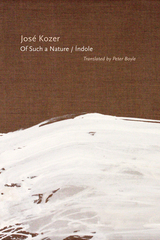 Of Such a Nature/Índole
José Kozer, introduced and translated by Peter Boyle
University of Alabama Press, 2018 An English translation from one of Latin America’s most distinguished poets.
José Kozer is one of the most influential contemporary Cuban poets working today. A key figure in the neobaroque movement within contemporary Latin American poetry, he is one of only three Cubans to ever win the Pablo Neruda Prize given by the Neruda Foundation in Chile. He is the author of close to ninety books, including Este judío de números y letras, Bajo este cien, La garza sin sombras, Carece de causa, and Y del esparto la invariabilidad. Kozer is also noteworthy as a key poet of the Cuban diaspora, having left Cuba in 1960 and residing ever since in the United States.
Of Such a Nature/Índole is a bilingual edition translated into English by Peter Boyle. In addition, Boyle provides an extensive introduction placing Kozer’s work in a critical context.
The Spanish word “índole” can be translated as: “a type,” “a sort,” or “that sort of thing.” The title, Índole, therefore suggests that the poems gathered in this collection, are all instances of specific types of situations, things, or experiences. Kozer has gathered a collection of poems about everyday life—cleaning one’s dentures, a woman leaning over a bowl of oatmeal, a salamander glimpsed while eating breakfast—but always with death not far away.
Of Such a Nature/Índole is a remarkable collection of poems published in Cuba in 2012, covering such materials as Kozer’s Jewish heritage, his Cuban childhood and ongoing connection to the Island, Buddhist and East Asian traditions of spiritual practice, his everyday life in Florida with Guadalupe, ageing, illness, and the shadow of death. Irony and humor are there as well, and to read these poems is to be in the presence of the full seriousness of poetry and its playfulness, its ability to undercut all pretensions.
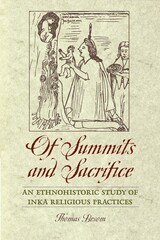 Of Summits and Sacrifice: An Ethnohistoric Study of Inka Religious Practices
By Thomas Besom
University of Texas Press, 2009 In perhaps as few as one hundred years, the Inka Empire became the largest state ever formed by a native people anywhere in the Americas, dominating the western coast of South America by the early sixteenth century. Because the Inkas had no system of writing, it was left to Spanish and semi-indigenous authors to record the details of the religious rituals that the Inkas believed were vital for consolidating their conquests. Synthesizing these arresting accounts that span three centuries, Thomas Besom presents a wealth of descriptive data on the Inka practices of human sacrifice and mountain worship, supplemented by archaeological evidence. Of Summits and Sacrifice offers insight into the symbolic connections between landscape and life that underlay Inka religious beliefs. In vivid prose, Besom links significant details, ranging from the reasons for cyclical sacrificial rites to the varieties of mountain deities, producing a uniquely powerful cultural history.
 Of the Land: The Art and Poetry of Lou Stovall
Will Stovall, Editor. Foreword by Harry Cooper
Georgetown University Press, 2022 The emergence of a master artist alongside his first major collection, created during a golden age of art in the nation’s capital Renowned for his innovative work with silkscreen printing, Lou Stovall’s works are part of numerous collections, including the National Gallery of Art, Smithsonian American Art Museum, and Phillips Collection. Washington Post art critic Paul Richard once wrote, “As a printer of his own art, and of the art of many others, as a framer and installer and shepherd of collections, Stovall has inserted more art into Washington than almost anyone in town.” Of the Land: The Art and Poetry of Lou Stovall presents a series of prints and accompanying poems that showcase the artist’s work during the 1970s, when he was developing his unique silkscreen technique and exploring both natural and abstract elements. An introduction by the book’s editor and artist’s son, Will Stovall, along with an autobiography from the artist anchor the Of the Land series in its time and place—a period of jazz, protest, and prolific art production in Washington, DC, that birthed the Washington Color School. Stovall’s contributions, as well as his collaborations with well-known artists like Jacob Lawrence, Sam Gilliam, Elizabeth Catlett, and Robert Mangold, have cemented him as one of the most significant American artists of our age. Part of a tradition of African American artists and thinkers who met at Howard University, Lou Stovall created the Workshop in 1968, a small, active silkscreen studio printing posters for arts and DC-focused events. His deep influence on the silkscreen medium, the art community, and DC will be part of his lasting legacy.
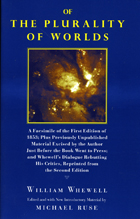 Of the Plurality of Worlds: A facsimile of the first edition of 1853; plus previously unpublished material excised by the author just before the book went to press; and Whewell's dialogue rebutting his critics, reprinted from the second edition
William Whewell
University of Chicago Press, 2001 Is there intelligent life on other worlds? William Whewell, one of the most influential British intellectuals of the nineteenth century, weighed in on this question with Of the Plurality of Worlds. Writing anonymously, Whewell argued that there was no life anywhere else in the universe. Admitting such a possibility, he feared, would threaten humanity's special relationship with God, and open the door to supporters of evolution.
The publication of Plurality in 1853 ignited a bitter Victorian debate on science and religion. This book reprints the first edition in facsimile, together with a vigorous response to his critics that Whewell added later and new introductory and bibliographic material by noted Darwin scholar Michael Ruse. This edition also includes 84 typeset pages—never before published—that Whewell cut from the original book at the last moment. Showing clearly the theological underpinnings of Whewell's thinking, these chapters also reveal the difficulties facing any Victorian who tried to reconcile traditional Christian thought with the findings of modern science.
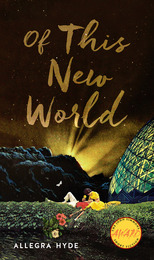 Of This New World
Allegra Hyde
University of Iowa Press, 2016 Of This New World offers a menagerie of utopias: real, imagined, and lost. Starting with the Garden of Eden and ending in a Mars colony, the stories wrestle with conflicts of idealism and practicality, communal ambition and individual kink. Stories jump between genres—from historical fiction to science fiction, realism to fabulism—but all ask that fundamental human question: is paradise really so impossible?
Over the course of twelve stories, Hyde writes with a mix of lyricism, humor, and masterful detail. A group of environmental missionaries seeks to start an ideal eco-society on an island in The Bahamas, only to unwittingly tyrannize the local inhabitants. The neglected daughter of a floundering hippie commune must adjust to conventional life with her un-groovy grandmother. Haunted by her years at a collegiate idyll, a young woman eulogizes a friendship. After indenturing his only son to the Shakers, an antebellum vegan turns to Louisa May Alcott’s famous family for help. And in the final story, a former drug addict chases a second chance at life in a government-sponsored space population program. An unmissable debut, the collection charts the worlds born in our dreams and bred in hope.
Of This River
Noah Davis
Michigan State University Press, 2020 In a stunning and visceral debut, Noah Davis ushers in a new era of poems from the Alleghenyregion of Appalachia. In chronicling the river valley’s human and more-than-human worlds through acts of modern myth making, Davis expands the scope of contemporary American poetry. This soulful meditation on a neglected region of America reveals a legacy of lingering violence to land and animal alike. In striking stories and scenes, Davis portrays the spiritual cost of deep poverty, the necessity to ask for forgiveness, and the joy in praising the beauty still found in the steep hollows. These poems will cling to you like water on the soles of your boots.
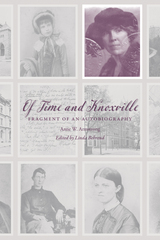 Of Time and Knoxville: Fragment of an Autobiography
Linda Behrend
University of Tennessee Press, 2022 Anne Wetzell Armstrong adored her adopted hometown. Born in Grand Rapids, Michigan, she moved with her family to the “West End” (Fort Sanders) area of Knoxville, Tennessee, in the 1880s, a pivotal decade for a city just getting past the trauma of the Civil War and becoming an economically diverse and culturally cosmopolitan center. Author of The Seas of God (1915), set in a thinly disguised Knoxville (called “Kingsville”), Armstrong was privileged, unconventional, and modern. She was divorced (she later married an Armstrong of Knoxville’s Bleak House), a single mother, and worked—not only as a teacher at Knoxville Girls High School but also in personnel with National City Company of New York and in industrial relations at Eastman Kodak. Her second novel, This Day and Time (1930), is regarded as the first fictional work to treat Appalachia realistically.
Journalist John Gunther’s 1946 description of Knoxville as the “ugliest city I ever saw in America” served as the impetus for Armstrong to pen a memoir of a city she remembered quite differently. Sophisticated and witty, Of Time and Knoxville provides lively, sometimes scandalous sketches of such well-known Knoxville figures as Lizzie Crozier French, Armstrong’s mentor and a leader in the woman’s suffrage movement; Perez Dickinson, businessman and owner of the socially popular Island Home farm (and cousin of Emily Dickinson); and Mary Boyce Temple, clubwoman, philanthropist, and socialite, whose home is preserved as the last extant single-family residence in downtown Knoxville. Complemented by Linda Behrend’s excellent introduction and meticulous annotations, this distinctive memoir also delivers an unusual picture of Knoxville’s beloved Market Square and vividly depicts fin de siècle Knoxville, with its great food at hotel restaurants and lively events at dance halls. Armstrong also details the tragic Flat Creek train wreck of 1889, which seriously injured her own father and led to his death five years later. Of Time and Knoxville is a must-read for lovers of Knoxville, Victorian America, women’s history, and memoir.
Of Time And Place
Sigurd F. Olson
University of Minnesota Press, 1998 Olson’s final work, available in paperback for the first time. Of Time and Place is a legacy from one of the best-loved nature writers of our time. In this, his last book completed just before his death, Sigurd F. Olson guides readers through his wide-ranging memories of a lifetime dedicated to the preservation of the wilderness. Like his other best-selling books, Of Time and Place is filled with beauty, adventure, and wonder. Olson recalls his many friendships of trail and woods and portage, his favorite campsites, the stories behind the artifacts and mementos hanging in his cabin at Listening Point. Whether he is remembering canoe trips with his friends, admiring the playful grace of the otter, or pondering the Earth’s great cycles of climatic change, these moving and evocative essays reaffirm Olson’s stature as one of the greatest nature writers of this century.
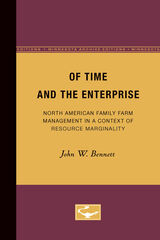 Of Time and the Enterprise: North American Family Farm Management in a Context of Resource Marginality
John Bennett
University of Minnesota Press, 1982
Of Time and the Enterprise was first published in 1982.Of Time and the Enterprise is the result of 12 years’ research in the Canadian sector of the northern Great Plains -- a 7,000-square-mile region that was one of the last areas in North America to be populated by agricultural settlers. This late settlement permitted a reconstruction of the area’s history and economic and social development unparalleled in the literature.This book has several dimensions. It is, first, a meticulous study of the North American family farm. Bennett considers such aspects of the family farm as the ways that family members relate to one another and how the various members, especially the wife, participate in management of the enterprise. The book is also a study of agricultural management as an adaptive process. Farm operators must juggle the demands of their families, communities, and the national market in determining the conduct of the business. Finally, the book is a study of the development process on a recent frontier and thus has many implications for agricultural and community development in the Third World.As the first detailed study of entrepreneurial agriculture in North America, Of Time and the Enterprise combines quantitative and qualitative analysis and looks at the family farm as a form of social behavior, not merely as a form of economic performance. Bennett presents a new interpretation of decision-making, resource allocation, and the influence of family, community, and cultural traditions which he argues must be seen as part of a larger social system.
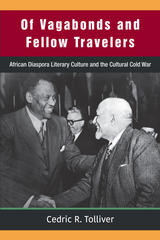 Of Vagabonds and Fellow Travelers: African Diaspora Literary Culture and the Cultural Cold War
Cedric R. Tolliver
University of Michigan Press, 2019 Of Vagabonds and Fellow Travelers recovers the history of the writers, artists, and intellectuals of the African diaspora who, witnessing a transition to an American-dominated capitalist world-system during the Cold War, offered searing critiques of burgeoning U.S. hegemony. Cedric R. Tolliver traces this history through an analysis of signal events and texts where African diaspora literary culture intersects with the wider cultural Cold War, from the First Congress of Black Writers and Artists organized by Francophone intellectuals in September 1956 to the reverberations among African American writers and activists to the assassination of Patrice Lumumba. Among Tolliver’s subjects are Caribbean writers Jacques Stephen Alexis, George Lamming, and Aimé Césaire, the black press writing of Alice Childress and Langston Hughes, and the ordeal of Paul Robeson, among other topics. The book’s final chapter highlights the international and domestic consequences of the cultural Cold War and discusses their lingering effects on our contemporary critical predicament.
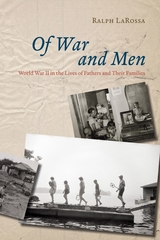 Of War and Men: World War II in the Lives of Fathers and Their Families
Ralph LaRossa
University of Chicago Press, 2011 Fathers in the fifties tend to be portrayed as wise and genial pipe-smokers or distant, emotionless patriarchs. This common but limited stereotype obscures the remarkable diversity of their experiences and those of their children. To uncover the real story of fatherhood during this transformative era, Ralph LaRossa takes the long view—from the attack on Pearl Harbor up to the election of John F. Kennedy—revealing the myriad ways that World War II and its aftermath shaped men.
Offering compelling accounts of people both ordinary and extraordinary, Of War and Men digs deep into the terrain of fatherhood. LaRossa explores the nature and aftereffects of combat, the culture of fear during the Cold War, the ways that fear altered the lives of racial and sexual minorities, and how the civil rights movement affected families both black and white. Overturning some calcified myths, LaRossa also analyzes the impact of suburbanization on fathers and their kids, discovering that living in the suburbs often strengthened their bond. And finally, looking beyond the idealized dad enshrined in TV sitcoms, Of War and Men explores the brutal side of family life in the postwar years. LaRossa’s richly researched book dismantles stereotypes while offering up a fascinating and incisive chronicle of fatherhood in all its complexity.
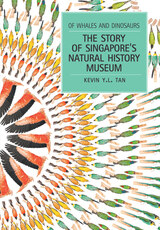 Of Whales and Dinosaurs: The Story of Singapore's Natural History Museum
Kevin Y. L. Tan
National University of Singapore Press, 2015 Singapore's collection of Southeast Asian animals–one of the world's largest–dates back to the old Raffles Museum, officially established in 1878.With the opening of the Lee Kong Chian Natural History Museum in 2015, the original Raffles Museum has "reincarnated" and the loop on its remarkable 127-year history has closed. Beneath the sleek exterior of today's modern museum building lies a saga of titanic struggles and changes. That the collections survived at all–through the multiple challenges of the nineteenth century, the disruption of World War Two, and its potential disintegration in the face of Singapore's modernization–is nothing short of miraculous. This book is not only an institutional history of the museum but also tells the story of frustrations, commitment and courage of the numerous individuals who battled officialdom, innovated endlessly and overcame the odds to protect Singapore's natural history heritage. The book features 108 historical photographs and natural history illustrations printed in full colour throughout.
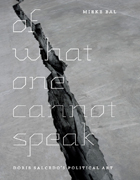 Of What One Cannot Speak: Doris Salcedo's Political Art
Mieke Bal
University of Chicago Press, 2010 Doris Salcedo, a Colombian-born artist, addresses the politics of memory and forgetting in work that embraces fraught situations in dangerous places. Noted critic and theorist Mieke Bal narrates between the disciplines of contemporary culture in order to boldly reimagine the role of the visual arts. Both women are pathbreaking figures, globally renowned and widely respected. Doris Salcedo, meet Mieke Bal.
In Of What One Cannot Speak, Bal leads us into intimate encounters with Salcedo’s art, encouraging us to consider each work as a “theoretical object” that invites—and demands—certain kinds of considerations about history, death, erasure, and grief. Bal ranges widely through Salcedo’s work, from Salcedo’s Atrabiliarios series—in which the artist uses worn shoes to retrace los desaparecidos (“the disappeared”) from nations like Argentina, Chile, and Colombia—to Shibboleth, Salcedo’s once-in-a-lifetime commission by the Tate Modern, for which she created a rupture, as if by earthquake, that stretched the length of the museum hall’s concrete floor. In each instance, Salcedo’s installations speak for themselves, utilizing household items, human bones, and common domestic architecture to explore the silent spaces between violence, trauma, and identity. Yet Bal draws out even deeper responses to the work, questioning the nature of political art altogether and introducing concepts of metaphor, time, and space in order to contend with Salcedo’s powerful sculptures and installations.
An unforgettable fusion of art and essay, Of What One Cannot Speak takes us to the very core of events we are capable of remembering—yet still uncomfortably cannot speak aloud.
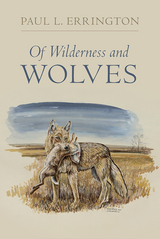 Of Wilderness and Wolves
Paul L. Errington
University of Iowa Press, 2015 “I was a predator, myself, and lived close to the land.” With these words, Paul L. Errington begins this lost classic. Now in print for the first time, the book celebrates a key predator: the wolf. One of the most influential biologists of the twentieth century, Errington melds his expertise in wildlife biology with his love for natural beauty to create a visionary and often moving re-examination of humanity’s relationship with these magnificent and frequently maligned animals.
Tracing his own relationship with wolves from his rural South Dakota upbringing through his formative years as a professional trapper to his landmark work as an internationally renowned wildlife biologist, Errington delves into our irrational fear of wolves. He forthrightly criticizes what he views as humanity’s prejudice against an animal that continues to serve as the very emblem of the wilderness we claim to love, but that too often falls prey to our greed and ignorance. A friend of Aldo Leopold, Errington was an important figure in the conservation efforts in the first half of the twentieth century. During his lifetime, wolves were considered vicious, wantonly destructive predators; by the mid-1900s, they had been almost completely eliminated from the lower forty-eight states. Their reintroduction to their historical range today remains controversial.
Lyrical yet unsentimental, Of Wilderness and Wolves provides a strong and still-timely dose of ecological realism for the abusive mismanagement of our natural resources. It is a testament to our shortsightedness and to Errington’s vision that this book, its publication so long delayed, still speaks directly to our environmental crises.
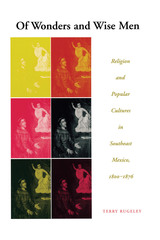 Of Wonders and Wise Men: Religion and Popular Cultures in Southeast Mexico, 1800-1876
By Terry Rugeley
University of Texas Press, 2001 2004 – Harvey L. Johnson Award – Southwest Council of Latin American Studies In the tumultuous decades following Mexico's independence from Spain, religion provided a unifying force among the Mexican people, who otherwise varied greatly in ethnicity and socioeconomic status. Accordingly, religion and the popular cultures surrounding it form the lens through which Terry Rugeley focuses this cultural history of southeast Mexico from independence (1821) to the rise of the dictator Porfirio Díaz in 1876. Drawing on a wealth of previously unused archival material, Rugeley vividly reconstructs the folklore, beliefs, attitudes, and cultural practices of the Maya and Hispanic peoples of the Yucatán. In engagingly written chapters, he explores folklore and folk wisdom, urban piety, iconography, and anticlericalism. Interspersed among the chapters are detailed portraits of individual people, places, and institutions, that, with the archival evidence, offer a full and fascinating history of the outlooks, entertainments, and daily lives of the inhabitants of southeast Mexico in the nineteenth century. Rugeley also links this rich local history with larger events to show how macro changes in Mexico affected ordinary people.
 Off Book: Devised Performance and Higher Education
Edited by Heather Fitzsimmons Frey, Nicola Hyland, and James McKinnon
Intellect Books, 2022 An edited collection of essays exploring ways that theatrical devising supports and defies higher education’s institutional goals.
In the theater industry, “off book” refers to the date by which performers are to have memorized their lines and will no longer carry their play script—the “book”—on stage. But for the authors of this volume, the question is not when the book needs to be memorized, but why is there a need to be “on” book in the first place? Practitioners of devised performance choose to compose live performances from scratch rather than follow instructions in someone else’s script; educators of devised performance prefer to practice learning, too, as a generative and creative process that can never be confused with mere memorization. In its usual context, “off book” implies that theater is (literally) authorized by the book—the dramatic text—that represents its essential core or contains its meaning. Yet the “book” is not essential, and the chapters here highlight higher education theater practices that throw away the “book” altogether, creating space for actors and learners to do more than memorize. The conventional rules and hierarchies of theater creation, research, training, and education are not always relevant, or desirable, in these contexts. Instead, the questions and practices that go beyond the “book” matter.
Lively and engaging, Off Book will be a valuable and unique resource for university students, drama educators, theater historians, and practicing devised theater artists.
 Off Center: Power and Culture Relations Between Japan and the United States
Masao Miyoshi
Harvard University Press, 1991 What is the connection between the United States' imbalance of trade with Japan and the imbalance of translation in the other direction? Between Western literary critics' estimates of Japanese fiction and Japanese politicians' "America-bashing"? Between the portrayal of East-West relations in the film Merry Christmas, Mr. Lawrence and the terms of the GATT trade agreements?
In this provocative study, Masao Miyoshi deliberately adopts an off-center perspective--one that restores the historical asymmetry of encounters between Japan and the United States, from Commodore Perry to Douglas MacArthur--to investigate the blindness that has characterized relations between the two cultures.
Both nations are blinkered by complementary forms of ethnocentricity. The United States--or, more broadly, the Eurocentric West--believes its culture to be universal, while Japan believes its culture to be essentially unique. Thus American critics read and judge Japanese literature by the standards of the Western novel; Japanese politicians pay lip service to "free trade" while supporting protectionist policies at home and abroad.
Miyoshi takes off from literature to range across culture, politics, and economics in his analysis of the Japanese and their reflections in the West; the fiction of Tanizaki, Mishima, Oe; trade negotiations; Japan bashing and America bashing; Emperor worship; Japanese feminist writing; the domination of transcribed conversation as a literary form in contemporary Japan. In his confrontation with cultural critics, Miyoshi does not spare "centrists" of either persuasion, nor those who refuse to recognize that "the literary and the economical, the cultural and the industrial, are inseparable."
Yet contentious as this book can be, it ultimately holds out, by its example, hope for a criticism that can see beyond the boundaries of national cultures--without substituting a historically false "universal" culture--and that examines cultural convergences from a viewpoint that remains provocatively and fruitfully off center.
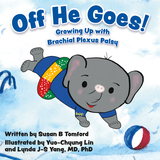 Off He Goes!: Growing Up with Brachial Plexus Palsy
Written by Susan B Tomford; Illustrated by Yuo-Chyung Lin and Lynda J-S Yang, MD, PhD
Michigan Publishing, 2018 Spend the day with Wimbo – as he actively participates in daily activities despite his Brachial Plexus Palsy. Accompany him through his day as he prepares to take on the world!
Attractive colorful multimedia images merge with easy-to-read text to make this young elephant’s story appeal to all pre-school children.
This board book is the product of the faculty and staff of the University of Michigan Brachial Plexus and Peripheral Nerve Program, inspired by the plight of orphan elephants in Africa and The David Sheldrick Wildlife Trust that helps orphaned calves reintegrate back into the wild as well as our patients who actively participate despite Brachial Plexus Palsy. Our clinical program strives to provide the best interdisciplinary care for patients through collaboration, research, and innovation – as we hope to improve the function and quality of life for all persons with brachial plexus and peripheral nerve dysfunction.
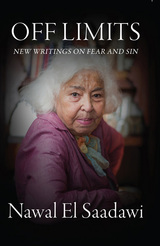 Off Limits: New Writings on Fear and Sin
Nawal El Saadawi
Gingko, 2018 Nawal El Saadawi is a significant and broadly influential feminist writer, activist, physician, and psychiatrist. Born in 1931 in Egypt, her writings focus on women in Islam. Well beyond the Arab world, from Woman at Point Zero to The Fall of the Imam and her prison memoirs, El Saadawi’s fiction and nonfiction works have earned her a reputation as an author who has provided a powerful voice in feminist debates centering on the Middle East.
Off Limits presents a selection of El Saadawi’s most recent recollections and reflections in which she considers the role of women in Egyptian and wider Islamic society, the inextricability of imperialism from patriarchy, and the meeting points of East and West. These thoughtful and wide-reaching pieces leave no stone unturned and no view unchallenged, and the essays collected here offer further insight into this profound author’s ideas about women, society, religion, and national identity.
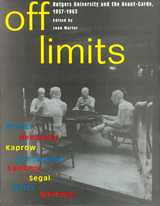 Off Limits: Rutgers University and the Avant-Garde, 1957-1963
Marter, Joan
Rutgers University Press, 1999 Off Limits is the first examination of the Rutgers group, artists who came together on the Rutgers University, New Brunswick campus during the 1950s and revolutionized art practices and pedagogy. Based on interviews with artists, critics, and dealers from the period, the book connects the initiation of major trends such as Happenings, Pop Art, and Fluxus to the faculty, students, art curriculum, and events at the university. It is the first book to look not only at the work of individual artists, but to consider how interactions between these artists influenced their groundbreaking work. Rutgers was clearly the place to be for experimental artists during the late 1950s and early 1960s. Allan Kaprow’s first Happening was presented at Rutgers. Roy Lichtenstein’s first Pop paintings, George Segal’s earliest figurative tableaux, Lucas Samaras’s radical exploration of media, and proto-Fluxus events by Robert Watts and George Brecht all took place on and around the campus. The innovative group rejected Abstract Expressionism for art based on the immediate experience of urban and industrial life, creating startling new artforms which remain startling and provocative. Led by the theoretical writings and art practice of Kaprow, the group created a New Art—art beyond the limits of the conventional and predictable, even beyond accepted notions of progressive trends. Lichtenstein recalls in an interview, “Kaprow showed us that art didn’t have to look like art.” Along with Lichtenstein, Kaprow, Segal, and Watts taught at Rutgers and challenged one another to take art “Off Limits” — beyond the limits of the conventional, the predictable — even beyond the progressive, as defined by Abstract Expressionist gesturalism. Their art incorporated the gritty environs, the technological, the everyday, making art radical, outrageous, disturbing, and humorous.
Off Message
Joel Brouwer
Four Way Books, 2016 In fiber-optic-fast meditations on everything from Marxism to the Marianas Trench, Off Message probes the troubling corners of our globalized lives with humor, pathos, and verve. Political without being preachy, contemporary without being cloying, funny without being flip, these poems are unafraid to implicate themselves: like us, their speakers are part of the problem, and their struggles highlight the absurdities of broadband capitalism. What should we think of televised warfare, crackdowns on Twitter, and factory farms? What pages should we take from our history books? Off Message wrestles with questions like these by overlaying the near and the far, the lyric and the encyclopedic. Each poem is a mixtape, an abandoned essay, a satire of modern conscience.
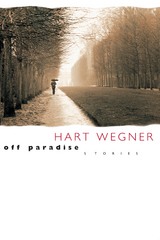 Off Paradise: Stories
Hart Wegner
University of Nevada Press, 2001 Martin, the central character of Hart Wegner's powerful short-story cycle, is a middle-aged German emigre who has found a home, of sorts, in the isolated and often surreal setting of contemporary Las Vegas. Exiled at the end of World War II with his parents from their beloved Silesia, the family struggles to come to terms with the turmoil of history and memory while they cope with the challenges of assimilation in an alien setting.
In stories that range from the Nevada desert to the lost world of prewar Silesia, Wegner explores, through the perspectives of Martin, his aging parents, and their small circle of fellow emigres, the intricate tapestry of the exile experience--childhood recollections of the vast and fertile plains of East Germany and the shelter of comfortable and loving homes, memories of the horrors of war, the guilt and terror and despair of displacement, the frustrations of finding one's way in a new and alien culture, the precious ties of family and longtime friendship. And most of all, loss--the loss of home; of an identity formed by an ancient language, the details of a shared culture, and a common sense of past and of future; of loved ones; and finally, and most tragically, of memory itself.
Wegner's characters are vividly and bravely human, bitter, tender, despairing, and full of hope. And ever-seeking a new home, a new place in which to belong after their long sojourn in the wilderness. The inner world of the exile has never been examined with such sympathy, such clarity, or such eloquence.
The Off Season
Amy Hoffman
University of Wisconsin Press, 2019 When Nora Griffin, an artist in her midthirties, moves from Brooklyn to Provincetown, she isn't looking for trouble. Her partner, Janelle, is recovering from breast cancer treatment, and together they've decided that the quiet off-season on the tip of Cape Cod is the perfect place for Janelle to heal and Nora to paint. Then charismatic Baby Harris flirts into Nora's life in her red cowboy boots.
In the damp, windy winter, Nora contends with heartbreak, aging, and local environmental worries, while painting what she hopes will be her masterpiece. Along the way, she encounters the chain-smoking, motor scooter–driving landlady Miss Ruby; Reverend Patsy, the vegan minister of the Unitarian church; and Brunhilde, barista extraordinaire and rival for Baby's affections. As the first tourists begin to arrive in June, Nora must decide what she really wants from life.
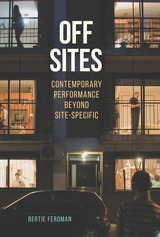 Off Sites: Contemporary Performance beyond Site-Specific
Bertie Ferdman
Southern Illinois University Press, 2018 Honorable Mention, ATHE's 2018 Outstanding Book Award
Contextualizing the techniques and methods of the incredibly rich and vital genre of site-specific performance, author Bertie Ferdman traces the evolution of that term. Originally used for experimental staging practices and then later also for engaged situational events, site-specific is no longer sufficient for the genre’s many contemporary variations.
Using the term off-site, Ferdman illustrates five distinct ways artists have challenged the disciplinary framework of site-specific theatre: blurring the traditional boundaries between the fictional and the real; changing how the audience and actor interact with each other and whether they are physically together or apart; fabricating sites from physically bound, conceptually constructed, or virtual spaces; staging live situations in real/nonreal and often mediated encounters; and challenging our preconceived notions of time and space. Tracing the genealogy of site-based work through the twentieth and twenty-first centuries, Ferdman outlines the theoretical groundwork for her study in the introduction. Individual chapters focus on distinct types of off-sites—the interdisciplinary discourse of disciplinary sites; the spaces of audience engagement with spectator sites; the dislocation of time for temporal sites; and the historiographical spaces of mapping for urban sites.
Ferdman examines site-based work being done in the Americas by contemporary companies and artists experimenting with new forms and practices for site-driven theatre. Key productions discussed include Private Moment by David Levine, Geyser Land by Mary Ellen Strom and Ann Carlson, Jim Findlay’s Dream of the Red Chamber, and Lola Arias’ Mi Vida Después.
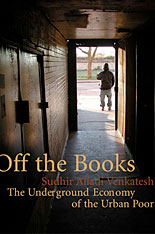 Off the Books: The Underground Economy of the Urban Poor
Sudhir Alladi Venkatesh
Harvard University Press, 2006 In this revelatory book, Sudhir Venkatesh takes us into Maquis Park, a poor black neighborhood on Chicago’s Southside, to explore the desperate, dangerous, and remarkable ways in which a community survives. We find there an entire world of unregulated, unreported, and untaxed work, a system of living off the books that is daily life in the ghetto. From women who clean houses and prepare lunches for the local hospital to small-scale entrepreneurs like the mechanic who works in an alley; from the preacher who provides mediation services to the salon owner who rents her store out for gambling parties; and from street vendors hawking socks and incense to the drug dealing and extortion of the local gang, we come to see how these activities form the backbone of the ghetto economy.
What emerges are the innumerable ways that these men and women, immersed in their shadowy economic pursuits, are connected to and reliant upon one another. The underground economy, as Venkatesh’s subtle storytelling reveals, functions as an intricate web, and in the strength of its strands lie the fates of many Maquis Park residents. The result is a dramatic narrative of individuals at work, and a rich portrait of a community. But while excavating the efforts of men and women to generate a basic livelihood for themselves and their families, Off the Books offers a devastating critique of the entrenched poverty that we so often ignore in America, and reveals how the underground economy is an inevitable response to the ghetto’s appalling isolation from the rest of the country.
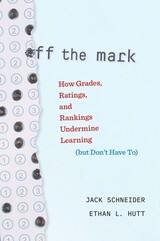 Off the Mark: How Grades, Ratings, and Rankings Undermine Learning (but Don’t Have To)
Jack Schneider and Ethan L. Hutt
Harvard University Press, 2023 Amid widespread concern that our approach to testing and grading undermines education, two experts explain how schools can use assessment to support, rather than compromise, learning.
Anyone who has ever crammed for a test, capitulated to a grade-grubbing student, or fretted over a child’s report card knows that the way we assess student learning in American schools is freighted with unintended consequences. But that’s not all. As experts agree, our primary assessment technologies—grading, rating, and ranking—don’t actually provide an accurate picture of how students are doing in school. Worse, they distort student and educator behavior in ways that undermine learning and exacerbate inequality. Yet despite widespread dissatisfaction, grades, test scores, and transcripts remain the currency of the realm.
In Off the Mark, Jack Schneider and Ethan Hutt explain how we got into this predicament, why we remain beholden to our outmoded forms of assessment, and what we can do to change course. As they make clear, most current attempts at reform won’t solve the complex problems we face. Instead, Schneider and Hutt offer a range of practical reforms, like embracing multiple measures of performance and making the so-called permanent record “overwritable.” As they explain, we can remake our approach in ways that better advance the three different purposes that assessment currently serves: motivating students to learn, communicating meaningful information about what young people know and can do, and synchronizing an otherwise fragmented educational system. Written in an accessible style for a broad audience, Off the Mark is a guide for everyone who wants to ensure that assessment serves the fundamental goal of education—helping students learn.
Off the Record: The Private Papers of Harry S. Truman
Edited by Robert H. Ferrell
University of Missouri Press, 1997 Gathered for the first time, Truman's private papers--diaries, letters, and memoranda--cover the period from his occupancy of the White House in 1945 to shortly before his death in 1972. Students and scholars will find valuable material on major events of the Truman years, from the Potsdam Conference to the Korean War.
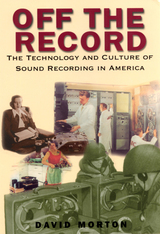 Off the Record: The Technology and Culture of Sound Recording in America
Morton, David
Rutgers University Press, 1999 David L. Morton examines the process of invention, innovation, and diffusion of communications technology, using the history of sound recording as the focus. Off the Record demonstrates how the history of both the hardware and the ways people used it is essential for understanding why any particular technology became a fixture in everyday life or faded into obscurity. Morton’s approach to the topic differs from most previous works, which have examined the technology’s social impact, but not the reasons for its existence. Recording culture in America emerged, Morton writes, not through the dictates of the technology itself but in complex ways that were contingent upon the actions of users. Each of the case studies in the book emphasizes one of five aspects of the culture of recording and its relationship to new technology, at the same time telling the story of sound recording history. One of the misconceptions that Morton hopes to dispel is that the only important category of sound recording involves music. Unique in his broad-based approach to sound technology, the five case studies that Morton investigates are : - The phonograph record
- Recording in the radio business
- The dictation machine
- The telephone answering machine, and
- Home taping
Readers will learn, for example, that the equipment to create the telephone answering machine has been around for a century, but that the ownership and use of answering machines was a hotly contested issue in the telephone industry at the turn of the century, hence stifling its commercial development for decades. Morton also offers fascinating insight into early radio: that, while The Amos and Andy Show initially was pre-recorded and not broadcast live, the commercial stations saw this easily distributed program as an economic threat: many non-network stations could buy the disks for easy, relatively inexpensive replaying. As a result, Amos and Andy was sold to Mutual and went live shortly afterward.
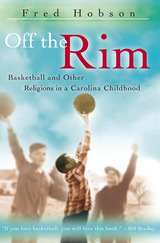 Off the Rim: Basketball and Other Religions in a Carolina Childhood
Fred Hobson
University of Missouri Press, 2006 “Why should a particular game, played with a round ball by twenty-year-olds in short pants often hundreds of miles away, mean so much to me, since I seem to have so little to gain or lose by its outcome?” Fred Hobson thus begins Off the Rim, his narrative of college basketball and society, of growing up and not growing up. He seeks the answer to this question by delving into the particulars of his own experience. Growing up in a small town in the hills of North Carolina where basketball was king, he became a rabid UNC basketball fan (like many others) at the tender age of thirteen during the Tar Heels’ “magical” 32–0 national championship season in 1956–1957. He starred as a high school basketball player and lived a dream by “walking on” the highly successful 1961–1962 Carolina freshman team. That was also the year Dean Smith was elevated to head coach of the Heels. Hobson observed firsthand Coach Smith’s difficult early days before he became the winningest coach in college basketball. Forced to find a substitute for his beloved sport after not making the varsity his sophomore year, Hobson turned to the romance of books, both reading and writing them. Changing his major to English, he discovered the joys of William Faulkner and Richard Wright, Robert Penn Warren, Flannery O'Connor, and H. L. Mencken, and made a career teaching American literature. This is a book about basketball that is more than a book about basketball. It is, in the beginning, a depiction of a part of the South that departs from the usual idea of Dixie, a look into the culture, religion, and politics of the Carolina hills. It is a portrait of the people who made up the South, including the author’s parents, who both were and were not conventional southerners. Finally, in some respects, it is the story of a boyhood that never ends, relived each year during basketball season in the frantic, tortured life of a fan. Although Hobson’s story is largely about the Tar Heels—and about other things related to growing up in the South of the 1950s—what he says about basketball, childhood, and adulthood also holds true for those who find themselves in emotional bondage to Hoosiers or Bulldogs or Ducks, to Wolverines, Gophers, Badgers, and various other species of Upper Midwestern low-lying ground fauna, to Blue Devils or Blue Demons, to Tigers, Wildcats, Cougars, and all other breeds of cat.
 Off the Walls: Inspired Re-Creations of Iconic Artworks
Sarah Waldorf
J. Paul Getty Trust, The, 2020 When life (in a global pandemic) imitates art . . .
Van Gogh’s Starry Night made out of spaghetti? Cat with a Pearl Earring? Frida Kahlo self-portraits with pets and toilet paper? While the world reeled from the rapid spread of the novel coronavirus (COVID-19), thousands of people around the globe, inspired by challenges from Getty and other museums, raided toy chests, repurposed pantry items, and enlisted family, roommates, and animals to re-create famous works of art at home. Astonishing in their creativity, wit, and ingenuity, these creations remind us of the power of art to unite us and bring joy during troubled times. Off the Walls: Inspired Re-Creations of Iconic Artworks celebrates these imaginative re-creations, bringing highlights from this challenge together in one whimsical, irresistible volume. Getty Publications will donate all profits from the sale of this book to a charity supporting art and artists.
Off to a Good Start: Social and Emotional Development of Memphis’ Children
Laurie T. Martin
RAND Corporation, 2015 Drawing on national, state, and local data, the Urban Child Institute partnered with RAND to explore the social and emotional well-being of children in Memphis and Shelby County, Tenn. The book highlights the importance of factors in the home, child care setting, and community that contribute to social and emotional development.
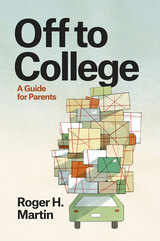 Off to College: A Guide for Parents
Roger H. Martin
University of Chicago Press, 2015 For many parents, sending their child off to college can be a disconcerting leap. After years spent helping with homework, attending parent-teacher conferences, and catching up after school, college life represents a world of unknowns. What really happens during that transitional first year of college? And what can parents do to strike the right balance between providing support and fostering independence?
With Off to College, Roger H. Martin helps parents understand this important period of transition by providing the perfect tour of the first year on today’s campus. Martin, a twenty-year college president and former Harvard dean, spent a year visiting five very different colleges and universities across the United States—public and private, large and small, elite and non-elite—to get an insider’s view of modern college life. He observes an advising session as a student sorts out her schedule, unravels the mysteries of roommate assignments with a residence life director, and patrols campus with a safety officer on a rowdy Saturday night. He gets pointers in freshman English and tips on athletics and physical fitness from coaches. He talks with financial aid officers and health service providers. And he listens to the voices of the first–year students themselves. Martin packs Off to College with the insights and advice he gained and bolsters them with data from a wide variety of sources to deliver a unique and personal view of the current student experience.
The first year is not just the beginning of a student’s college education but also the first big step in becoming an adult. Off to College will help parents understand what to expect whether they’re new to the college experience or reconciling modern campus life with memories of their own college days.
 Off Whiteness: Place, Blood, and Tradition in Post-Reconstruction Southern Literature
Izabela Hopkins
University of Tennessee Press, 2020 In Off Whiteness: Place, Blood, and Tradition in Post-Reconstruction Southern Literature, Izabela Hopkins explores the remaking of whiteness in the Post-Reconstruction South as represented in literary fiction. To focus her study, she discusses the writings of four prominent figures: Thomas Nelson Page, Ellen Glasgow, Charles Waddell Chesnutt, and Alice Dunbar-Nelson, who contributed to discussions of racial and social identity during the post–Civil War South through poetry, journalism, essays, novels, and more.
Off Whiteness draws from both sides of the color line—as well as from both the male and female experience—to examine the ambivalence of Southern whiteness from three particular vantage points: place, ideality, and repeatability. Hopkins develops her analysis across nine chapters divided into three parts. In her exploration of these four writers with differing backgrounds and experiences, she utilizes both their well-known and lesser-known texts to argue against the superficial oversimplification that “whiteness requires blackness to define itself.”
Hopkins’s analysis not only successfully grapples with a wide range of post-structural theories; it also approaches the significance of language and religion with intention and sensitivity, thereby addressing areas that are typically ignored in whiteness studies scholarship. The interdisciplinary nature of Off Whiteness positions it as an engaging text relevant to the work and interests of scholars drawn to American and Southern history, cultural and social studies, literary studies, etymology, and critical race theory.
The Offbeat: Collecting Glances
Kristen DeMay
Michigan State University Press, 2005
The Offbeat is an independent literary series devoted to publishing a diverse collection of voices,and to promoting contactand discussion among Michigan writers. The Offbeat is run entirely by Michigan State University undergraduates, and is centered in East Lansing. Student editors encourage contributions by all individuals with a Michigan connection, past and present, visitor and resident, urban and rural, student and non-student alike. The Offbeat’s goal is to provide an alternative literary outlet for all Michigan writers.
The Offbeat: Eschew Obfuscation
Theresa Mlinarcik
Michigan State University Press, 2003
The Offbeat literary collection series is devoted to publishing a diverse selection of voices and to promoting contact and discussion among writers. The Offbeat is run entirely by Michigan State University students, with the goal of providing an alternative literary outlet for Michigan writers.
This edition features an interview with noted author, W. S. Penn, plus a selection of original fiction, prose, and poetry from a variety of authors, including Daniel Klass, Timothy Carmody, Joshua Moon, Robert Brady, Mark Geralds, Andrew Hungerford, Jeremy Campbell, Gavin Craig, Ashley Honeysett, Andy McGashen, Colleen Farrow, Crystal Passmore, Jogn Garcia, De'Juan McDuell, Gregory Wright, Bailey Follette, and Brandon Connell.
The Offbeat: Fully Clothed
Kristen DeMay
Michigan State University Press, 2006
The Offbeat is an independent literary series devoted to publishing a diverse collection of voices, and to promoting contact and discussion among Michigan writers. The Offbeat is run entirely by Michigan State University undergraduates, and is centered in East Lansing. Student editors encourage contributions by all individuals with a Michigan connection, past and present, visitor and resident, urban and rural, student and non student alike. The Offbeat’s goal is to provide an alternative literary outlet for all Michigan writers.
The Offbeat: I Have Been Sometimes True to Nothing
Theresa Mlinarcik
Michigan State University Press, 2003
The Offbeat is an independent literary series devoted to publishing a diverse collection of voices, and to promoting contact and discussion among Michigan writers. The Offbeat is run entirely by Michigan State University undergraduates, and is centered in East Lansing. Student editors encourage contributions by all individuals with a Michigan connection, past and present, visitor and resident, urban and rural, student and non-student alike. The Offbeat' goal is to provide an alternative literary outlet for all Michigan writers. The Offbeat presents, encourages, and explores creative works in fiction, poetry, drama, essay, criticism, image, and that which defies categorization. Its purpose is to call attention to voices both emerging and established, including those that have been previously overlooked.
The Offbeat: Noise from Typewriter Keys
Goldie Currie
Michigan State University Press, 2010
Noise from Typewriter Keys is the tenth volume in the independent literary series, The Offbeat, devoted to publishing a diverse collection of voices, and to promoting contact and discussion among writers. The Offbeat is run entirely by Michigan State Undergraduates, and is centered in East Lansing. The mission of The Offbeat is to provide an alternative literary outlet for writers from Michigan and beyond, and to call attention to voices both emerging and established.
The Offbeat: Noise from Typewriter Keys is an ensemble of voices and eruptions heard from the inside and out. This volume includes a wide variety of writers and focuses on the ambition of new creation. This part of the series seeks to capture movement of a writer while exploring the varied sounds that come from imagination.
The Offbeat: Tell Me Everything
Kristen DeMay
Michigan State University Press, 2007
The Offbeat is an independent literary series devoted to publishing a diverse collection of voices, and to promoting contactand discussion among Michigan writers. The Offbeat is run entirely by Michigan State University undergraduates, and is centered in East Lansing. Student editors encourage contributions by all individuals with a Michigan connection, past and present, visitor and resident, urban and rural, student and non-student alike. The Offbeat's goal is to provide an alternative literary outlet for all Michigan writers.
The Offbeat: Unvarnished Voices
Kristen DeMay
Michigan State University Press, 2004
The Offbeat is a literary collection series devoted to publishing a diverse selection of voices and to promoting contact and discussion among writers. The Offbeat is run entirely by Michigan State University students, with the goal of providing an alternative literary outlet for Michigan writers.
This edition contains work by Steven Rajewski, Erin Ashmore, Neil Kennedy, Victoria Henderson, Mary Helmic, Rebecca Klein, Jamie Miller, Ken Sleight, Laura Tisdel, and many others.
The Offbeat: With Abandon
Chris Cobb
Michigan State University Press, 2008
With Abandon is the eighth volume in the independent literary series, The Offbeat, devoted to publishing a diverse collection of voices, and to promoting contact and discussion among writers. The Offbeat is run entirely by Michigan State Undergraduates, and is centered in East Lansing. The mission of The Offbeat is to provide an alternative literary outlet for writers from Michigan and beyond, and to call attention to voices both emerging and established.
The Offbeat: With Abandon features a wide array of writing that cuts across genres, highlighting the best work by authors ranging from professional journalists to undergraduate writers. Thrown into the mix are voices from professors of literature, graduate students in creative writing, and even a few of our editorial staff. In this volume, writing is an act of faith, a documentation of the joy and terror of life, and above all, an act of witness.
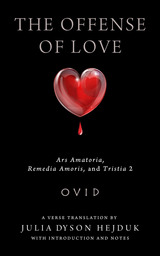 The Offense of Love: Ars Amatoria, Remedia Amoris, and Tristia 2
Ovid, A verse translation by Julia D. Hejduk, with introduction and notes
University of Wisconsin Press, 2014 Ovid's Art of Love (Ars Amatoria) and its sequel Remedies for Love (Remedia Amoris) are among the most notorious poems of the ancient world. In AD 8, the emperor Augustus exiled Ovid to the shores of the Black Sea for "a poem and a mistake." Whatever the mistake may have been, the poem was certainly the Ars Amatoria, which the emperor found a bit too immoral.
In exile, Ovid composed Sad Things (Tristia), which included a defense of his life and work as brilliant and cheeky as his controversial love manuals. In a poem addressed to Augustus (Tristia 2), he argues, "Since all of life and literature is one long, steamy sex story, why single poor Ovid out?" While seemingly groveling at the emperor's feet, he creates an image of Augustus as capricious tyrant and himself as suffering artist that wins over every reader (except the one to whom it was addressed).
Bringing together translations of the Ars Amatoria, Remedia Amoris, and Tristia 2, Julia Dyson Hejduk's The Offense of Love is the first book to include both the offense and the defense of Ovid's amatory work in a single volume. Hejduk's elegant and accurate translations, helpful notes, and comprehensive introduction will guide readers through Ovid's wickedly witty poetic tour of the literature, mythology, topography, religion, politics, and (of course) sexuality of ancient Rome.
Finalist, National Translation Award, American Literary Translators Association
A Choice Outstanding Academic Book
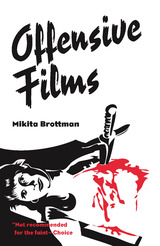 Offensive Films
Mikita Brottman
Vanderbilt University Press, 2005 Brottman offers up a study of movies so offensive, some are practically unwatchable. From the ever-popular Faces of Death movies to purported snuff films, from classic B-movies such as The Tingler, to more popular but no less controversial films such as The Texas Chainsaw Massacre, Brottman takes a wide-eyed look at movies most folks watch only through parted fingers.
While most critics have been quick to dismiss such films as mere shock-fests (if they even bother to talk about them at all), Brottman argues that these movies tell us quite a bit about who we are as a society, what makes us anxious, and what taboos we truly believe cannot be crossed. Part anthropology, part psychoanalysis, Offensive Films vivisects these movies in order to figure out just what about them is so offensive, obscene, or bizarre. In the end, Brottman proves that these films, shunned from the cinematic canon, work on us in sophisticated ways we often choose to remain unaware of.
 The Offensive Internet: Speech, Privacy, and Reputation
Saul Levmore
Harvard University Press, 2012 The Internet has been romanticized as a zone of freedom. The alluring combination of sophisticated technology with low barriers to entry and instantaneous outreach to millions of users has mesmerized libertarians and communitarians alike. Lawmakers have joined the celebration, passing the Communications Decency Act, which enables Internet Service Providers to allow unregulated discourse without danger of liability, all in the name of enhancing freedom of speech. But an unregulated Internet is a breeding ground for offensive conduct.
At last we have a book that begins to focus on abuses made possible by anonymity, freedom from liability, and lack of oversight. The distinguished scholars assembled in this volume, drawn from law and philosophy, connect the absence of legal oversight with harassment and discrimination. Questioning the simplistic notion that abusive speech and mobocracy are the inevitable outcomes of new technology, they argue that current misuse is the outgrowth of social, technological, and legal choices. Seeing this clearly will help us to be better informed about our options.
In a field still dominated by a frontier perspective, this book has the potential to be a real game changer. Armed with example after example of harassment in Internet chat rooms and forums, the authors detail some of the vile and hateful speech that the current combination of law and technology has bred. The facts are then treated to analysis and policy prescriptions. Read this book and you will never again see the Internet through rose-colored glasses.
 Offering Hospitality: Questioning Christian Approaches to War
Caron E. Gentry
University of Notre Dame Press, 2013
In Offering Hospitality: Questioning Christian Approaches to War, Caron E. Gentry reflects on the predominant strands of American political theology—Christian realism, pacifism, and the just war tradition—and argues that Christian political theologies on war remain, for the most part, inward-looking and resistant to criticism from opposing viewpoints.
In light of the new problems that require choices about the use of force—genocide, terrorism, and failed states, to name just a few—a rethinking of the conventional arguments about just war and pacifism is timely and important. Gentry’s insightful perspective marries contemporary feminist and critical thought to prevailing theories, such as Christian realism represented in the work of Reinhold Niebuhr and the pacifist tradition of Stanley Hauerwas. She draws out the connection between hospitality in postmodern literature and hospitality as derived from the Christian conception of agape, and relates the literature on hospitality to the Christian ethics of war. She contends that the practice of hospitality, incorporated into the jus ad bellum criterion of last resort, would lead to a “better peace.”
Gentry’s critique of Christian realism, pacifism, and the just war tradition through an engagement with feminism is unique, and her treatment of failed states as a concrete security issue is practical. By asking multiple audiences—theologians, feminists, postmodern scholars, and International Relations experts—to grant legitimacy and credibility to each other’s perspectives, she contributes to a reinvigorated dialogue.
"This is a bold and brave book that tackles weighty matters pertaining to violence and community with a deft touch. Caron Gentry’s perspective, which marries contemporary feminist and critical thought to Christian realist, just war, and pacifist concerns, is fresh and insightful. She succeeds wonderfully in carving out a space that relates the literature on hospitality to the contemporary ethics of war. This book will be of major interest to scholars working in theology, international relations, political theory, and religious ethics." —Cian O'Driscoll, University of Glasgow
"Caron Gentry offers a daring constructive moral proposal here calling for a reconstruction of the just war ethic’s criterion of last resort as a platform for embodying a deep form of Christian hospitality in international affairs. Along the way she analyzes the work of Reinhold Niebuhr, Stanley Hauerwas, and Jean Bethke Elshtain. A must read for students of political theology, international relations, and feminist theory." —Shaun Casey, Wesley Theological Seminary
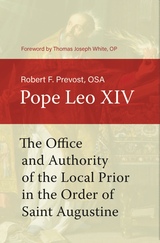 The Office and Authority of the Local Prior in the Order of Saint Augustine
Robert F. Prevost
Catholic University of America Press, 2025 As a young priest, Robert Prevost was sent in 1981 to Rome to study church law at the Pontifical University of Saint Thomas (known as the Angelicum). There he earned a licentiate and composed a doctoral thesis, which made final in 1987. This is that thesis, the first book-length work composed by the man now known as Pope Leo XIV.
Specifically, his study— drawing from sources in English, Italian, and Spanish and from medieval history and theology as well as canon law —focused on the role of the prior as the local superior in the Order of St. Augustine. In doing so, he describes a traditional notion of obedience in religious life -- one based on love of the truth and growth in one's inner freedom to pursue holiness. At the center of his reflection are key ideas regarding the common good of the Church; the Eucharistic liturgy at the center of the life of the community; the role of hierarchy and consultation; and mutual respect for the diverse contributions of each person. Present in this text, moreover, is a far-reaching conception of the priesthood characterized by the triple munera: the priestly work of teaching, sanctification, and governance. Central to the whole volume is an Augustinian conception of the spiritual life that focuses on the inward work of grace, the primacy of the love of God, and inward conformity to Christ.
The book's preface—composed by eminent theologian and present-day rector of the Angelicum, Fr. Thomas Joseph White, OP—helps frame the work for the wider public interested in it as a privileged window into the mind and heart of Prevost as a young priest, showing how its subject matter has implications for how one thinks about the life of the Catholic Church. There are clearly in this early work central themes regarding the life of Church, the apostolic tradition, and ecclesial authority in the service of the common good, that may well indicate directions and themes in the subsequent life and teaching of the author. Canonists will be drawn to Prevost's analysis of the Constitutions of the Augustinians in light of the then-newly promulgated Code of Canon Law. Historians and theologians alike may enjoy considering parallelisms that occur between this Augustinian vision of the prior and the subsequent unfolding of an Augustinian pontificate. Hopefully the publication of this work will lead to constructive debate about and comprehension of the relation of between the two.
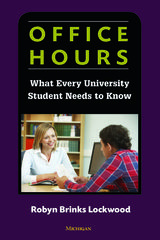 Office Hours: What Every University Student Needs to Know
Robyn Brinks Lockwood
University of Michigan Press, 2019 The university office hour interaction is new to everyone who attends a university. Not knowing what to do or when to go is not unique to international students. Office Hours: What Every University Student Needs to Know sets out to demystify the entire process of office hours—the purpose and goals of these meetings, how to plan for them, and even determining whether to visit the professor or send an email. Information about “group” office hours, which are becoming more common, is also included. This task-based book also describes the five moves, or parts, of an office hour interaction and provides many examples and tasks to help guide students through this important communicative aspect of academic life. It seeks to ensure that every office hour interaction ends on a positive note. Reflection questions for new teaching assistants are included throughout, making this ideal for TA workshops. Four analysis tasks are included to accompany the four videos that explore various student-professor interactions. The videos are available online at www.press.umich.edu/elt/compsite/officehours.
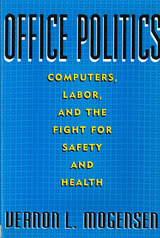 Office Politics: Computers, Labor, and the Fight for Safety and Health
Mogensen, Vernon L
Rutgers University Press, 1996 The desktop computer has transformed office work. Business and social forecasters claimed that the use of video display terminals (VDTs) in the “Office of the Future” would free workers from routine tasks, giving them more time for creative work and chances for career advancement. Office Politics argues that, for many VDT workers––most of whom are nonunionized women in low-paying, dead-end jobs––exactly the opposite has been true. VDTs have been used to routinize office tasks; export work via satellite to low-wage, nonunion offshore offices; to de-skill workers and monitor their productivity. And the nature of the work has led to widespread health and safety problems, including vision, musculoskeletal (repetitive motion), and stress-related illnesses. Many have also charged that the electromagnetic fields (EMFs) emitted by computer terminals are responsible for miscarriages, for birth defects, and for promoting cancer. As office workers sought to protect themselves against these new occupational health and safety problems, they found little help from organized labor, business, or the government. Office Politics is the first book to explain why. It shows how corporate interests successfully redefined the VDT health and safety crisis as a “comfort” problem, how the government refused to collect data on the true scope of VDT-related illnesses or to regulate Information Age industries, and how labor unions ignored women workers. Office Politics is key reading for everyone who works at a computer. It will be of special interest to students, academics, and professionals in political science, sociology, occupational and environmental health, business, labor and management issues, women’s studies, computing, and public policy.
 The Official Earth Day Guide to Planet Repair
Denis Hayes
Island Press, 2000 Everyone talks about the weather but no one ever does anything about it. Sadly, that old joke is no longer true. A large body of increasingly compelling scientific evidence is telling us that many things we do -- from the kinds of cars we drive to how we heat our homes -- are directly affecting our global climate in unprecedented and alarming ways. But what can any one person do about this vast, global problem? Help fix it! And it doesn't have to be a do-it-yourself project; we citizens and stewards of the earth can unite in greater numbers and power than ever before.In The Official Earth Day Guide to Planet Repair, Earth Day leader and renewable energy expert Denis Hayes tells us how changes in individual, local, and national energy choices can slow or even stop the dangerous build-up of greenhouse gases in our atmosphere, while at the same time saving us money, helping the economy, creating new jobs, and enhancing human health. A how-to home improvement guide for the planet, the book: describes the problem of global warming today as well as its likely effects in the future considers the sources of energy available to us, and explains why one of them is the Earth's best hope offers dozens of ways to painlessly reduce your own energy use provides action steps to affect the world's energy use and help change policy tells where to go for further help and more information The first Earth Day in 1970 helped launch the modern environmental movement. Rather than waiting for elected officials to take action to address environmental abuses, environmental maverick Denis Hayes and his compatriots took the lead in bringing the subject to the forefront of American consciousness. Through three decades, the idea of Earth Day has flourished, and now more than ever, individuals need to take matters into their own hands and create change from the ground up and from the whole earth down. As citizens and consumers, we hold a vast capacity for improving our environment and leaving a bright legacy for our children. For seasoned green veterans and environmental newcomers alike, The Official Earth Day Guide to Planet Repair is the must-have book for the next century.
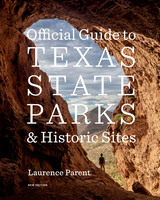 Official Guide to Texas State Parks and Historic Sites: New Edition
By Laurence Parent
University of Texas Press, 2018 Since it was first published in 1996, Official Guide to Texas State Parks and Historic Sites has become Texans’ one-stop source for information on great places to camp, fish, hike, backpack, swim, ride horseback, go rock climbing, view scenic landscapes, tour historical sites, and enjoy almost any other outdoor recreation.
Freshly redesigned, this revised edition includes eight new state parks and historical sites, completely updated information for every park, and beautiful new photographs for most of the parks. The book is organized by geographical regions to help you plan your trips around the state. For every park, Laurence Parent provides all of the essential information:
- The natural or historical attractions of the park
- Types of recreation offered
- Camping and lodging facilities
- Addresses and phone numbers
- Magnificent color photographs
So if you want to watch the sun set over Enchanted Rock, fish in the surf on the beach at Galveston, or listen for a ghostly bugle among the ruins of Fort Lancaster, let this book be your complete guide. Don’t take a trip in Texas without it.
 Official Guide to Texas State Parks and Historic Sites: New Edition
Laurence Parent
University of Texas Press, 2024 The essential guide to Texas’s state parks and historic sites. Updated with a new park, Palo Pinto Mountains State Park west of Forth Worth; new historic sites; and scores of beautiful new photographs, the Official Guide to Texas State Parks has all the essential information organized by geographical regions to help you plan your great Texas adventure. The only complete resource of its kind on Texas, Laurence Parent’s Official Guide to Texas State Parks is the trusted source, with more than sixty-five thousand copies sold over the past thirty years. Praise for Previous Editions “Texas state-park fans should be thrilled. . . . Official Guide to Texas State Parks is the ultimate book detailing Texas’s state parks.”—Dallas Morning News “This book will make you want to hit the road to visit the natural splendor of Texas.”—Houston Chronicle “It’s good enough for a coffee table or a campfire. The Official Guide to Texas State Parks gives you sleek photography, maps, narratives, and loads of information.”—Southern Living “The newly updated Official Guide to Texas State Parks and Historic Sites . . . has beautiful color photographs and insights on camping, fishing, horseback riding, and other recreational opportunities around the state.”—Texas Journey
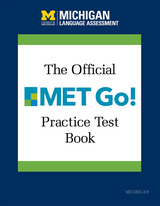 The Official MET Go! Practice Test Book
Michigan Language Assessment
University of Michigan Press, 2019 The MET Go! is a standardized international examination designed by Michigan Language Assessment (MLA), aimed at beginner- to intermediate-level adolescent language learners—A1 to B1 of the Common European Framework of Reference (CEFR) for Languages. It assesses general English language proficiency in educational, social, and everyday contexts and emphasizes the ability of the test-taker to communicate effectively in English. The MET Go! is intended for early adolescents at the middle school to lower-secondary school level who want to measure their general English language proficiency in a variety of linguistic contexts. The test results can be used for educational purposes, such as when finishing an English language course, as a motivational tool to encourage students as they progress in their English study, or as a supporting credential for youth opportunities requiring English skills. It may also be used as a bridge to a higher-level exam such as the MET. The Official MET Go! Practice Test Book is first book to provide actual practice tests for students preparing to take the MET Go! The Official MET Go! Practice Test Book includes: - 4 complete practice tests (Listening, Reading, Writing)
- 4 sets of practice Speaking Test prompts
- tips for practicing the different sections of the tests
- a progress tracking log for recording practice test cores
- actual test form instructions and a sample answer sheet
The audio for the Listening section can be accessed at www.press.umich.edu/elt/compsite/metgo. More information about the MET Go! is available at www.michiganassessment.org.
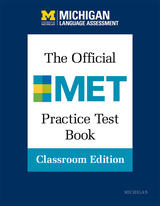 The Official MET Practice Test Book, Classroom Edition
Michigan Language Assessment
University of Michigan Press, 2019 The Michigan English Test (MET) is a standardized international examination designed by Michigan Language Assessment and aimed at upper-beginner to advanced levels—A2 to C1 of the Common European Framework of Reference for Languages. The test assesses general English language proficiency in educational, social, and workplace contexts. The MET is intended for adults and adolescents at or above a secondary level of education who want to measure their general English language proficiency in a variety of linguistic contexts. The test results can be used for educational purposes, such as when finishing an English language course, or for employment purposes, like when applying for a job or pursuing a promotion that requires an English language qualification. The Official MET Practice Test Book is the first book to provide specific test-preparation materials for the MET. The Classroom Edition, designed for school use (the self-study version can be found at https://www.press.umich.edu/11390380/official_met_practice_test_book_with_answers), includes: - 4 complete practice tests (Listening, Reading and Grammar, Writing)
- 4 sets of Speaking test prompts
- tips for preparing for the different sections of the tests
- a progress tracking log for recording practice test scores
- selected practice test vocabulary lists
- actual test form instructions and a sample answer sheet
The audio for the Listening section can be accessed online at https://umichigan.pressbooks.pub/metpracticeclassroom/. For more information about the MET, go to www.michiganassessment.org
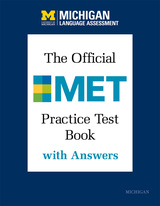 The Official MET Practice Test Book with Answers
Michigan Language Assessment
University of Michigan Press, 2019 The Michigan English Test (MET) is a standardized international examination designed by Michigan Language Assessment and aimed at upper-beginner to advanced levels—A2 to C1 of the Common European Framework of Reference for Languages. The test assesses general English language proficiency in educational, social, and workplace contexts. The MET is intended for adults and adolescents at or above a secondary level of education who want to measure their general English language proficiency in a variety of linguistic contexts. The test results can be used for educational purposes, such as when finishing an English language course, or for employment purposes, like when applying for a job or pursuing a promotion that requires an English language qualification. The Official MET Practice Test Book is the first book to provide actual practice tests for students preparing to take the MET. The Official MET Practice Test Book with Answers, designed for self-study (information about the Classroom Edition can be found at https://www.press.umich.edu/11390089/official_met_practice_test_book_classroom_edition), includes: - 4 complete practice tests (Listening, Reading and Grammar, Writing)
- 4 sets of Speaking test prompts
- tips for practicing the different sections of the tests
- a progress tracking log for recording practice test scores
- selected practice test vocabulary lists
- answer keys
- audio transcripts for the Listening section
- Writing test responses with commentary for two of the tests
- Examiner scripts for the Speaking test
- actual test form instructions and a sample answer sheet
The audio for the Listening section can be accessed at www.press.umich.edu/elt/compsite/met For more information about the MET, go to www.michiganassessment.org
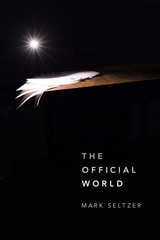 The Official World
Mark Seltzer
Duke University Press, 2016 In his virtuosic new book noted cultural critic Mark Seltzer shows how suspense, as art form and form of life, depicts and shapes the social systems that organize our modern world. Modernity's predicament, Seltzer writes, is a society so hungry for reality that it cannot stop describing itself, and that makes for a world that continuously establishes itself by staging its own conditions. Employing the social theories of Georg Simmel, Erving Goffman, Niklas Luhmann, and Peter Sloterdijk, Seltzer shows how suspense novels, films, and performance art by Patricia Highsmith, Tom McCarthy, Cormac McCarthy, J. G. Ballard, Karl Ove Knausgaard, and others outline how we currently live and reveal the stress-points and mood-systems of the modern epoch. In its focus on social games, depictions of violent and explosive persons, along with its cast of artists, reporters, detectives, and others who observe and report and reenact, the suspense mode creates and recreates modern systems of action and autonomy, and defines the self-turned world's practices and aesthetics. By epitomizing a reflexive, self-legislating, and autonomous world, a suspense art with humans in the systems epoch provides the models and sets the rules for our modern, official world.
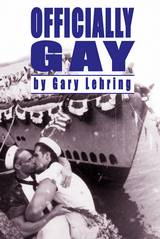 Officially Gay: The Political Construction Of Sexuality
Gary L. Lehring
Temple University Press, 2003 In 1993, simply the idea that lesbians and gays should be able to serve openly in the military created a firestorm of protest from right-wing groups and powerful social conservatives that threatened to derail the entire agenda of a newly elected President. Nine short years later, in the wake of September 11, 2001, the Pentagon's suspension of discharge of gay and lesbians went largely overlooked and unremarked by political pundits, news organizations, military experts, religious leaders and gay activists. How can this collective cultural silence be explained? Officially Gay follows the military's century-long attempt to identify and exclude gays and lesbians. It traces how the military historically constructed definitions of homosexual identity relying upon religious, medical, and psychological discourses that defined homosexuals as evil, degenerate, and unstable, making their risk to national security obvious, and mandating their exclusion from the Armed Services. Officially Gay argues that this process made possible greater regulation and scrutiny of gays and lesbians both in and out of the military while simultaneously helping to create a gay and lesbian political movement and helped shape the direction that movement would take.
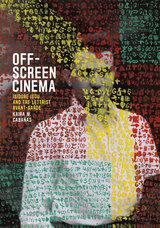 Off-Screen Cinema: Isidore Isou and the Lettrist Avant-Garde
Kaira M. Cabañas
University of Chicago Press, 2015 One of the most important avant-garde movements of postwar Paris was Lettrism, which crucially built an interest in the relationship between writing and image into projects in poetry, painting, and especially cinema. Highly influential, the Lettrists served as a bridge of sorts between the earlier works of the Dadaists and Surrealists and the later Conceptual artists.
Off-Screen Cinema is the first monograph in English of the Lettrists. Offering a full portrait of the avant-garde scene of 1950s Paris, it focuses on the film works of key Lettrist figures like Gil J Wolman, Maurice Lemaître, François Dufrêne, and especially the movement's founder, Isidore Isou, a Romanian immigrant whose “discrepant editing” deliberately uncoupled image and sound. Through Cabañas's history, we see not only the full scope of the Lettrist project, but also its clear influence on Situationism, the French New Wave, the New Realists, as well as American filmmakers such as Stan Brakhage.
The Off-Season
Jen Levitt
Four Way Books, 2016 The poems in The Off-Season are populated with things—'90s TV shows, mixtapes, crosstown buses, winter beaches—signifiers that trace a trajectory from girlhood to adulthood and bring to the surface feelings and desires that ordinarily stay hidden. We witness the strangeness of modern life, relive our own adolescent awkwardness and listen in on conversations with dead poets, TV characters, family members and intimates. With humor, fierceness and generosity, The Off-Season grapples with the question of how to be in the world.
 Offshore Wind Power: Reliability, availability and maintenance
Peter Tavner
The Institution of Engineering and Technology, 2021 The development of offshore wind power has become a pressing energy issue, driven by the need to find new electrical power sources and to reduce the use of fossil fuels. Offshore wind farms can harness tremendous wind resources without annoying citizens and with a comparatively low environmental impact. They are thus becoming a central pillar of a carbon free energy system. However offshore turbines and wind farms are costly to install and maintain, making reliability and cost-effectiveness key issues. This work covers reliability of offshore wind farms as a whole, starting from weather and wind conditions, dealing with wind turbine technology, farm layout, monitoring, safety and maintenance. The thoroughly revised second edition additionally covers turbines of up to 10 MW, turbine design changes, turbine converters, HVDC converter stations and DC links, offshore sub-sea collector and export cables, and the structures supporting large offshore wind farms.
Offshore Wind Turbines: Reliability, availability and maintenance
Peter Tavner
The Institution of Engineering and Technology, 2012 The development of offshore wind power has become a pressing modern energy issue in which the UK is taking a major part, driven by the need to find new electrical power sources, avoiding the use of fossil fuels, in the knowledge of the extensive wind resource available around our islands and the fact that the environmental impact of offshore wind farms is likely to be low.
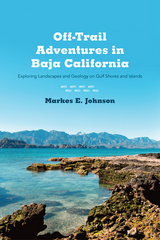 Off-Trail Adventures in Baja California: Exploring Landscapes and Geology on Gulf Shores and Islands
Markes E. Johnson
University of Arizona Press, 2014 Baja California is one of the Earth’s last great wilderness areas that is easily accessible to travelers. Whether you enter from the United States to the north or from Cabo San Lucas to the south, it doesn’t take long to find yourself passing through a unique desert ecosystem of islands and land bound by the Pacific Ocean on the west and the Gulf of California on the east. But where, you might ask, can you go to best experience the physical majesty of Baja California? This book holds the answer.
Off-Trail Adventures in Baja California describes—and maps and illustrates—nine hikes along outcrops on islands and peninsular shores where geography, geology, and ecology meet in singular ways. Each spot tells a story about the nature of the place—the cumulative effects of millions of years of natural forces at work. During the course of his long teaching career, Markes E. Johnson has hiked much of Baja California, often with students in tow. He brings a lifetime of study to his simple descriptions of the stories that are revealed by looking closely at natural phenomena framed by rocks and fossils.
This hiking guide offers a wealth of stories that seem to encompass everything, and can clearly communicate Johnson’s deep understanding of how our planet’s ecosystems function. Whether you like to hike with your boots on or from the comfort of your favorite chair, this book is a must-have for anyone who has visited or hopes to visit Baja California’s Gulf Coast.
Often, Common, Some, and Free
Samuel Amadon
Omnidawn, 2021 Poems considering ever-present transformations and resisting destruction.
This is a book about transformation. Moving across varied formal and aesthetic terrains, these poems take on the subject of change, considering the construction and demolition of buildings, roaming between cities, and drawing together an image of a world in flux. The speaker is in movement—walking, flying, swimming, and taking the train, while also constantly twisting in his sentences, turning into different versions of himself, and braiding his voice with others. These poems take on subjects that encompass creation and loss from Robert Moses’s career transforming the cityscape of New York to the robbery of works from Boston’s Gardner Museum. But, ultimately, these poems aim to resist destruction, to focus on the particular, and to hold still their world and their ever-shifting speaker.
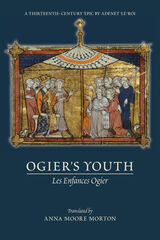 Ogier's Youth (Les Enfances Ogier): A Thirteenth-Century Epic by Adenet le Roi
Anna Moore Morton
Arizona Center for Medieval and Renaissance Studies, 2020 Ogier’s Youth is the first English prose translation of Les Enfances Ogier, an epic poem written in Old French in the late thirteenth century by Adenet le Roi, who lived in Brabant and Flanders. It concerns the exploits of a young knight, Ogier, who rose from his status as Charlemagne’s captive to become the hero of Charlemagne’s army in the latter’s campaign to recover Rome from a pagan army and restore the Pope to his holy seat. Ogier came to symbolize the hero who saves the city, the land from monstrous enemies. His legend as conquering hero persisted for centuries; versions of his story were written in many forms and many European languages. Reminders of Ogier’s fame are found from Belgium to Italy even today in such events as processions and puppet shows. Adenet’s version of the Ogier story is considered the most important and influential in the development of the enduring Ogier legend. Throughout Adenet’s story, we witness the development of a strong friendship between Ogier and Carahuel, a noble Saracen (Muslim) knight of the opposing army. The two warriors save one another’s lives when treachery threatens. We get a full and constant picture of Carahuel as a human being of complete integrity, honor and loyalty—qualities which also characterize Ogier. In addition, Carahuel’s faithful fiancée Gloriande, a strong, influential woman whose efforts are also crucial to the safety of both Ogier and Carahuel, plays an important part.
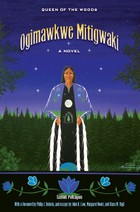 Ogimawkwe Mitigwaki (Queen of the Woods)
Simon Pokagon
Michigan State University Press, 2010 Simon Pokagon, the son of tribal patriarch Leopold Pokagon, was a talented writer, advocate for the Pokagon Potawatomi community, and tireless self-promoter.
In 1899, shorty after his death, Pokagon's novel Ogimawkwe Mitigwaki (Queen of the Woods)—only the second ever published by an American Indian—appeared. It was intended to be a testimonial to the traditions, stability, and continuity of the Potawatomi in a rapidly changing world. Read today, Queen of the Woods is evidence of the author's desire to mark the cultural, political, and social landscapes with a memorial to the past and a monument to a future that included the Pokagon Potawatomi as distinct and honored people.
This new edition offers a reprint of the original 1899 novel with the author's introduction to the language and culture of his people. In addition, new accompanying materials add context through a cultural biography, literary historical analysis, and linguistic considerations of the unusual text.
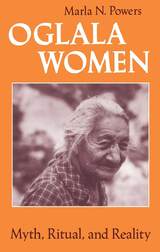 Oglala Women: Myth, Ritual, and Reality
Marla N. Powers
University of Chicago Press, 1986 Based on interviews and life histories collected over more than twenty-five years of study on the Pine Ridge reservation in South Dakota, Marla N. Powers conveys what it means to be an Oglala woman. Despite the myth of the Euramerican that sees Oglala women as inferior to men, and the Lakota myth that seems them as superior, in reality, Powers argues, the roles of male and female emerge as complementary. In fact, she claims, Oglala women have been better able to adapt to the dominant white culture and provide much of the stability and continuity of modern tribal life. This rich ethnographic portrait considers the complete context of Oglala life—religion, economics, medicine, politics, old age—and is enhanced by numerous modern and historical photographs.
"It is a happy event when a fine scholarly work is rendered accessible to the general reader, especially so when none of the complexity of the subject matter is sacrificed. Oglala Women is a long overdue revisionary ethnography of Native American culture."—Penny Skillman, San Francisco Chronicle Review
"Marla N. Powers's fine study introduced me to Oglala women 'portrayed from the perspectives of Indians,' to women who did not pity themselves and want no pity from others. . . . A brave, thorough, and stimulating book."—Melody Graulich, Women's Review of Books
"Powers's new book is an intricate weaving . . . and her synthesis brings all of these pieces into a well-integrated and insightful whole, one which sheds new light on the importance of women and how they have adapted to the circumstances of the last century."—Elizabeth S. Grobsmith, Nebraska History
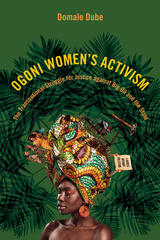 Ogoni Women's Activism: The Transnational Struggle for Justice against Big Oil and the State
Domale Dube
University of Illinois Press, 2025 In 1995, Nigeria’s dictatorial government executed nine Ogoni leaders fighting for civil rights and against Shell Oil’s depredations of Ogoni land. Domale Dube draws on interviews and participant observation to tell the long-ignored story of how women carved out a role in the Ogoni pursuit of justice. Dube’s account examines and documents the issues that drew women into the movement, from concerns for themselves and their communities to grander visions for the Ogoni. As she shows, these issues not only influenced organizing in Nigeria but also the diaspora in general and the United States in particular. Ogoni women relied upon nonviolent protest to realize their aims. Dube looks at their campaigns and how their actions reflected their concerns, values, interests, and priorities. The result is a rare account of Black women and transnational organizing for women’s, climate, and environmental justice that merges a history of their involvement with an in-depth analysis of the racial, gender, and ethnic dimensions of the Ogoni Struggle.
oh orchid o’clock
Endi Bogue Hartigan
Omnidawn, 2023 Poems that break down, expose, and reconsider our notions of time.
This collection speaks the language of the clock as a living instrument, exposing the sensory impacts of our obsession with time. In oh orchid o’clock, lyrics wind through histories like a nervous system through a body. The poems speak to how we let our days become over-clocked, over-transactional, and over-weaponed. With an instrumental sensibility, Endi Bogue Hartigan investigates what it is to be close to time—collective time, with its alarms and brutalities, and bodily time, intricate and familial. She considers how can we be both captured and complicit within systems of measurement, and she invites us to imagine how to break from, create, or become immune to them. Her poems use language to expose the face of the clock to reveal how gears press against interconnecting systems—economic, capitalist, astronomical, medical, governmental, and fantastical.
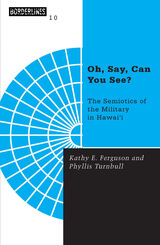 Oh, Say, Can You See: The Semiotics of the Military in Hawai’i
Kathy E. Ferguson
University of Minnesota Press, 1998 Considers what the military presence in Hawai’i tells us about colonialism, gender, race, and class. Everywhere you look in Hawai’i, you might see the military. And yet, in daily life few residents see the military at all-it is hidden in plain sight. This paradox of invisibility and visibility, of the available and the hidden, is the subject of Oh, Say, Can You See?, which maps the power relations involving gender, race, and class that define Hawai’i in relation to the national security state. Western intruders into Hawai’i-from the early explorers, missionaries, and sugar planters to the military, tourists, and foreign investors-have seen the island nation as a feminine place, waiting to embrace those who come to penetrate, protect, mold, and develop, yet conveniently lacking whatever the newcomers claim to possess. Thus feminized, this book contends, the islands and the people have been reinscribed with meanings according to the needs, fears, and desires of outsiders. Authors Kathy E. Ferguson and Phyllis Turnbull locate and “excavate” sites of memory, such as cemeteries, memorials, monuments, and museums, to show how the military constructs its gendered narrative upon prior colonial discourses. Among the sites considered are Fort DeRussy, Pearl Harbor, and Punchbowl Cemetery, as well as the practices of citizenship that are produced or foreclosed by the narratives of order and security written upon Hawai’i by the military.This semiotic investigation of ways the military marks Hawai’i necessarily explores the intersection of immigration, colonialism, military expansion, and tourism on the islands. Attending to the ways in which the military represents itself and others represent the military, the authors locate the particular representational elements that both conceal and reveal the military’s presence and power; in doing so, they seek to expand discursive space so that other voices can be heard. ISBN 0-8166-2978-1 Cloth $49.95xxISBN 0-81662979-X Paper $19.95x240 pages 5 7/8 x 9 DecemberBorderlines Series, Volume 10Translation inquiries: University of Minnesota Press
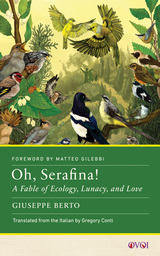 Oh, Serafina!: A Fable of Ecology, Lunacy, and Love
Giuseppe Berto
Rutgers University Press, 2023 Heir to the FIBA button factory in Lombardy, Augustus is profiting from Italy’s postwar industrial boom. Yet the dreamy young man is far from your stereotypical industrialist. He is less interested in making money than in talking to the birds in the surrounding garden and in making love to a beautiful factory worker named Palmira. But when the money-hungry Palmira schemes to have him institutionalized, Augustus finds a new love among his fellow mental patients: flute-playing flower child Serafina. Can Augustus and Serafina find a way to break free and express their love of each other and of nature in this crazy world?
Newly translated into English, Giuseppe Berto’s charming 1973 novel Oh, Serafina! was one of the first works of Italian literature to deal with ecological themes while also questioning the destructive effects of industrial capitalism, the many forms spirituality might take, and the ways our society defines madness. This translation includes a foreword from literary scholar Matteo Gilebbi that provides biographical, historical, and philosophical context for appreciating this whimsical fable of ecology, lunacy, and love.
Oh, Touch Me There: Love Sonnets
Roger Armbrust
Parkhurst Brothers, Inc., 2013
Witty, humorous and wise reflections on loving There is a mythic quality to the poetry of Roger Armbrust. Whether his subject is surgery or angels, his language and vision—while expressed in an earthly lexicon—are focused on the life of the spirit. We constantly heal each other, love, true
to our senses, sharing our secret vaults
of fear and longing, faith and confusion,
doubt and delight. Armbrust’s love poems are not ethereal, however, but rooted in real bodies… My poetry honors your architecture’s mystery. Fanciful, yet rooted in real experience, Armbrust’s one hundred-plus sonnets incite passion and introspection, so that the collection makes an inspired lover’s gift.
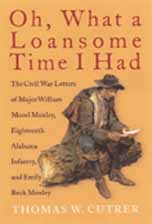 Oh, What a Loansome Time I Had: The Civil War Letters of Major William Morel Moxley, Eighteenth Alabama Infantry, and Emily Beck Moxley
Emily Beck Moxley
University of Alabama Press, 2002 This rare correspondence between a soldier and his wife relates in poignant detail the struggle for survival on the battlefield as well as on the home front and gives voice to the underrepresented class of small farmers
Most surviving correspondence of the Civil War period was written by members of a literate, elite class; few collections exist in which the woman's letters to her soldier husband have been preserved. Here, in the exchange between William and Emily Moxley, a working-class farm couple from Coffee County, Alabama, we see vividly an often-neglected aspect of the Civil War experience: the hardships of civilian life on the home front. Emily's moving letters to her husband, startling in their immediacy and detail, chronicle such difficulties as a desperate lack of food and clothing for her family, the frustration of depending on others in the community, and her growing terror at facing childbirth without her husband, at the mercy of a doctor with questionable skills. Major Moxley's letters to his wife reveal a decidedly unromantic side of the war, describing his frequent encounters with starvation, disease, and bloody slaughter. To supplement this revealing correspondence, the editor has provided ample documentation and research; a genealogical chart of the Moxley family; detailed maps of Alabama and Florida that allow the reader to trace the progress of Major Moxley's division; and thorough footnotes to document and elucidate events and people mentioned in the letters. Readers interested in the Civil War and Alabama history will find these letters immensely appealing while scholars of 19th-century domestic life will find much of value in Emily Moxley's rare descriptions of her homefront experiences.
Oh You Robot Saints!
Rebecca Morgan Frank
Carnegie Mellon University Press, 2021 Part bestiary, part litany, part elegy, Rebecca Morgan Frank’s Oh You Robot Saints! is populated by a strange menagerie of early automata and robots, including octobots and an eighteenth-century digesting duck, set alongside medieval mechanical virgins and robot priests. From a riveting robobee sonnet sequence that links weapons of war and industrial fixes for infertility to a microdrama sketching out a missing Sophocles play on the mythical bronze man, Talos, these muscular poems blur and sing the lines between machines and the divine. This lyrical exploration of the ongoing human desire to create life navigates wonder and grief, joining the uncanny investigation of what it is to be, to make, and to be made.
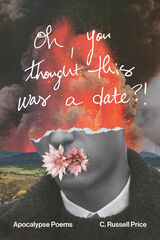 oh, you thought this was a date?!: Apocalypse Poems
C. Russell Price
Northwestern University Press, 2022 Appalachian genderqueer punk writer C. Russell Price’s first full-length poetry collection is a somatic grimoire exploring desire, gender, and sexuality in multiverse littered with flowers and product placement. Part pop culture bubblegum lip smack, part battle cry, this collection asks, What is radical vengeance, and does true survivorship from sexual trauma exist only in fantasy, or is it an attainable reality?
Price’s cinematic approach to language and scene is on full display, as well as their dark humor and resilience. Within these pages, the surreal is familiar and grief is a national pastime. If the end is near, who among us would not put on Fleetwood Mac? Who would not clean up their eyeliner just a smidge? This collection pulses with the beat that follows destruction (whether human or natural), the moment the jaw unhinges. These poems are not for pearl clutchers. They are for those who have already felt their private apocalypse.
O'Hearn
Greg Mulcahy
University of Alabama Press, 2015 Greg Mulcahy’s new novel opens on a man suffering an accident at his workplace. His colleagues there are known, at least initially, only as O’Hearn and Minouche. In the aftermath of the incident, this trinity begins to fall apart. His career falls apart. His life falls apart. O’Hearn is the story of the story the man tells himself in confused chronology as he struggles to make sense of a world and a landscape where things have stopped making sense. The laws of causation are absent or profoundly obscured in this explanatory narrative, but then so is all individual motivation. Action seems to end only in a world of winners and losers and occurs solely to reinforce that world by further enriching the winners at the, sometimes willful, expense of the losers. O’Hearn is funny, contradictory, satiric, heartbreaking—a work unlike anything in our contemporary literature.
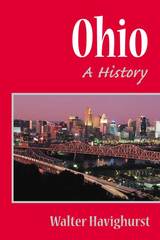 Ohio: A HISTORY
Walter Havighurst
University of Illinois Press, 1976 Ringing hammers, swinging cranes, the hot breath of furnaces and the gush of molten metal, a skyline ringed with belching smokestacks--the energy of industry, both in manufacturing and in old-fashioned human diligence, has fueled Ohio since its earliest history as the first state in the Northwest Territory.
From Harvey Firestone's rubber rims for buggy wheels to John Leon Bennet's wire flyswatter, from O. C. Barber's first book matches to Dr. Edwin Beeman's flavored chewing gum, Ohio has buzzed with inventive drive and creativity. The Wright brothers flew a winged crate over a Dayton cow pasture; Stephen Foster allegedly wrote "Oh Susanna" while working as a bookkeeper in a Cincinnati riverfront shipping office; and Ohio native Victoria Claflin Woodhull declared herself the first woman presidential candidate. The state also produced some of the Civil War's greatest leaders, including Ulysses S. Grant and William T. Sherman.
Havighurst gives a moving portrayal of Welsh inventor Samuel Milton Jones, who made his fortune with a device used in oil production and then turned his energies to creating his own "new deal" for his factory workers and, as mayor of Toledo, for his constituency. At the other end of the scale, shrewd, autocratic George B. Cox ruled Cincinnati through a sticky web of back-room corruption.
Focusing on the people who stamped the state with their vision, Havighurst captures the vibrancy and ingenuity of Ohio's inventors, manufacturers, leaders and dreamers, as well as the consequences, for the land and its inhabitants, of unchecked industrial excesses.
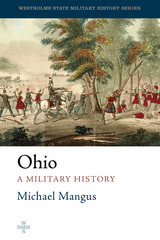 Ohio: A Military History
Michael Mangus
Westholme Publishing, 2016 In this volume, historian Michael Mangus traces Ohio’s military history from what archaeology reveals about the earliest prehistoric people through Ohio’s role in the War on Terror. Ohio: A Military History is the most comprehensive account to date of conflict within the state as well as the state’s contributions to the nation’s military history. With its extraordinary natural resources and key waterways, the region that the state of Ohio now includes was a partial reason for three wars involving European powers: the French and Indian War, the American Revolution, and the War of 1812. It was also site to numerous conflicts between Euro- Americans and American Indians in the late eighteenth and early nineteenth centuries. Various American military personalities have ties to the state, including George Rogers Clark, Tecumseh, Ulysses Grant, George Custer, Edward Rickenbacker, and Paul Tibbets, Jr. Ohio’s civilians routinely supported their soldiers in these military conflicts by endorsing bounties to spur recruits, providing funds to families of active-duty soldiers, forming Soldiers’ Aid Societies, and serving as nurses on the battlefield. Yet not all of Ohio’s people actively supported war, with some of the state’s civilians playing prominent roles in protest efforts, including the most infamous anti-war protest in United States history, the shootings at Kent State University.
Complete with a list of historical sites and a comprehensive bibliography, Ohio: A Military History is an important reference for those interested in the role of the Buckeye State in our nation’s history.
Westholme State Military History Series
Each state in the United States of America has a unique military history. The volumes in this series seek to provide a portrait of the richness of each state’s military experience, primarily defined by its borders, as well as the important contributions the state has made to the nation’s military history. Written by historians for the general reader, the volumes trace the history of conflict from the original native populations to today. The volumes are well illustrated and include specially commissioned maps, extensive bibliographies, lists of national and state historical sites, and a detailed index.
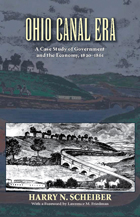 Ohio Canal Era: A Case Study of Government and the Economy, 1820–1861
Harry N. Scheiber
Ohio University Press, 2012 Ohio Canal Era, a rich analysis of state policies and their impact in directing economic change, is a classic on the subject of the pre–Civil War transportation revolution. This edition contains a new foreword by scholar Lawrence M. Friedman, Professor of Law, Stanford Law School, and a bibliographic note by the author. Professor Scheiber explores how Ohio—as a “public enterprise state,” creating state agencies and mobilizing public resources for transport innovation and control—led in the process of economic change before the Civil War. No other historical account of the period provides so full and insightful a portrayal of “law in action.” Scheiber reveals the important roles of American nineteenth-century government in economic policy-making, finance, administration, and entrepreneurial activities in support of economic development. His study is equally important as an economic history. Scheiber provides a full account of waves of technological innovation and of the transformation of Ohio’s commerce, agriculture, and industrialization in an era of hectic economic change. And he tells the intriguing story of how the earliest railroads of the Old Northwest were built and financed, finally confronting the state-owned canal system with a devastating competitive challenge. Amid the current debate surrounding “privatization,” “deregulation,” and the appropriate use of “industrial policy” by government to shape and channel the economy. Scheiber’s landmark study gives vital historical context to issues of privatization and deregulation that we confront in new forms today.
The Ohio Company: Its Inner History
Alfred Proctor James
University of Pittsburgh Press, 1959 Alfred P. James presents a comprehensive reconstruction of the history and activities of the Ohio Company of Virginia, which was formed by esquire Thomas Lee and eleven others. In 1747, the group petitioned the governor and Council of Virginia for 200,000 acres of land west of the Allegheny Mountains. There they would build a fort and storehouses for the future settlement of the area by families. James also examines the effects of the French and Indian War on the settlements, and the vain attempts of the company to reorganize after the war. As his study reveals, despite these events, the Ohio Company was instrumental in developing the land that would later become western Pennsylvania. The book also reproduces some 1,200 pieces of company correspondence, including land and commercial transactions.
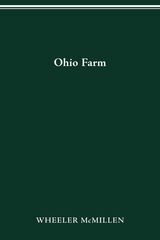 OHIO FARM
Wheeler McMillen
Ohio State University Press, 1997 Originally published in 1974, this memoir fondly and vividly recalls life on the McMillen family farm in western Ohio, describing in rich detail the daily and seasonal activities that marked the cyclical progression of farm life. Uncomplicated when compared with the task of managing today's highly mechanized agricultural complexes, life on the early twentieth-century small farm entailed hard work and afforded simple pleasures that brought satisfaction and enjoyment to the farm and family. Farming on that scale and in the same manner has now become almost completely infeasible, yet in those times a good farmer could prosper and become independent. Wheeler McMillen’s father, Lewis, did both. Relying frequently on his father’s account books and concise diaries, for this is primarily his father’s story, McMillen recounts the immense labor that farming demanded before the advent of the tractor and the combine harvester. He evokes the special excitements of having company for Sunday dinner, attending the annual oyster supper at the Grange Hall, and gathering on the Fourth of July with the interminable wait for darkness to fall. McMillen also portrays the quiet peace and ineffable joy of private moments, such as resting the horses during spring plowing to watch bronzed grackles search for food in the freshly turned furrows. Wheeler McMillen’s slice of history will speak to those interested in what rural life was once like in the Midwest and to Ohioans who would like to learn more about their state’s recent past.
 Ohio On The Move: Transportation in the Buckeye State
H. Roger Grant
Ohio University Press, 1999 Few American states can match the rich and diverse transportation heritage of Ohio. Every major form of public conveyance eventually served the Buckeye state. From the “Canal Age” to the “Interurban Era,” Ohio emerged as a national leader. The state’s central location, abundant natural resources, impressive wealth, shrewd business leadership, and episodes of good fortune explain the dynamic nature of its transport past. Ohio on the Move is the first systematic scholarly account of the transportation history of Ohio. To date, little has appeared on several subjects discussed here, including intercity bus and truck operations and commercial aviation. The more familiar topics of river and lake transport, canals, steam railroads, electric interurbans, and mass transit are extensively explored in the Ohio context. In this inaugural volume of Ohio University Press’s Ohio Bicentennial Series, Professor Grant demonstrates the truth of the slogan that Ohio is “the heart of it all” - not solely by location but also in the impressive network of transportation arteries that have linked the state, whether natural waterways and air space or various artificial land-travel routes.
 Ohio State Athletics, 1879–1959
James E. Pollard
Ohio State University Press Ohio State Athletics, 1879–1959 represents the first archival project devoted to describing the history of The Ohio State University’s athletic program, including the growth of athletics at OSU and the achievements of some of the many athletes who played for Ohio State in those early years. The work was undertaken by James E. Pollard, who, in 1959, continued the work of The Ohio State University Development Fund, the Alumni Varsity “O” Association, and early Athletic Director L. W. St. John to author OSU’s first athletic history. Unsurprisingly, football is emphasized in the book because, even then as now, it drew the greatest public interest and provided a majority of the athletic department’s budget.
Besides turning to the archives of the Lantern and the Makio to research the book, Pollard also relied on conversations with past Board of Trustees Secretary Carl E. Steeb, Professor Charles W. Foulk who actually competed for Ohio State as a student on the university’s first basketball team, and then current Athletic Director, Richard C. Larkins. Because many of the university’s earliest records were lost or destroyed, a significant amount of information also came from Columbus newspapers, Alumni Monthly, and official records of the faculty, trustees, and presidents.
The Ohio State University: An Illustrated History
Raimund E. Goerler
Ohio State University Press, 2011 Raimund E. Goerler, acclaimed archivist and historian, has written the definitive guidebook to the history of The Ohio State University, one of the world's largest universities and a prominent land-grant institution. Using a topical strategy—ranging widely through critical events in OSU's history, vignettes of prominent alumni, and stories of well known campus buildings, historic sites, presidents, student life, traditions, and athletics—The Ohio State University: An Illustrated History is the first one-volume history of the University to appear in more than fifty years. Always entertaining and consistently informative, the book is lavishly illustrated with more than 300 rare photographs from the OSU Archives. The Ohio State University: An Illustrated History is a must-have for all who call themselves Buckeyes.
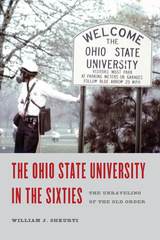 The Ohio State University in the Sixties: The Unraveling of the Old Order
William J. Shkurti
Ohio State University Press, 2016 At 5:30 p.m. on May 6, 1970, an embattled Ohio State University President Novice G. Fawcett took the unprecedented step of closing down the university. Despite the presence of more than 1,500 armed highway patrol officers, Ohio National Guardsmen, deputy sheriffs, and Columbus city police, university and state officials feared they could not maintain order in the face of growing student protests. Students, faculty, and staff were ordered to leave; administrative offices, classrooms, and laboratories were closed. The campus was sealed off. Never in the first one hundred years of the university’s existence had such a drastic step been necessary.
Just a year earlier the campus seemed immune to such disruptions. President Nixon considered it safe enough to plan an address at commencement. Yet a year later the campus erupted into a spasm of violent protest exceeding even that of traditional hot spots like Berkeley and Wisconsin. How could conditions have changed so dramatically in just a few short months?
Using contemporary news stories, long overlooked archival materials, and first-person interviews, The Ohio State University in the Sixties explores how these tensions built up over years, why they converged when they did and how they forever changed the university.
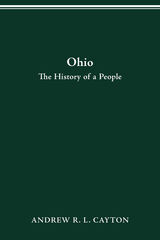 OHIO: THE HISTORY OF A PEOPLE
Andrew R. L. Cayton
Ohio State University Press, 2002 As the state of Ohio prepares to celebrate its bicentennial in 2003, Andrew R. L. Cayton offers an account of ways in which diverse citizens have woven its history. Ohio: The History of a People, centers around the many stories Ohioans have told about life in their state. The founders of Ohio in 1803 believed that its success would depend on the development of a public culture that emphasized what its citizens had in common with each other. But for two centuries the remarkably diverse inhabitants of Ohio have repeatedly asserted their own ideas about how they and their children should lead their lives. The state’s public culture has consisted of many voices, sometimes in conflict with each other. Using memoirs, diaries, letters, novels, and paintings, Cayton writes Ohio’s history as a collective biography of its citizens. Ohio, he argues, lies at the intersection of the stories of James Rhodes and Toni Morrison, Charles Ruthenberg and Lucy Webb Hayes, Carl Stokes and Alice Cary, Sherwood Anderson and Pete Rose. It lies in the tales of German Jews in Cincinnati, Italian and Polish immigrants in Cleveland, Southern blacks and white Appalachians in Youngstown. Ohio is the mingled voices of farm families, steelworkers, ministers, writers, schoolteachers, reformers, and football coaches. Ohio, in short, is whatever its citizens have imagined it to be.
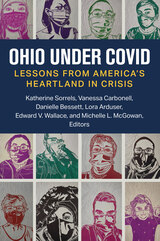 Ohio under COVID: Lessons from America's Heartland in Crisis
Katherine Sorrels, Vanessa Carbonell, Danielle Bessett, Lora Arduser, Edward Wallace, and Michelle L. McGowan, Editors
University of Michigan Press, 2023 In early March of 2020, Americans watched with uncertain terror as the novel coronavirus pandemic unfolded. One week later, Ohio announced its first confirmed cases. Just one year later, the state had over a million cases and 18,000 Ohioans had died. What happened in that first pandemic year is not only a story of a public health disaster, but also a story of social disparities and moral dilemmas, of lives and livelihoods turned upside down, and of institutions and safety nets stretched to their limits.
Ohio under COVID tells the human story of COVID in Ohio, America’s bellwether state. Scholars and practitioners examine the pandemic response from multiple angles, and contributors from numerous walks of life offer moving first-person reflections. Two themes emerge again and again: how the pandemic revealed a deep tension between individual autonomy and the collective good, and how it exacerbated social inequalities in a state divided along social, economic, and political lines. Chapters address topics such as mask mandates, ableism, prisons, food insecurity, access to reproductive health care, and the need for more Black doctors. The book concludes with an interview with Dr. Amy Acton, the state’s top public health official at the time COVID hit Ohio. Ohio under COVID captures the devastating impact of the pandemic, both in the public discord it has unearthed and in the unfair burdens it has placed on the groups least equipped to bear them.
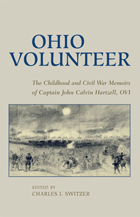 Ohio Volunteer: The Childhood and Civil War Memoirs of Captain John Calvin Hartzell, OVI
Charles I. Switzer
Ohio University Press, 2005 When his captain was killed during the Battle of Perryville, John Calvin Hartzell was made commander of Company H, 105th Ohio Volunteer Infantry. He led his men during the Battle of Chickamauga, the siege of Chattanooga, and the Battle of Missionary Ridge. Edited and introduced by Charles Switzer, Ohio Volunteer: The Childhood and Civil War Memoirs of Captain John Calvin Hartzell, OVI documents military strategy, the life of the common soldier, the intense excitement and terror of battle, and the wretchedness of the wounded. Hartzell’s family implored him to set down his life story, including his experiences in the Civil War from 1862 to 1866. Hartzell did so diligently, taking more than two years to complete his manuscript. The memoir reveals a remarkable memory for vivid details, the ability to see larger and more philosophical perspectives, and a humorous outlook that helped him bear the unbearable. He also depicted the changing rural economy, the assimilation of the Pennsylvania Dutch, and the transformations wrought by coal mining and the iron industry. Hartzell felt individualism was threatened by the Industrial Revolution and the cruelties of the war. He found his faith in humanity affirmed—and the dramatic tension in his memoir resolved—when 136,000 Union soldiers reenlisted and assured victory for the North. The common soldier, he wrote, was “loyal to the core.”
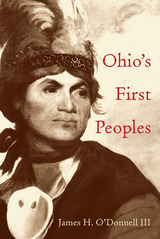 Ohio’s First Peoples
James H. O'Donnell
Ohio University Press, 2004 Although founders of the state like Rufus Putnam pointed to the remaining prehistoric earthworks at Marietta as evidence that the architects were a people of “ingenuity, industry, and elegance,” their words did not prevent a rivalry with the area’s Indian inhabitants that was settled only through decades of warfare and treaty-making. Native American armies managed to win battles with Josiah Harmar and Arthur St. Clair, but not the war with Anthony Wayne. By the early nineteenth century only a few native peoples remained, still hoping to retain their homes. Pressures from federal and state governments as well as the settlers‘ desire for land, however, left the earlier inhabitants no refuge. By the mid-1840s they were gone, leaving behind relatively few markers on the land. Ohio’s First Peoples depicts the Native Americans of the Buckeye State from the time of the well-known Hopewell peoples to the forced removal of the Wyandots in the 1840s. Professor James O’Donnell presents the stories of the early Ohioans based on the archaeological record. In an accessible narrative style, he provides a detailed overview of the movements of Fort Ancient peoples driven out by economic and political forces in the seventeenth century. Ohio’s plentiful game and fertile farmlands soon lured tribes such as the Wyandots, Shawnees, and Delawares, which are familiar to observers of the historic period. In celebrating the bicentennial of Ohio, we need to remember its earliest residents. Ohio’s First Peoples recounts their story and documents their contribution to Ohio’s full heritage.
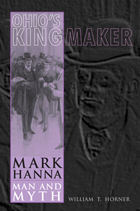 Ohio’s Kingmaker: Mark Hanna, Man and Myth
William T. Horner
Ohio University Press, 2010 For a decade straddling the turn of the twentieth century, Mark Hanna was one of the most famous men in America. Portrayed as the puppet master controlling the weak-willed William McKinley, Hanna was loved by most Republicans and reviled by Democrats, in large part because of the way he was portrayed by the media of the day. Newspapers and other media outlets that supported McKinley reported positively about Hanna, but those sympathetic to William Jennings Bryan, the Democrats’ presidential nominee in 1896 and 1900, attacked Hanna far more aggressively than they attacked McKinley himself. Their portrayal of Hanna was wrong, but powerful, and this negative image of him survives to this day. In this study of Mark Hanna’s career in presidential politics, William T. Horner demonstrates the flaws inherent in the ways the news media cover politics. He deconstructs the myths that surround Hanna and demonstrates the dangerous and long-lasting effect that inaccurate reporting can have on our understanding of politics. When Karl Rove emerged as the political adviser to George W. Bush’s presidential campaigns, the reporters quickly began to compare Rove to Hanna even a century after Hanna’s death. The two men played vastly different roles for the presidents they served, but modern reporters consistently described Rove as the second coming of Mark Hanna, another political Svengali. Ohio’s Kingmaker is the story of a fascinating character in American politics and serves to remind us of the power of (mis)perceptions.
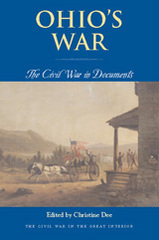 Ohio’s War: The Civil War in Documents
Christine Dee
Ohio University Press, 2006 In 1860, Ohio was among the most influential states in the nation. As the third-most-populous state and the largest in the middle west, it embraced those elements that were in concert-but also at odds-in American society during the Civil War era. Ohio’s War uses documents from that vibrant and tumultuous time to reveal how Ohio’s soldiers and civilians experienced the Civil War. It examines Ohio’s role in the sectional crises of the 1850s, its contribution to the Union war effort, and the war’s impact on the state itself. In doing so, it provides insights into the war’s meaning for northern society. Ohio’s War introduces some of those soldiers who left their farms, shops, and forges to fight for the Union. It documents the stories of Ohio’s women, who sustained households, organized relief efforts, and supported political candidates. It conveys the struggles and successes of free blacks and former slaves who claimed freedom in Ohio and the distinct wartime experiences of its immigrants. It also includes the voices of Ohioans who differed over emancipation, freedom of speech, the writ of habeas corpus, the draft, and the war’s legacy for American society. From Ohio’s large cities to its farms and hamlets, as the documents in this volume show, the war changed minds and altered lives but left some beliefs and values untouched. Ohio’s War is a documentary history not only of the people of one state, but also of a region and a nation during the pivotal epoch of American history.
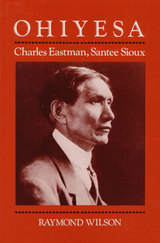 Ohiyesa: Charles Eastman, Santee Sioux
Raymond Wilson
University of Illinois Press, 1983 The far-ranging life and work of the popular Native American author
Charles Eastman, called Ohiyesa in Santee, came of age amidst increasing tensions and violence between Native and European colonizers. Though raised to be a hunter-warrior, Eastman was persuaded by his Christian father to enter white society. Eastman graduated from Dartmouth and the Boston University School of Medicine. His career included service as the government physician at the Pine Ridge Agency, where he tended casualties at Wounded Knee; as an Inspector for the Bureau of Indian Affairs; as Indian secretary for the YMCA; and as one of the cofounders of the Boy Scouts of America.
Raymond Wilson examines these accomplishments while also delving into the writings that expressed Eastman’s determination to hold onto his Santee roots. Popular works like Indian Boyhood, The Soul of the Indian, and Indian Heroes and Chieftains reconfirmed his heritage and aimed at making white society aware of Indigenous peoples’ contribution to American civilization.
Oikography
Ali Shobeiri
Leiden University Press, 2025 'Oikography' aims to show how photography envisages, embodies and apperceives home as a spatial idea, regardless of whether that space is idealized or ideologized, ontologized or theorized, materialized or dematerialized, territorialized or deterritorialized, or internalized within us or externalized around us.
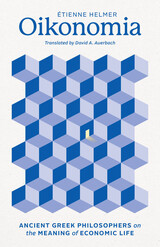 Oikonomia: Ancient Greek Philosophers on the Meaning of Economic Life
Étienne Helmer
University of Chicago Press, 2024 A detailed analysis of oikonomia, an underexplored branch of knowledge in ancient Greek philosophy.
In this book, Étienne Helmer offers a comprehensive analysis of oikonomia in ancient Greek philosophy. Despite its similarity to the word “economy,” for the ancients, oikonomia named a branch of knowledge—the science of management—that was aimed at studying the practices we engage in to satisfy our needs. This began with the domestic sphere, but it radiated outward from the oikos (house) to encompass broader issues in the polis (city) as well. Helmer explores topics such as gender roles and marriage, property and the household, the acquisition and preservation of material goods, and how Greek philosophers addressed the issue of slavery in the ancient world. Even if we are not likely to share many of ancient thinkers’ beliefs today, Helmer shows that there was once a way of thinking of “economic life” that went beyond the mere accumulation of wealth, representing a key point of departure for understanding how to inhabit the world with others.
Oil and Mexican Foreign Policy
George Grayson
University of Pittsburgh Press, 1988 The discovery of enormous oil reserves in the early 1970s revolutionized Mexico's economy and political behavior, bringing soaring revenues and industrial development. The oil glut of 1981 and wild fluctuations in world prices, pushed the country to the brink of bankruptcy. George W. Grayson describes how the roller-coaster economic ride, shrill nationalism, political assertiveness, and arrogant posturing of the 1970s have given way to greater professionalism, fiscal responsibility, and a cooperative attitude towards the United States in recent times.
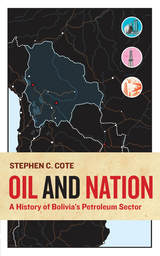 Oil and Nation: A History of Bolivia's Petroleum Sector
Stephen C. Cote
West Virginia University Press, 2016 Oil and Nation places petroleum at the center of Bolivia’s contentious twentieth-century history. Bolivia’s oil, Cote argues, instigated the largest war in Latin America in the 1900s, provoked the first nationalization of a major foreign company by a Latin American state, and shaped both the course and the consequences of Bolivia’s transformative National Revolution of 1952. Oil and natural gas continue to steer the country under the government of Evo Morales, who renationalized hydrocarbons in 2006 and has used revenues from the sector to reduce poverty and increase infrastructure development in South America’s poorest country.
The book advances chronologically from Bolivia’s earliest petroleum pioneers in the nineteenth century until the present, inserting oil into historical debates about Bolivian ethnic, racial, and environmental issues, and within development strategies by different administrations. While Bolivia is best known for its tin mining, Oil and Nation makes the case that nationalist reformers viewed hydrocarbons and the state oil company as a way to modernize the country away from the tin monoculture and its powerful backers and toward an oil-powered future.
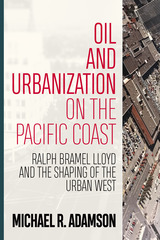 Oil and Urbanization on the Pacific Coast: Ralph Bramel Lloyd and the Shaping of the Urban West
Michael R. Adamson
West Virginia University Press, 2018 Oil and Urbanization on the Pacific Coast tells the story of oilman Ralph Bramel Lloyd, a small business owner who drove the development of one of America’s largest oil fields. Lloyd invested his petroleum earnings in commercial real estate—much of it centered around automobiles and the fuel they require—in several western cities, notably Portland, Oregon. Putting the history of extractive industry in dialogue with the history of urban development, Michael R. Adamson shows how energy is woven into the fabric of modern life, and how the “energy capital” of Los Angeles exerted far-flung influence in the US West. A contribution to the relatively understudied history of small businesses in the United States, Oil and Urbanization on the Pacific Coast explores issues of interest to multiple audiences, such as the competition for influence over urban development waged among local growth machines and outside corporate interests; the urban rivalries of a region; the importance of public capital in mobilizing the commercial real estate sector during the Great Depression and World War II; and the relationships among owners, architects, and contractors in the execution of commercial building projects.
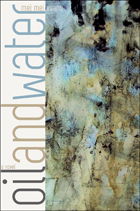 Oil and Water: A Novel
Mei Mei Evans
University of Alaska Press, 2013 What happens when the American dream collides head-on with a nation’s dependence on fossil fuels? Oil and Water, a novel by Mei Mei Evans, focuses on precisely this question. Starting with a star-crossed supertanker, a wayward fishing boat, and a well-known hazard in the Gulf of Alaska, the story presents a region plunged into an oil-slicked crisis. As thousands of miles of shoreline and sea are obliterated, the spill threatens the lives and livelihoods of the coastal community of Selby. At the center of the disaster are Gregg, a down-on-his-luck skipper, and Lee, his lone deckhand. As they cross paths with the tanker and later the residents of Selby, they are faced with decisions that will have a lasting impact on the entire community. And when the residents are presented with a controversial deal—accept handouts in the form of work from the very company responsible for the disaster—they must learn just how important it is to find strength in the connections that bind humans to each other and the natural world.
Evans’s compelling story, influenced by her own experiences during the Exxon Valdez oil spill, is a provocative look at the choice that must be made between environmental safety and economic survival. A PEN/Bellwether Prize finalist, it will have readers reconsidering where they draw their own lines.
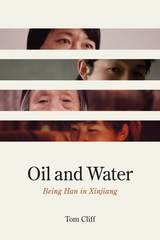 Oil and Water: Being Han in Xinjiang
Tom Cliff
University of Chicago Press, 2016 For decades, China’s Xinjiang region has been the site of clashes between long-residing Uyghur and Han settlers. Up until now, much scholarly attention has been paid to state actions and the Uyghur’s efforts to resist cultural and economic repression. This has left the other half of the puzzle—the motivations and ambitions of Han settlers themselves—sorely understudied.
With Oil and Water, anthropologist Tom Cliff offers the first ethnographic study of Han in Xinjiang, using in-depth vignettes, oral histories, and more than fifty original photographs to explore how and why they became the people they are now. By shifting focus to the lived experience of ordinary Han settlers, Oil and Water provides an entirely new perspective on Chinese nation building in the twenty-first century and demonstrates the vital role that Xinjiang Han play in national politics—not simply as Beijing’s pawns, but as individuals pursuing their own survival and dreams on the frontier.
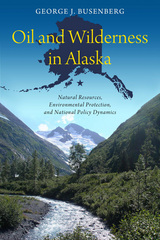 Oil and Wilderness in Alaska: Natural Resources, Environmental Protection, and National Policy Dynamics
George J. Busenberg
Georgetown University Press Colliding environmental and development interests have shaped national policy reforms supporting both oil development and environmental protection in Alaska. Oil and Wilderness in Alaska examines three significant national policy reform efforts that came out of these conflicts: the development of the Trans-Alaska pipeline, the establishment of a vast system of protected natural areas through the Alaska National Interest Lands Conservation Act, and the reform of the environmental management of the marine oil trade in Alaska to reduce the risk of oil pollution after the Exxon Valdez disaster. Illuminating the delicate balance and give-and-take between environmental and commercial interests, as well as larger issues shaping policy reforms, Busenberg applies a theoretical framework to examine the processes and consequences of these reforms at the state, national, and international levels. The author examines the enduring institutional legacies and policy consequences of each reform period, their consequences for environmental protection, and the national and international repercussions of reform efforts. The author concludes by describing the continuing policy conflicts concerning oil development and nature conservation in Alaska left unresolved by these reforms. Rich case descriptions illustrate the author’s points and make this book an essential resource for professors and students interested in policies concerning Alaska, the Arctic, oil development, nature conservation, marine oil spills, the policy process, and policy theory.
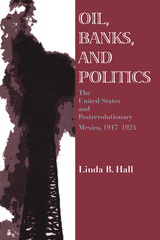 Oil, Banks, and Politics: The United States and Postrevolutionary Mexico, 1917–1924
By Linda B. Hall
University of Texas Press, 1995 Mexico was second only to the United States as the world's largest oil producer in the years following the Mexican Revolution. As the revolutionary government became institutionalized, it sought to assure its control of Mexico's oil resources through the Constitution of 1917, which returned subsoil rights to the nation. This comprehensive study explores the resulting struggle between oil producers, many of which were U.S. companies, and the Mexican government. Linda Hall goes beyond the diplomacy to look at the direct impact of a powerful, highly profitable foreign-controlled industry on a government and a nation trying to recover from a major civil war. She draws on extensive research in Mexican archives, including both government sources and the private papers of Presidents Alvaro Obregón and Plutarco Elías Calles, as well as U.S. government and private sources. Since the North American Free Trade Agreement has expanded United States business ties to Mexico, this study of a crucial moment in U.S.-Mexican business relations will be of interest to a wide audience in business, diplomatic, and political history.
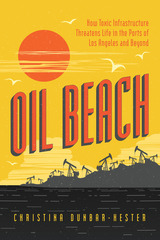 Oil Beach: How Toxic Infrastructure Threatens Life in the Ports of Los Angeles and Beyond
Christina Dunbar-Hester
University of Chicago Press, 2023 Can the stories of bananas, whales, sea birds, and otters teach us to reconsider the seaport as a place of ecological violence, tied to oil, capital, and trade?
San Pedro Bay, which contains the contiguous Ports of Los Angeles and Long Beach, is a significant site for petroleum shipping and refining as well as one of the largest container shipping ports in the world—some forty percent of containerized imports to the United States pass through this so-called America’s Port. It is also ecologically rich. Built atop a land- and waterscape of vital importance to wildlife, the heavily industrialized Los Angeles Harbor contains estuarial wetlands, the LA River mouth, and a marine ecology where colder and warmer Pacific Ocean waters meet. In this compelling interdisciplinary investigation, award-winning author Christina Dunbar-Hester explores the complex relationships among commerce, empire, environment, and the nonhuman life forms of San Pedro Bay over the last fifty years—a period coinciding with the era of modern environmental regulation in the United States. The LA port complex is not simply a local site, Dunbar-Hester argues, but a node in a network that enables the continued expansion of capitalism, propelling trade as it drives the extraction of natural resources, labor violations, pollution, and other harms. Focusing specifically on cetaceans, bananas, sea birds, and otters whose lives are intertwined with the vitality of the port complex itself, Oil Beach reveals how logistics infrastructure threatens ecologies as it circulates goods and capital—and helps us to consider a future where the accumulation of life and the accumulation of capital are not in violent tension.
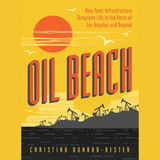 Oil Beach: How Toxic Infrastructure Threatens Life in the Ports of Los Angeles and Beyond
Christina Dunbar-Hester
University of Chicago Press, 2023 This is an auto-narrated audiobook edition of this book.
Can the stories of bananas, whales, sea birds, and otters teach us to reconsider the seaport as a place of ecological violence, tied to oil, capital, and trade?
San Pedro Bay, which contains the contiguous Ports of Los Angeles and Long Beach, is a significant site for petroleum shipping and refining as well as one of the largest container shipping ports in the world—some forty percent of containerized imports to the United States pass through this so-called America’s Port. It is also ecologically rich. Built atop a land- and waterscape of vital importance to wildlife, the heavily industrialized Los Angeles Harbor contains estuarial wetlands, the LA River mouth, and a marine ecology where colder and warmer Pacific Ocean waters meet. In this compelling interdisciplinary investigation, award-winning author Christina Dunbar-Hester explores the complex relationships among commerce, empire, environment, and the nonhuman life forms of San Pedro Bay over the last fifty years—a period coinciding with the era of modern environmental regulation in the United States. The LA port complex is not simply a local site, Dunbar-Hester argues, but a node in a network that enables the continued expansion of capitalism, propelling trade as it drives the extraction of natural resources, labor violations, pollution, and other harms. Focusing specifically on cetaceans, bananas, sea birds, and otters whose lives are intertwined with the vitality of the port complex itself, Oil Beach reveals how logistics infrastructure threatens ecologies as it circulates goods and capital—and helps us to consider a future where the accumulation of life and the accumulation of capital are not in violent tension.
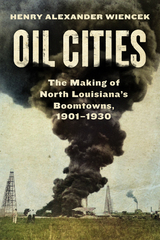 Oil Cities: The Making of North Louisiana’s Boomtowns, 1901-1930
Henry Alexander Wiencek
University of Texas Press, 2024 How international oil companies navigated the local, segregated landscape of north Louisiana in the first decades of the twentieth century. In 1904, prospectors discovered oil in the rural parishes of North Louisiana just outside Shreveport. As rural cotton fields gave way to dense, industrial centers of energy extraction, migrants from across the US—and the world—rushed to take a share of the boom. The resulting boomtowns, most notoriously Oil City, quickly gained a reputation for violence, drinking, and rough living. Meanwhile, North Louisiana’s large Black population endured virulent white supremacy in the oil fields and the courtrooms to earn a piece of the boom, including one Black woman who stood to become the wealthiest oil heiress in America. In Oil Cities, Henry Wiencek uncovers what life was like amidst the tent cities, saloons, and oil derricks of North Louisiana’s oil boomtowns, tracing the local experiences of migrants, farmers, sex workers, and politicians as they navigated dizzying changes to their communities. This first historical monograph on the region’s dramatic oil boom reveals a contested history, in which the oil industry had to adapt its labor, tools, and investments to meet North Louisiana’s unique economic, social, political, and environmental dynamics.
 Oil Empire: Visions of Prosperity in Austrian Galicia
Alison Fleig Frank
Harvard University Press, 2007 At the beginning of the twentieth century, the Austrian Empire ranked third among the world's oil-producing states (surpassed only by the United States and Russia), and accounted for five percent of global oil production. By 1918, the Central Powers did not have enough oil to maintain a modern military. How and why did the promise of oil fail Galicia (the province producing the oil) and the Empire?
In a brilliantly conceived work, Alison Frank traces the interaction of technology, nationalist rhetoric, social tensions, provincial politics, and entrepreneurial vision in shaping the Galician oil industry. She portrays this often overlooked oil boom's transformation of the environment, and its reorientation of religious and social divisions that had defined a previously agrarian population, as surprising alliances among traditional foes sprang up among workers and entrepreneurs, at the workplace, and in the pubs and brothels of new oiltowns.
Frank sets this complex story in a context of international finance, technological exchange, and Habsburg history as a sobering counterpoint to traditional modernization narratives. As the oil ran out, the economy, the population, and the environment returned largely to their former state, reminding us that there is nothing ineluctable about the consequences of industrial development.
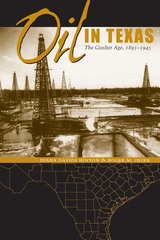 Oil in Texas: The Gusher Age, 1895-1945
By Diana Davids Hinton and Roger M. Olien
University of Texas Press, 2002 As the twentieth century began, oil in Texas was easy to find, but the quantities were too small to attract industrial capital and production. Then, on January 10, 1901, the Spindletop gusher blew in. Over the next fifty years, oil transformed Texas, creating a booming economy that built cities, attracted out-of-state workers and companies, funded schools and universities, and generated wealth that raised the overall standard of living—even for blue-collar workers. No other twentieth-century development had a more profound effect upon the state. In this book, Roger M. Olien and Diana Davids Hinton chronicle the explosive growth of the Texas oil industry from the first commercial production at Corsicana in the 1890s through the vital role of Texas oil in World War II. Using both archival records and oral histories, they follow the wildcatters and the gushers as the oil industry spread into almost every region of the state. The authors trace the development of many branches of the petroleum industry—pipelines, refining, petrochemicals, and natural gas. They also explore how overproduction and volatile prices led to increasing regulation and gave broad regulatory powers to the Texas Railroad Commission.
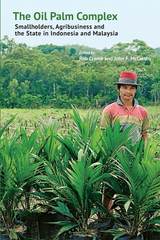 The Oil Palm Complex: Smallholders, Agribusiness and the State in Indonesia and Malaysia
Edited by Robert Cramb and John F. McCarthy
National University of Singapore Press, 2016 The oil palm industry has transformed rural livelihoods and landscapes across wide swathes of Indonesia and Malaysia, generating wealth along with economic, social, and environmental controversy. Who benefits and who loses from oil palm development? Can oil palm development provide a basis for inclusive and sustainable rural development?
Based on detailed studies of specific communities and plantations and an analysis of the regional political economy of oil palm, this book unpicks the dominant policy narratives, business strategies, models of land acquisition, and labour-processes. It presents the oil palm industry in Malaysia and Indonesia as a complex system in which land, labour and capital are closely interconnected. Understanding this complex is a prerequisite to developing better strategies to harness the oil palm boom for a more equitable and sustainable pattern of rural development.
Oil Spills
Joanna Burger
Rutgers University Press, 1997 Oil Spills is the first book to survey the history of oil spills, the problems they create, the types of clean-ups and their efficacy, the legal, social, economic, and ecological consequences of oil spills, their long-term impacts on the wildlife and people who survive them, and the alternatives to oil and its transport. Biologist Joanna Burger writes clearly and accessibly both about the catastrophic oil spills that capture the headlines and the small chronic pipeline leaks that we rarely hear about. Oil Spills is essential reading for everyone concerned with environmental issues and energy policy.
 Oil, the State, and War: The Foreign Policies of Petrostates
Emma Ashford
Georgetown University Press, 2023 A comprehensive challenge to prevailing understanding of international implications of oil wealth that shows why it can create bad actors In a world where oil-rich states are more likely to start war than their oil-dependent counterparts, it’s surprising how little attention is still paid to these so-called petrostates. These states’ wealth props up the global arms trade, provides diplomatic leverage, and allows them to support violent and nonviolent proxies. In Oil, the State, and War, Emma Ashford explores the many potential links between domestic oil production and foreign policy behavior and how oil production influences global politics. Not all petrostates have the same characteristics or capabilities. To help us conceptualize these differences, Ashford creates an original classification of three types of petrostates: oil-dependent states (those weakened by the resource curse), oil-wealthy states (those made rich by oil exports), and super-producer states (those that form the backbone of the global oil market). Through a combination of case studies and analysis, she illustrates how oil shapes petrostates’ behavior, filling a major gap in our understanding of the international implications of oil wealth. Experts have too often treated oil-rich states as passive objects, subject to the energy security needs of Western importing states. Instead, this book highlights the agency and power enjoyed by petrostates. As the oil market undergoes a period of rapid change, Oil, the State, and War sheds light on the diversity of petrostates and how they shape international affairs.
 The Ojibwa of Western Canada 1780-1870
Laura Peers
University of Manitoba Press, 1994 Among the most dynamic Aboriginal peoples in western Canada today are the Ojibwa, who have played an especially vital role in the development of an Aboriginal political voice at both levels of government. Yet, they are relative newcomers to the region, occupying the parkland and prairies only since the end of the 18th century. This work traces the origins of the western Ojibwa, their adaptations to the West, and the ways in which they have coped with the many challenges they faced in the first century of their history in that region, between 1780 and 1870.
The western Ojibwa are descendants of Ojibwa who migrated from around the Great Lakes in the late 18th century. This was an era of dramatic change. Between 1780 and 1870, they survived waves of epidemic disease, the rise and decline of the fur trade, the depletion of game, the founding of non-Native settlement, the loss of tribal lands, and the government's assertion of political control over them. As a people who emerged, adapted, and survived in a climate of change, the western Ojibwa demonstrate both the effects of historic forces that acted upon Native peoples, and the spirit, determination, and adaptive strategies that the Native people have used to cope with those forces. This study examines the emergence of the western Ojibwa within this context, seeing both the cultural changes that they chose to make and the continuity within their culture as responses to historical pressures.
The Ojibwa of Western Canada differs from earlier works by focussing closely on the details of western Ojibwa history in the crucial century of their emergence. It is based on documents to which pioneering scholars did not have access, including fur traders' and missionaries' journals, letters, and reminiscences. Ethnographic and archaeological data, and the evidence of material culture and photographic and art images, are also examined in this well-researched and clearly written history.
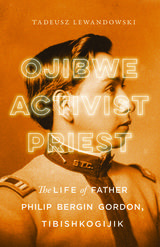 Ojibwe, Activist, Priest: The Life of Father Philip Bergin Gordon, Tibishkogijik
Tadeusz Lewandowski
University of Wisconsin Press, 2019 Born in Wisconsin, Philip Bergin Gordon—whose Ojibwe name Tibishkogijik is said to mean Looking into the Sky—became one of the first Native Americans to be ordained as a Catholic priest in the United States. Gordon's devotion to Catholicism was matched only by his dedication to the protection of his people. A notable Native rights activist, his bold efforts to expose poverty and corruption on reservations and his reputation for agitation earned him the nickname "Wisconsin's Fighting Priest."
Drawing on previously unexplored materials, Tadeusz Lewandowski paints a portrait of a contentious life. Ojibwe, Activist, Priest examines Gordon's efforts to abolish the Bureau of Indian Affairs, his membership in the Society of American Indians, and his dismissal from his Ojibwe parish and exile to a tiny community where he'd be less likely to stir up controversy. Lewandowski illuminates a significant chapter in the struggle for Native American rights through the views and experiences of a key Native progressive.
 Ojo en Celo / Eye in Heat: Poems
Margarita Pintado Burgos; Translated by Alejandra Quintana Arocho
University of Arizona Press, 2024 Winner of the 2023 Ambroggio Prize of the Academy of American Poets
Aflame with desire, the eye conjures, dreams, invents itself, sees what it wants. The eye sees what it is able to see.
Ojo en celo / Eye in Heat brings into sharp relief the limits of our gaze. It shows us what it is to escape the mirror and move beyond mirages. Margarita Pintado Burgos invites us to ponder the impasse while showing us ways to see better, to break the habit of lying, and to confront images along with language.
With devastating clarity, Pintado Burgos’s poems, presented in both Spanish and English, give voice to the world within and beyond sight: the plants, the trees, the birds, the ocean waves, the fruit forgotten in the kitchen, the house’s furniture. Light takes on new dimensions to expose, manipulate, destroy, and nourish. Alejandra Quintana Arocho’s sensitive English translation renders the stark force of these poems without smoothing over the language of the original.
This collection is for anyone who has felt the weight of beauty that remains hidden. It is for those who have left behind a mother, a father, a country. It is for those who know that there is no way out of the poem, for those who have had to live off a house of words and need that house to be as real as possible. Pintado Burgos writes as a woman, exile, daughter, sister, lover, and artist empowered by the restorative potential of the creative phenomenon.
|
|

